Trip Experiences for the 11 Day Extensive Biblical Greece Tour, with Ephesus! (Optional 4 Day extension in Turkey!)
October 4-14, 2025
Downloads:

"Life transforming Israel tours & teaching in the context of the land of the Bible"
Group Photos
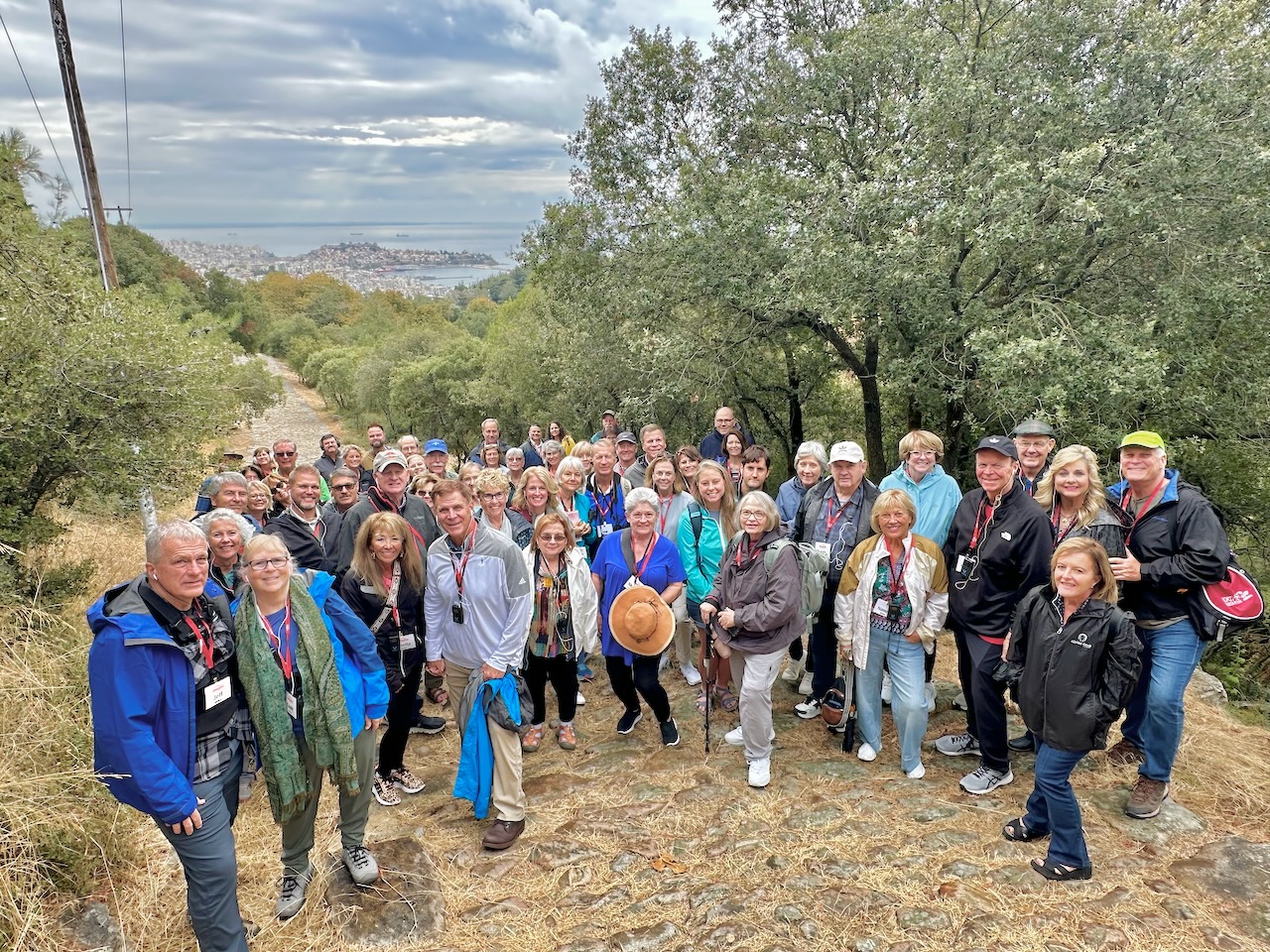
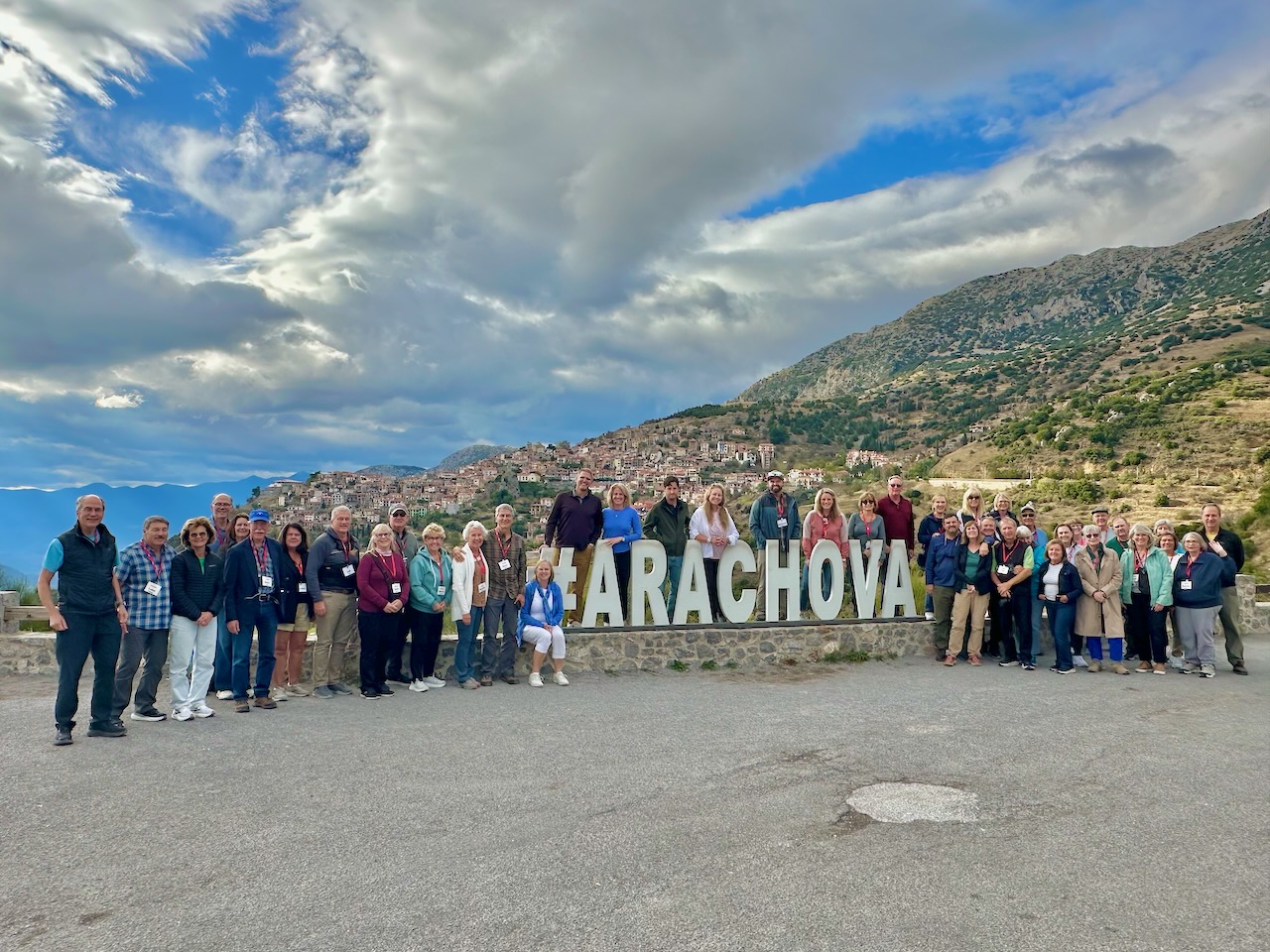
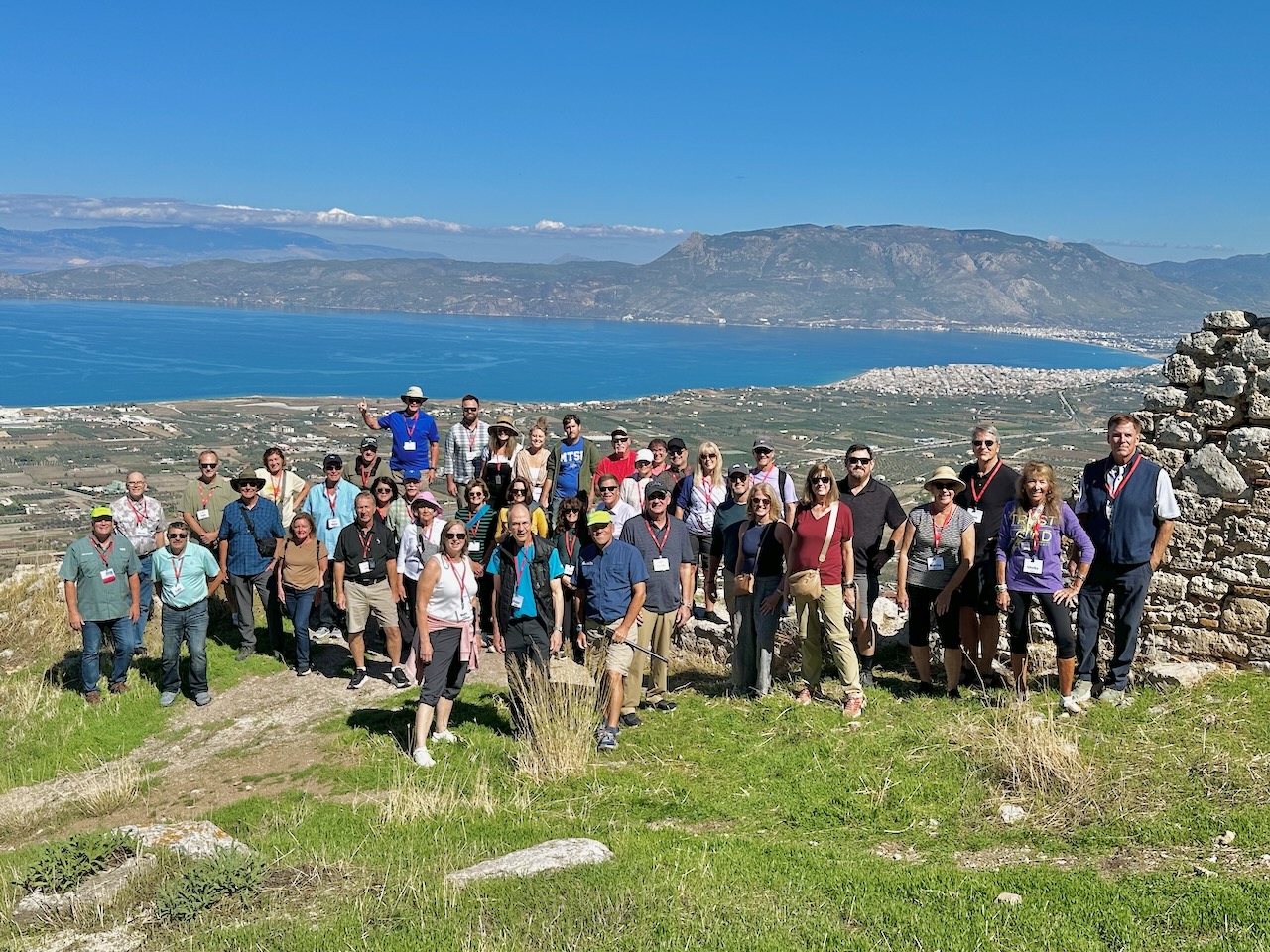


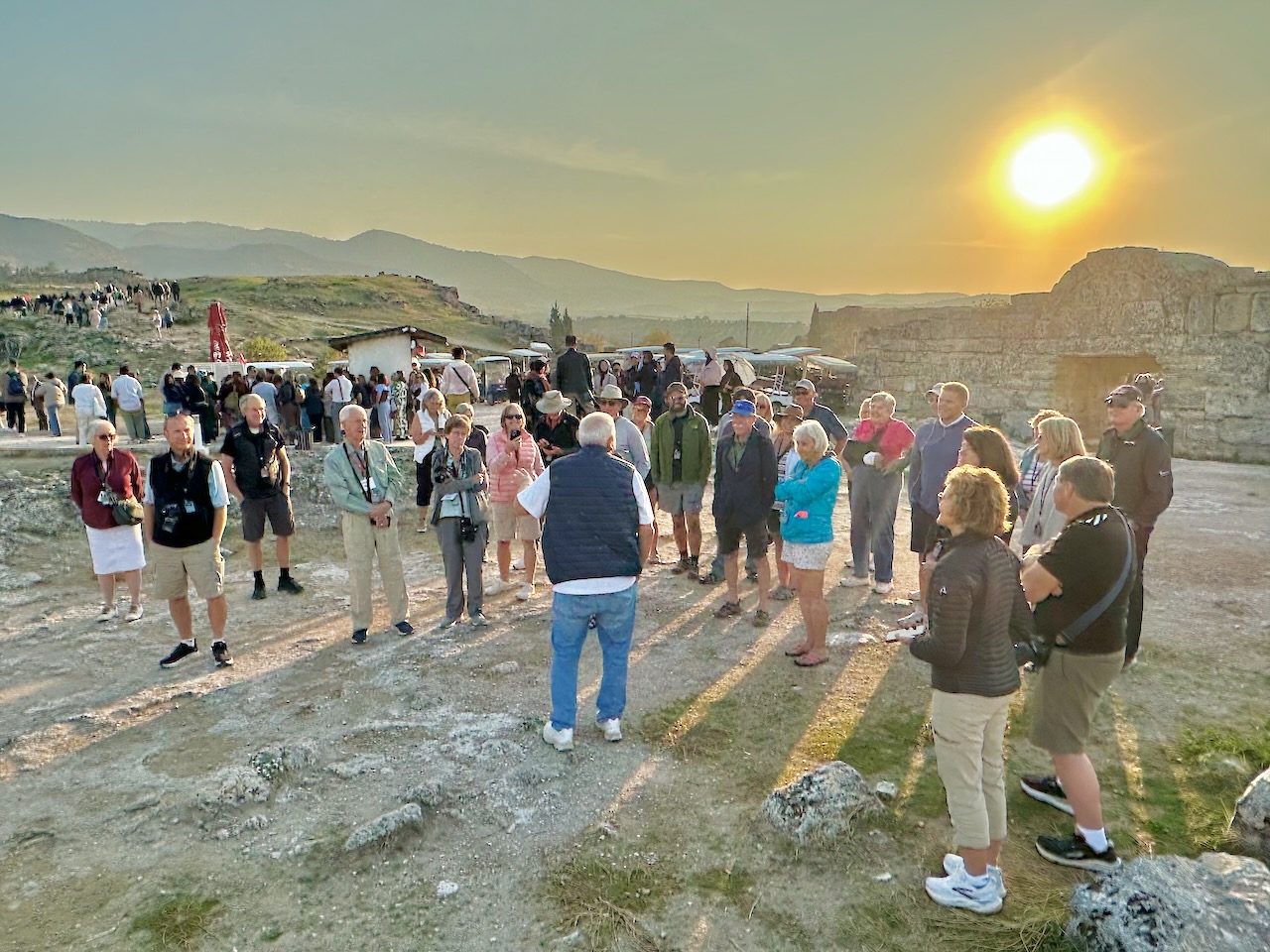
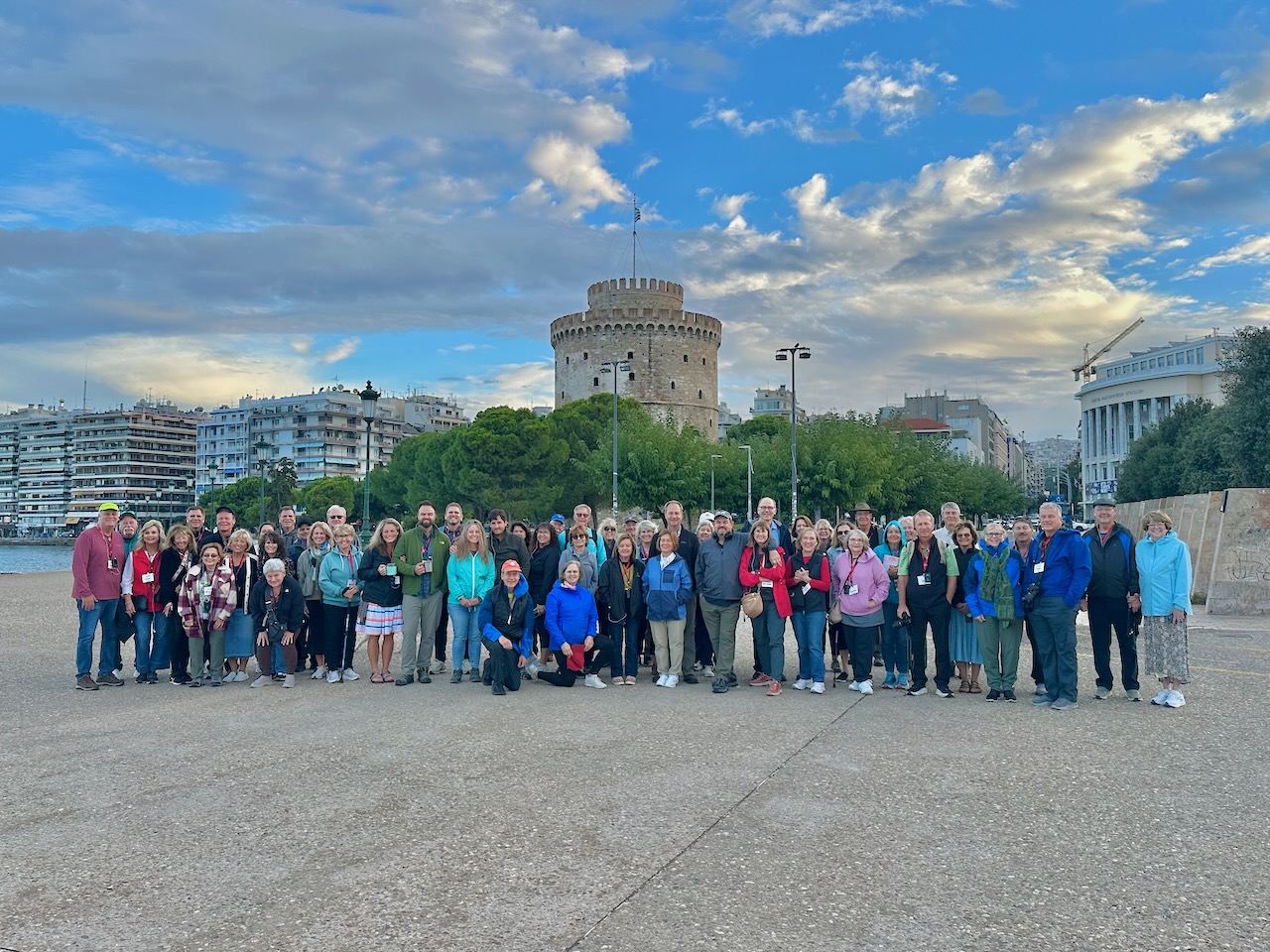
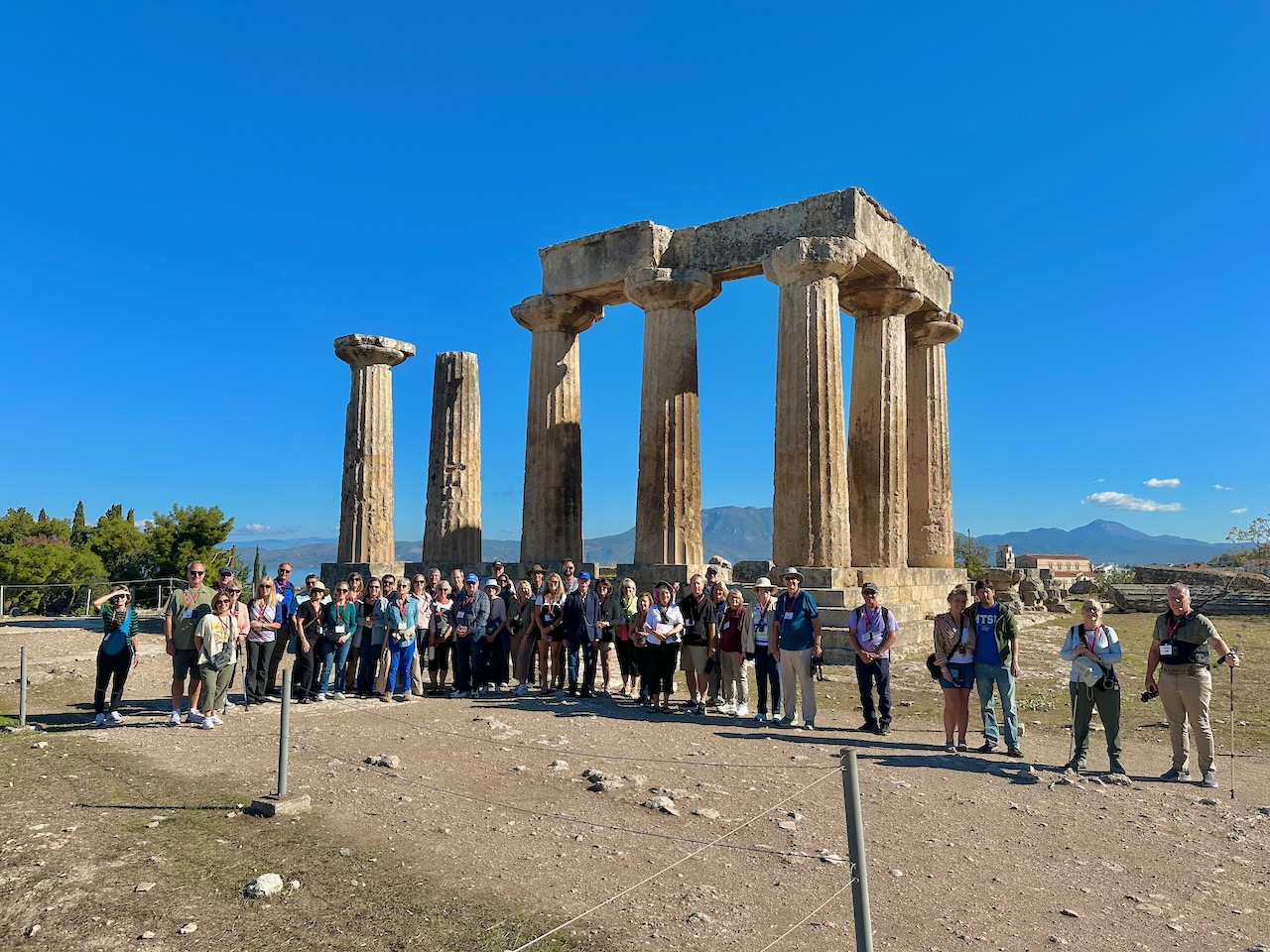
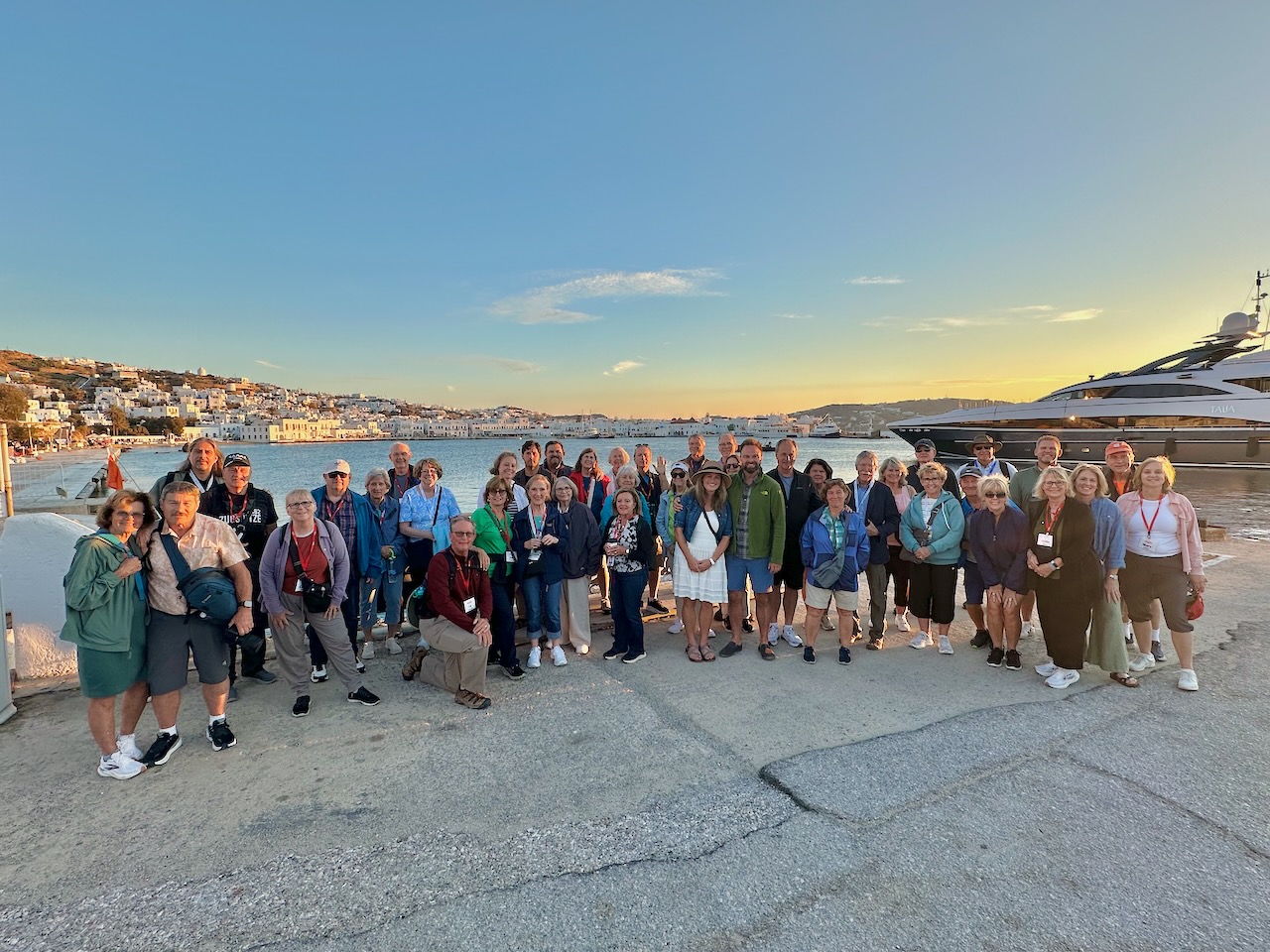
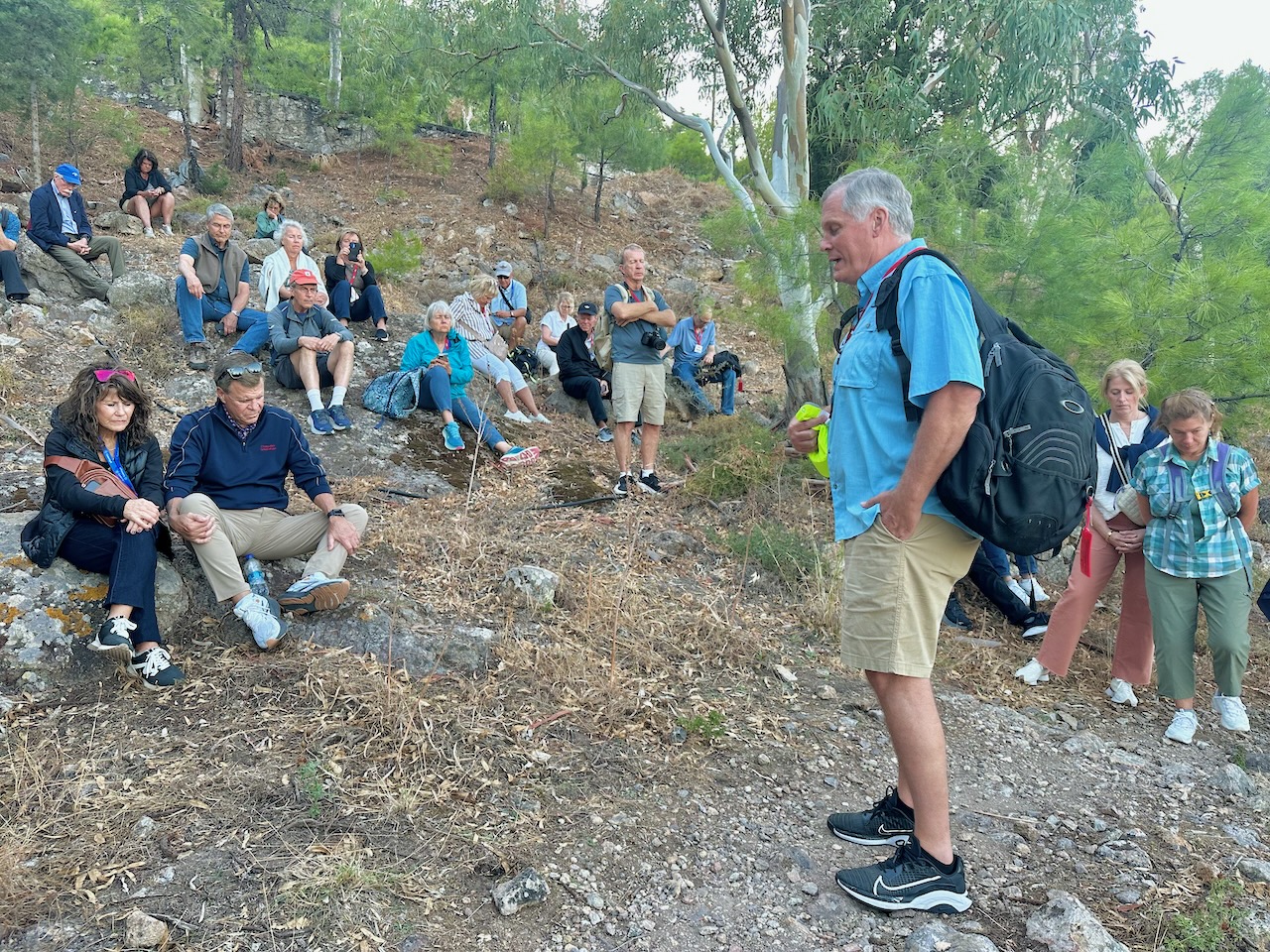
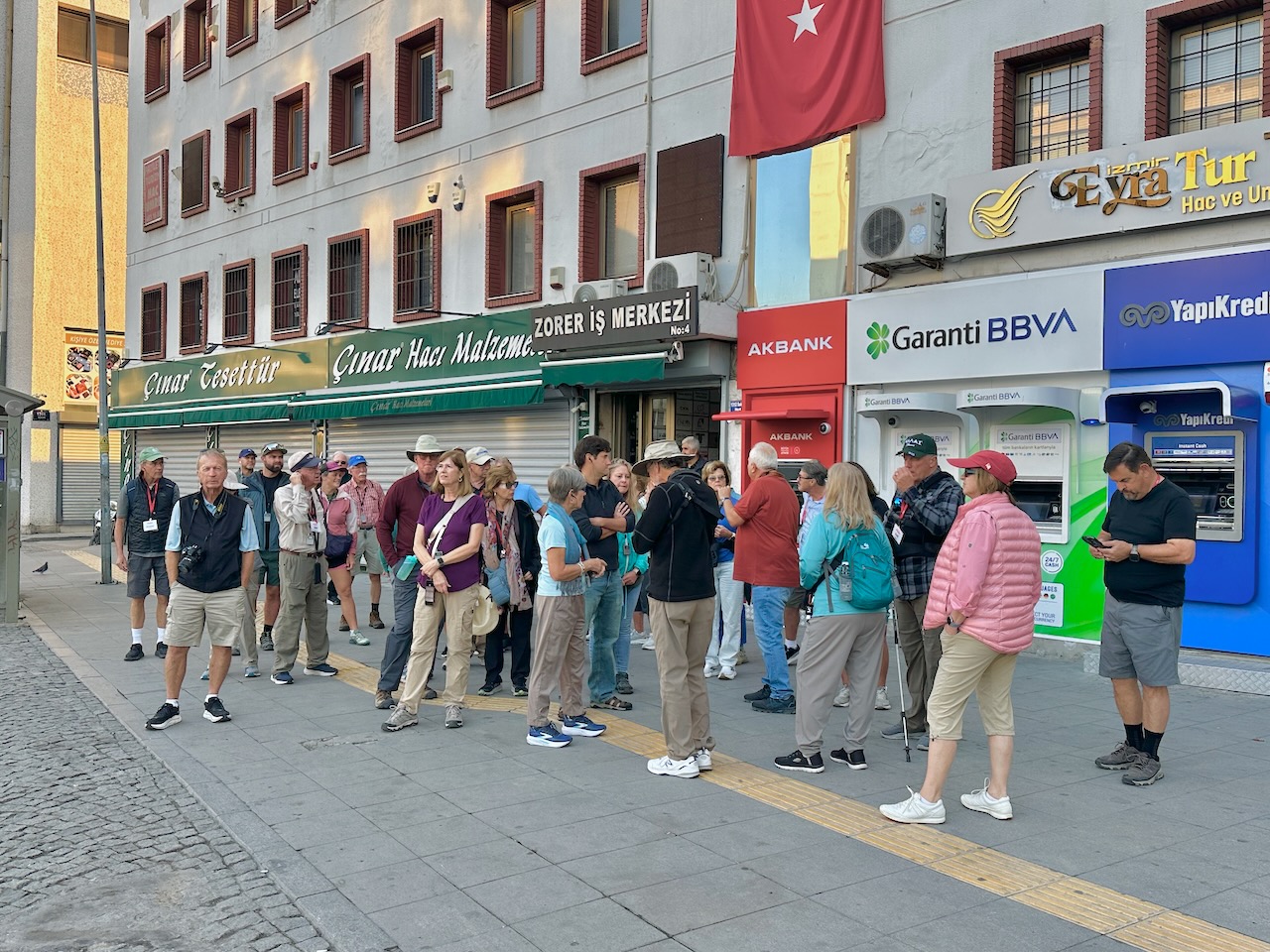


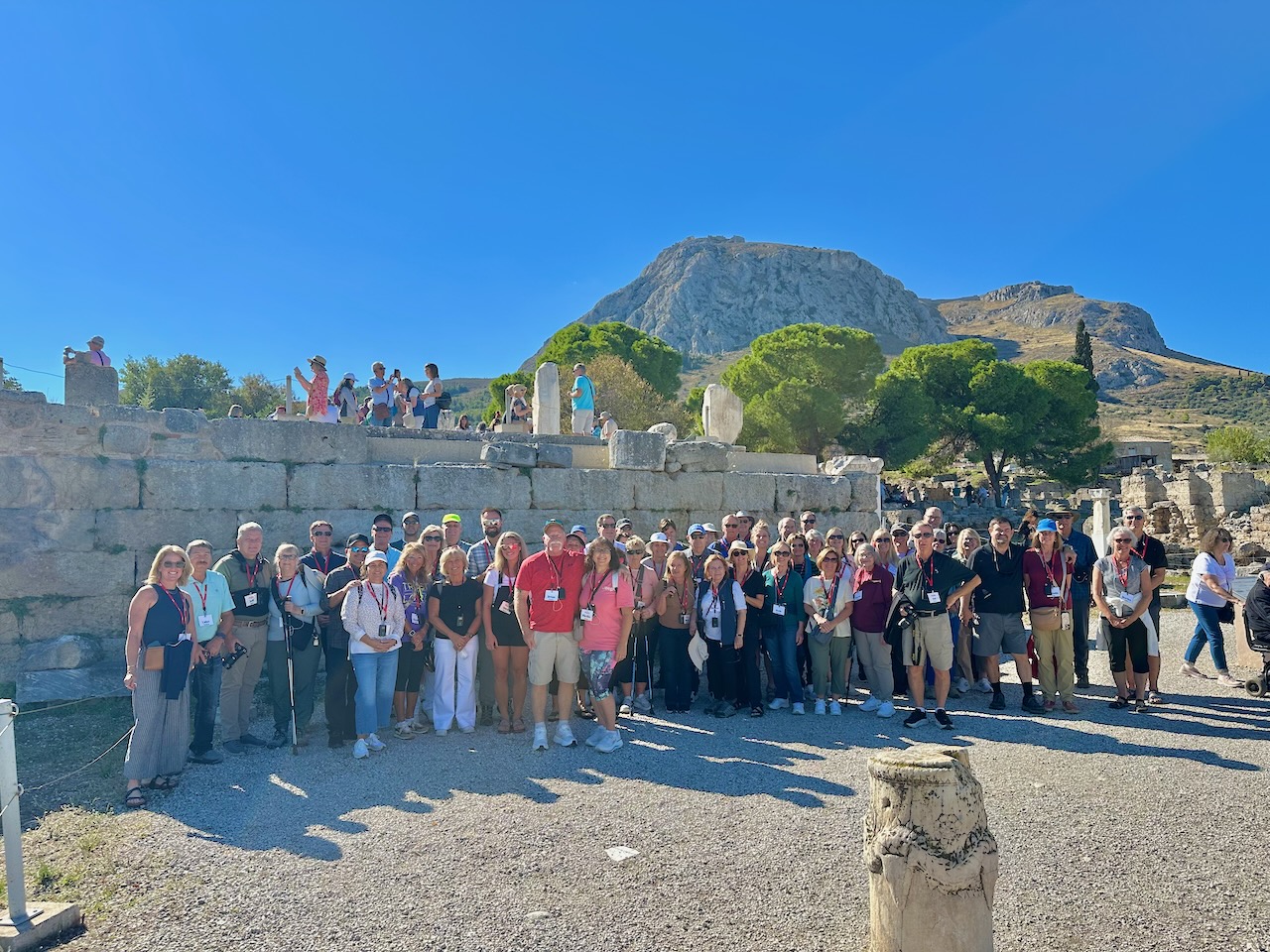

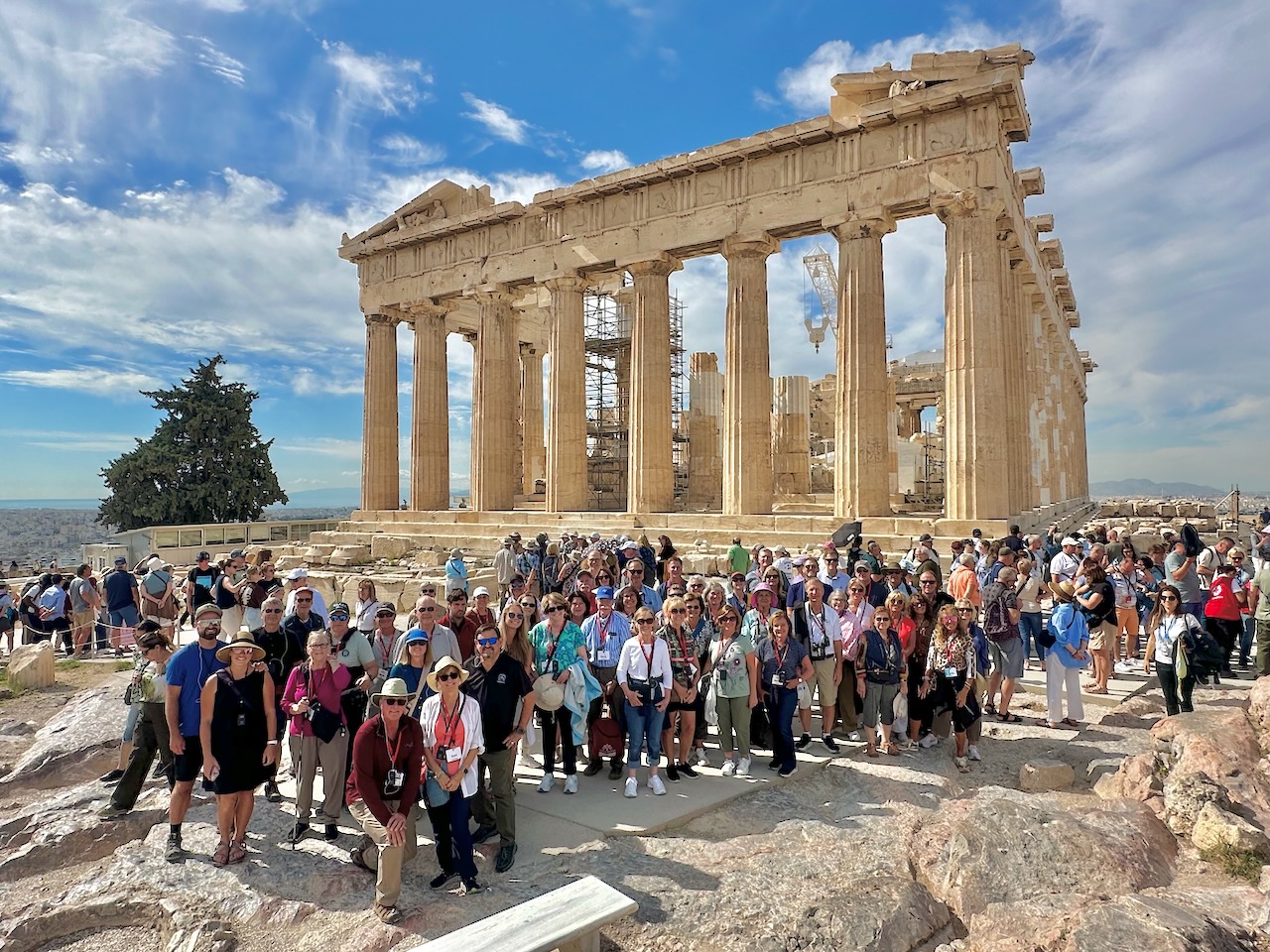
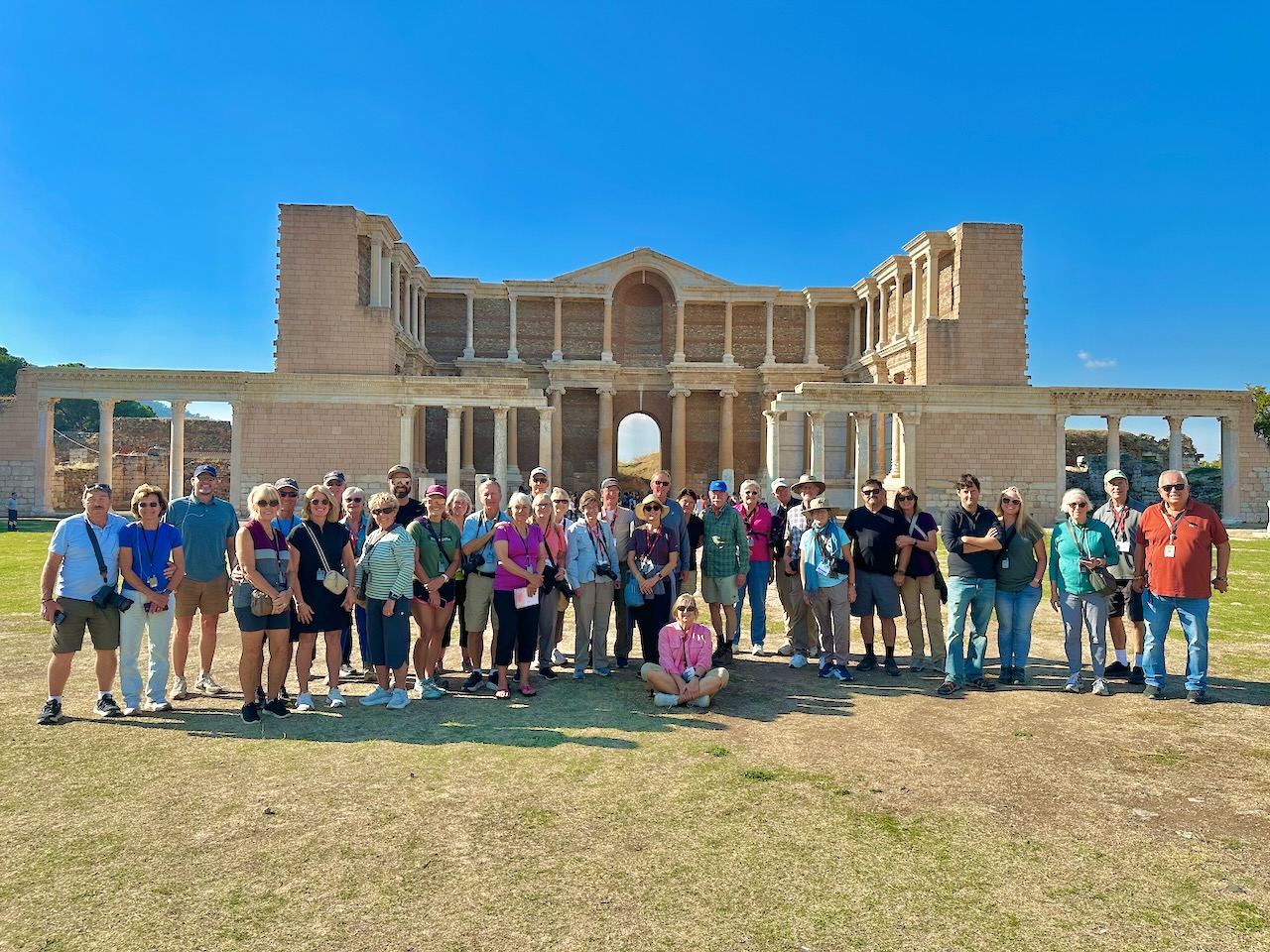
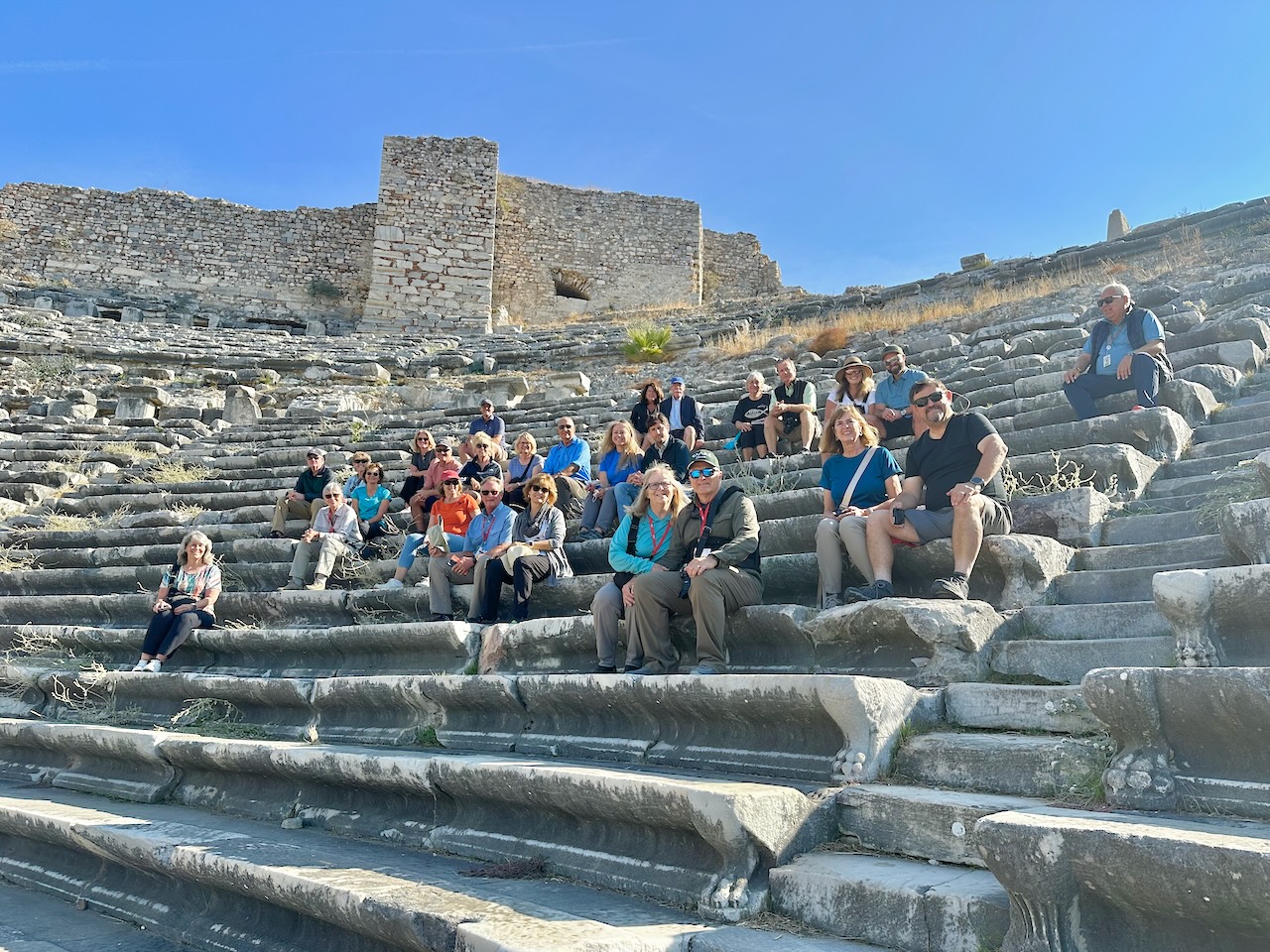
360 Photos
GREECE & TURKEY TOUR EXPERIENCES
Days 1 & 2 – Saturday-Sunday, October 4-5: Departure US, Arrival Thessaloniki, Greece
The day of departure finally came! God inspired a total of 57 (unfortunately four signed up could not make had to cancel last minute) for this “Footsteps of Paul” Biblical journey in Greece trip (with an optional extension to Turkey). Using various flights and with a number of “land only” travelers, the group arrived in Thessaloniki (ancient Thessalonica) at various times throughout the day. It was a sunny day, with highs in the 60s. About half the group arrived at the hotel tonight after dinner. We are here for two nights. We are all ready to begin this trip which retraces the Apostle Paul’s ministry and mission.



Day 3 – Monday, October 6: Kavala, Philippi, Amphipolis, Thessaloniki
Today was our first full day here in Greece. The weather was overcast, with spotty light showers in there morning. A steadier light rain fell while at Philippi, but the rain stopped towards the end of the day. High temps were in the low 60s. We left the hotel shortly at 7:45 a.m. following a great breakfast. We read from portions of Philippians 1 through 4 as we headed north and east for the day.
Kavala/Neopolis
We drove north and east on one of Greece’s very nice highways. Following a brief restroom stop, and continued north to Neopolis in Paul’s day (Kavala today). Paul sailed into this port following his Macedonian vision at Troas (Acts 16). We all walked in the Via Egnatia, and ancient road that Paul would have used between Nepalis and Philippi. Today, only the Byzantine (and later Turkish-Ottoman) aqueduct and fortress can been seen archaeologically. Outside a Greek Orthodox Church a modern monument is erected honoring Paul’s journey here. We also saw the tall-standing aqueduct before landing back on the bus.
Philippi
We drove about 10 miles to the site of Philippi. First, we visited the Zygaktes River located outside the city. It was somewhere along here where Lydia (from Thyatira) heard and received the kingdom message of Christ from Paul and Silas (Acts 16). She and her household also received Christ and were baptized. Paul also confronted a Pythia, or fortune teller. She may have been one who gave oracles at Delphi (we will visit this site in two days).
We drove a short distance to the archaeological site of Philippi. Following a tasty lunch we visited the ruins of the city connected with Paul. We saw the theater, the Late Roman basilicas, the forum (marketplace), and the Praetorium – Bouleuteriun (judgement hall, the most likely place of Paul and Silas’ imprisonment). We read from Acts 16 about God’s miraculous intervention on behalf of Paul and Silas. The jailor placed his faith in Christ that night too. The so-called “traditional “ prison of Paul is a later 2nd century structure and used as a cistern. This was another example of the difference Paul made for the kingdom of God! He was bold in sharing his faith.
Amphipolis
Leaving Philippi, we began our drive back to Thessaloniki. On the way we stopped at Amphipolis. The city was established in the 4th century BC and was visited (or at least past) by Paul (Acts 17). We saw the famous lion statue here from the 4th century BC.
Downtown Thessaloniki
From continued our drive back to Thessaloniki. Before we arrived back at the hotel, we drove to the Roman Forum (Agora, marketplace) in the heart of the city. This was the marketplace mentioned in Acts 17 where Paul was. The text mentions a man named Jason who helped Paul and Silas. The text also mentioned the “city officials” (in Greek, Politarchs, as found on an inscription discovered here from the 2nd century AD). We also remembered certain believers mentioned by name (Aristarchus and Secundus) who were from this city (Acts 20:4, Romans 16). They served as later companion travelers with Paul. About one block away we made a brief stop to the Church of St. Demetrius. This was an ancient church dedicated after Demetrius, a martyr who died in 303 AD. Today this well-used Greek Orthodox Church is a landmark in the city.
We returned to our hotel nearby for dinner and a good night’s rest. We leave Thessaloniki tomorrow morning.


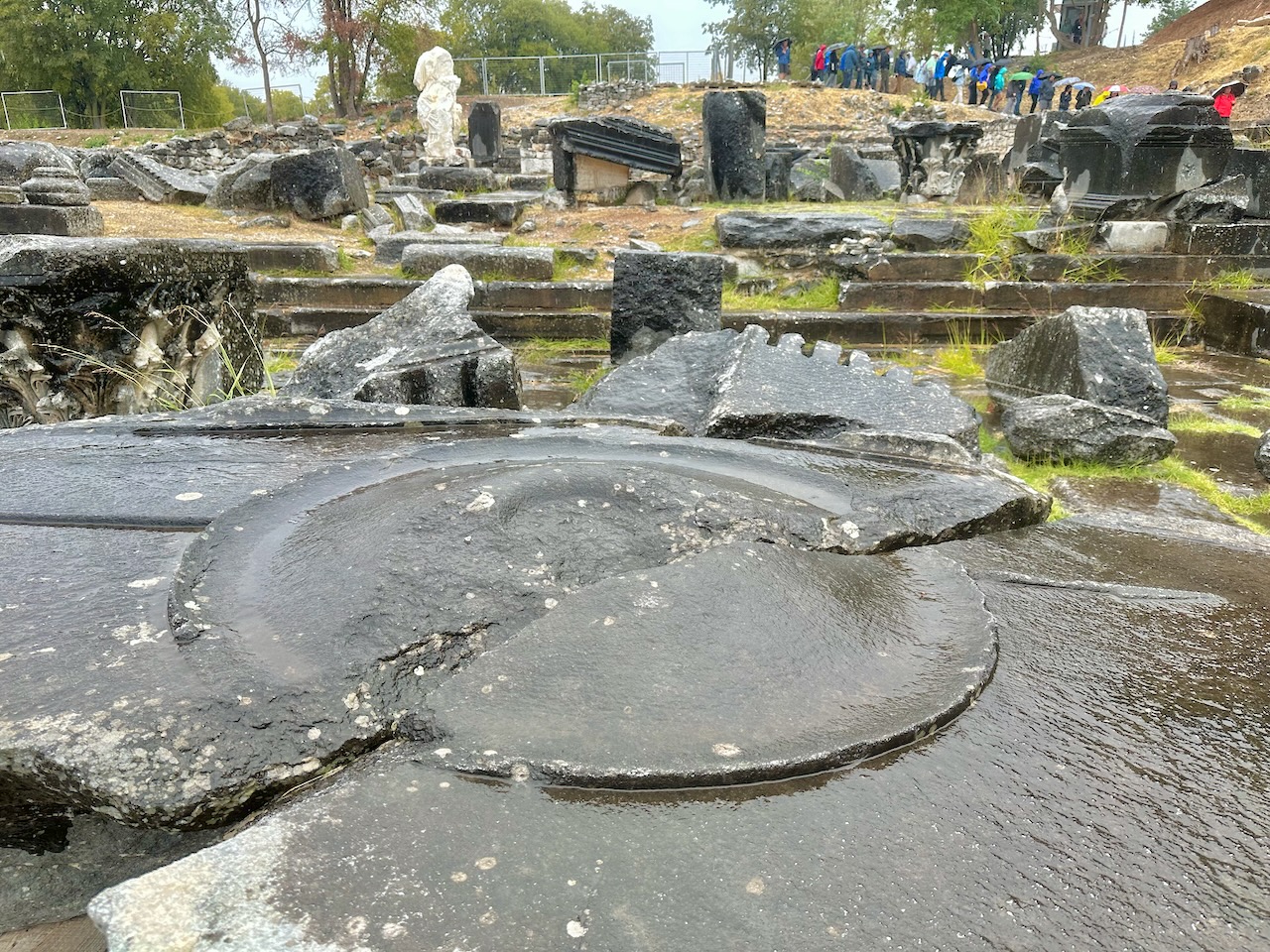
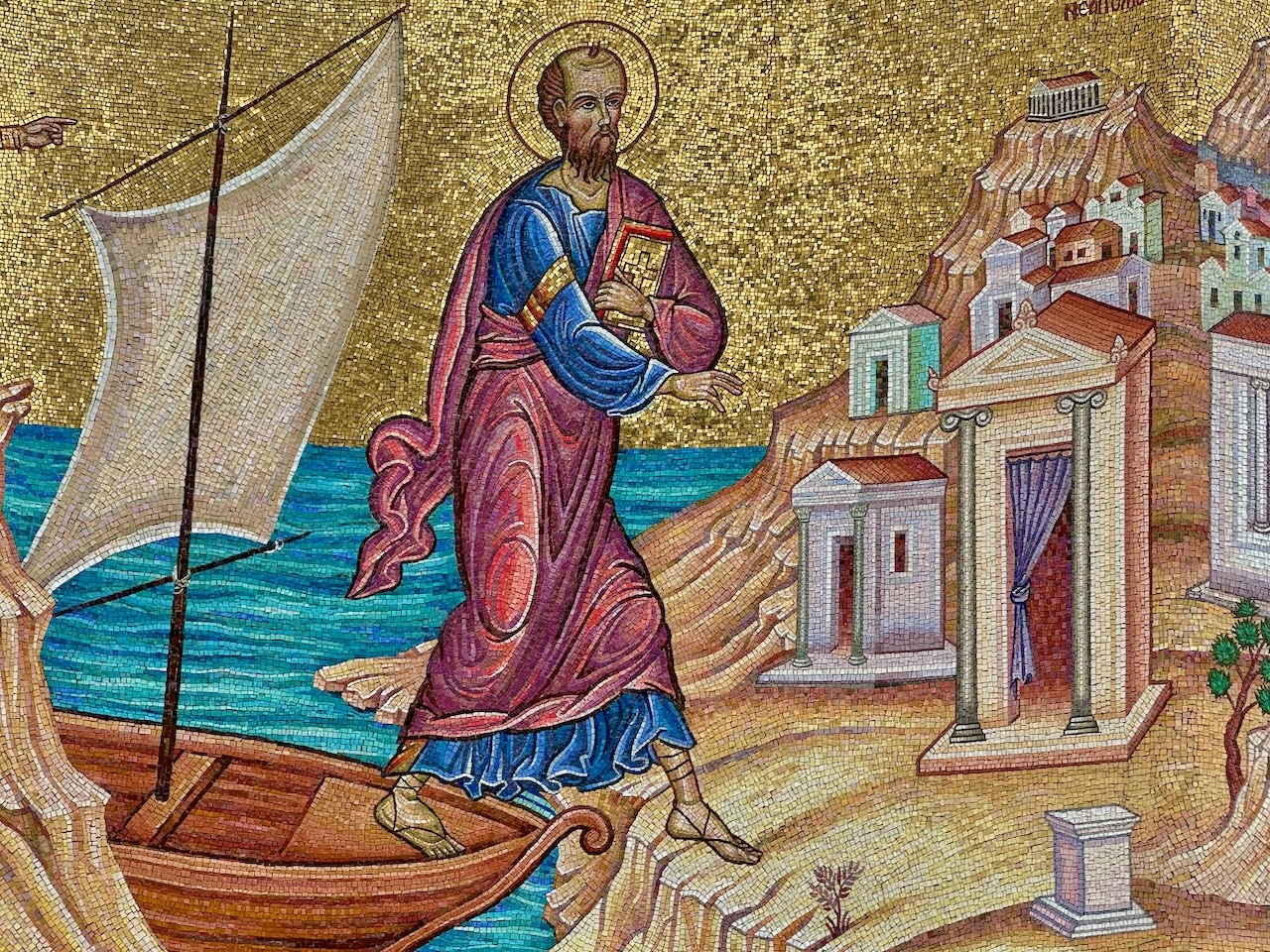

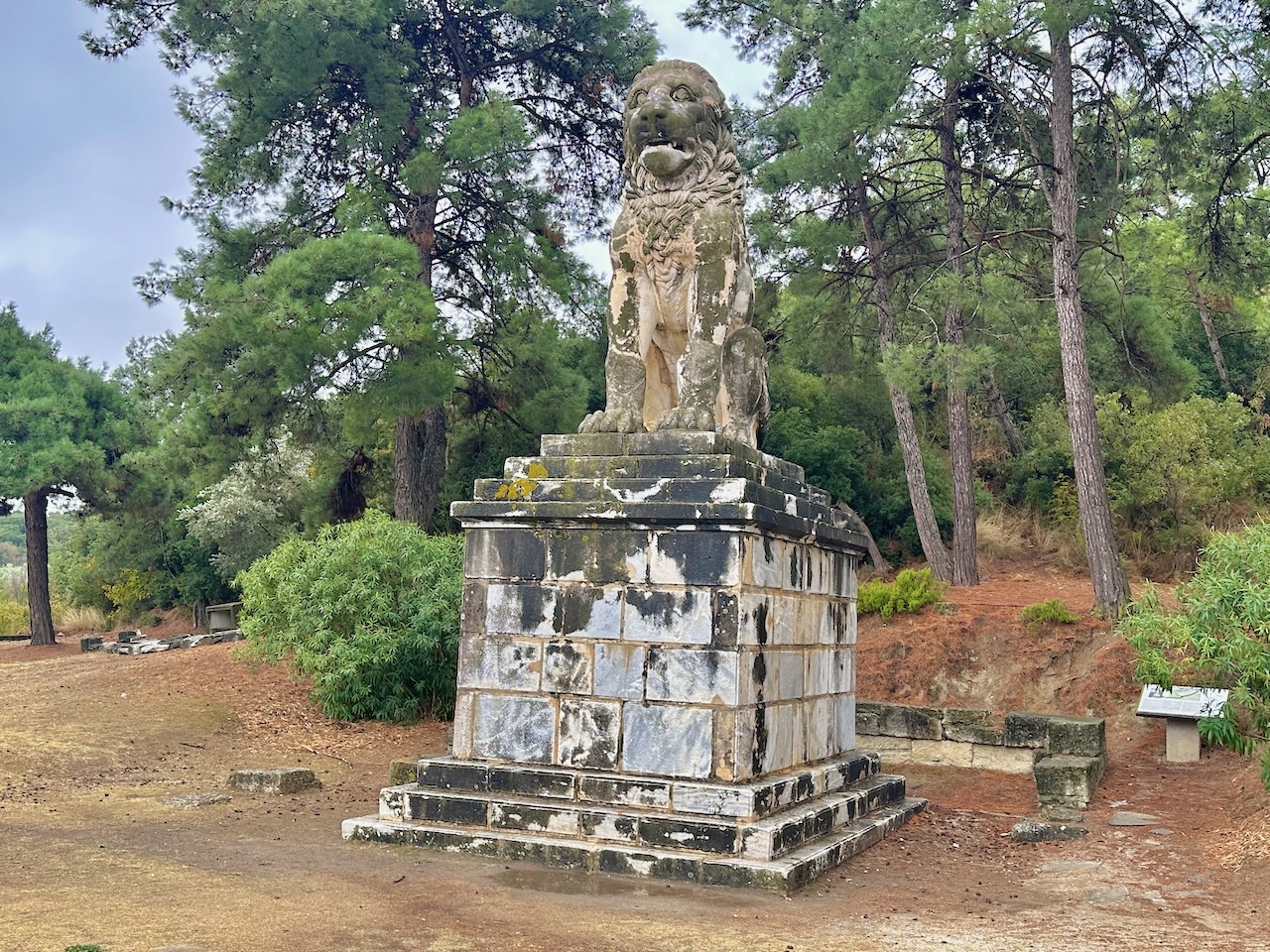

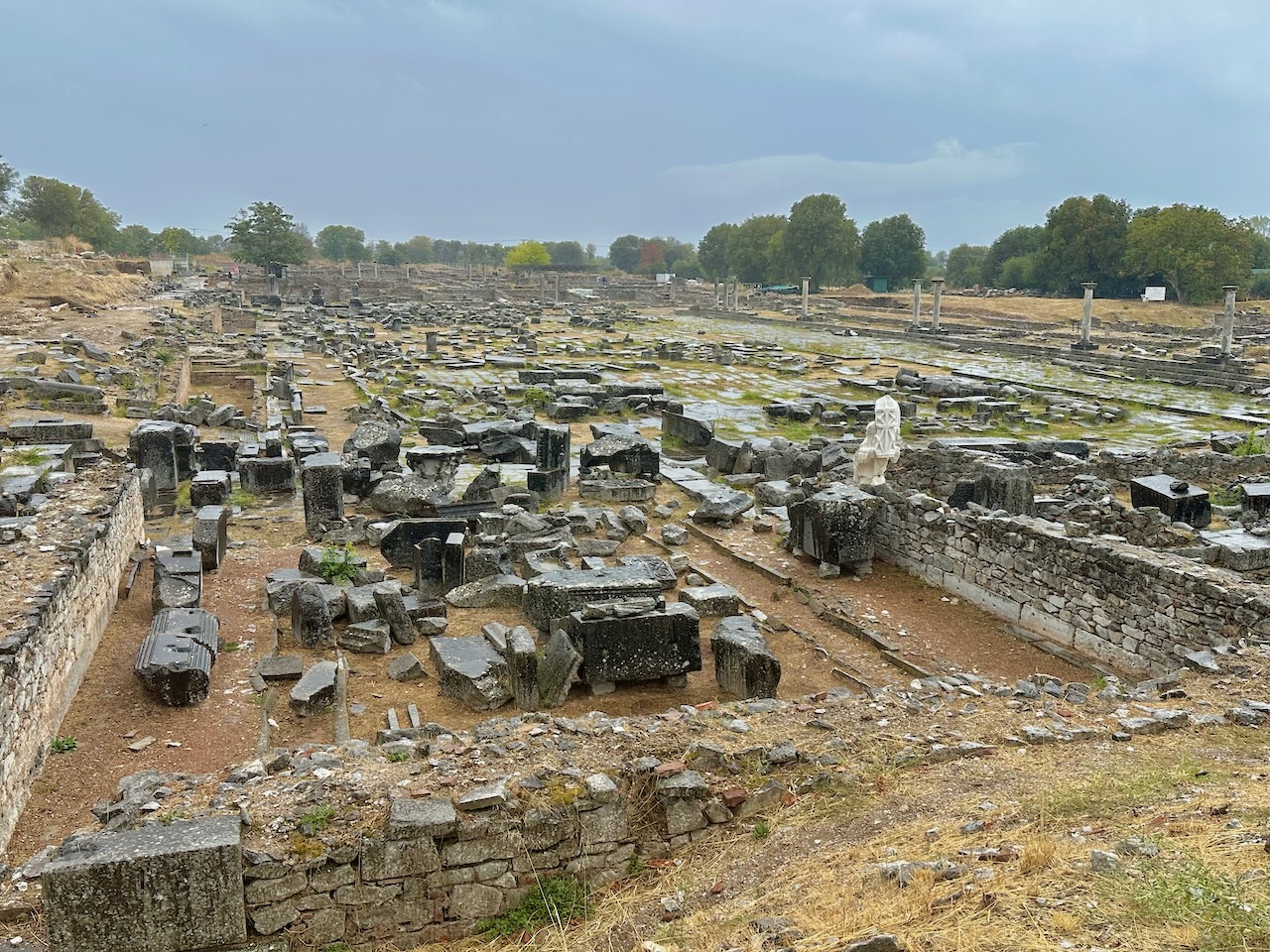
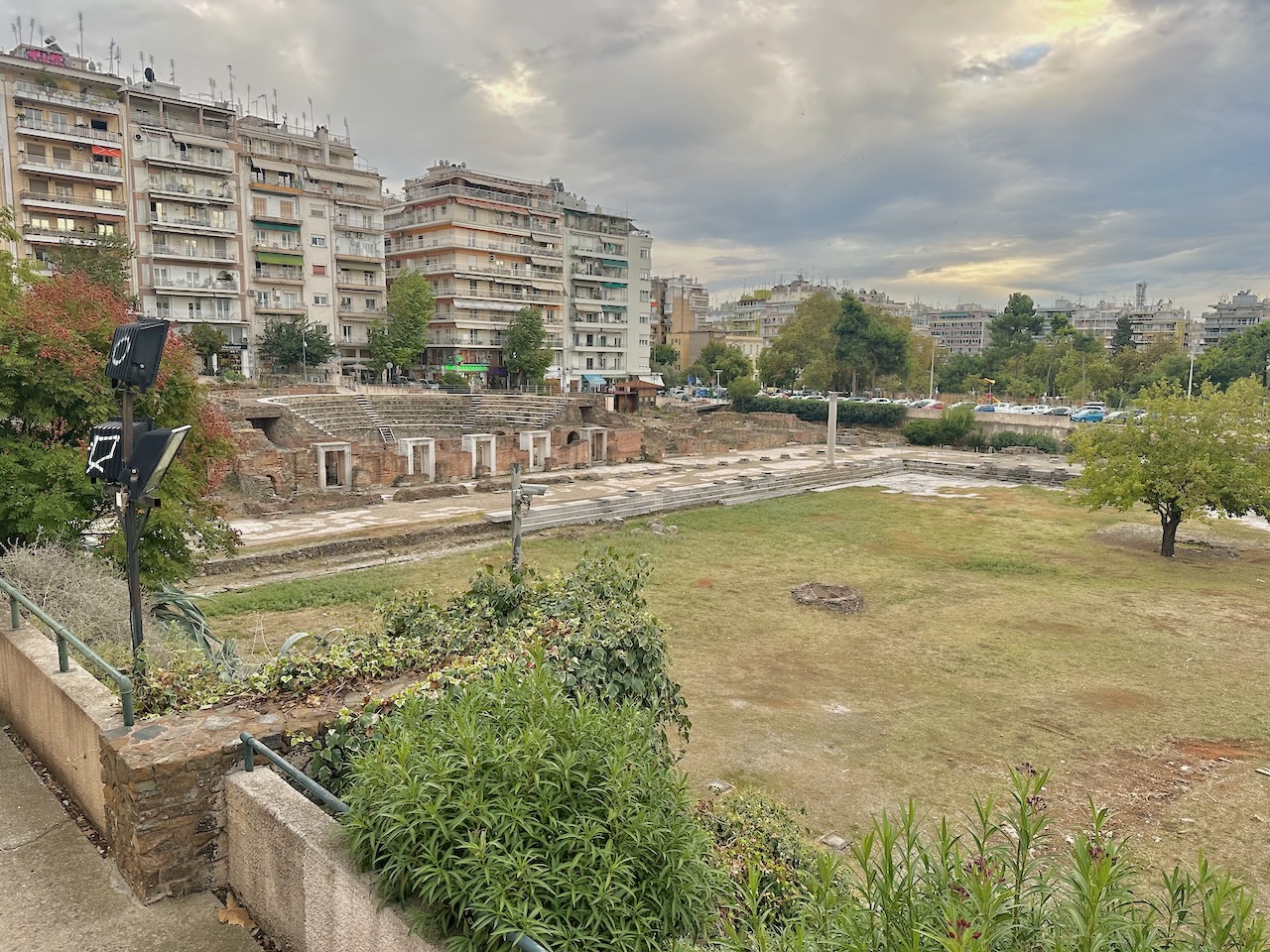
Day 4 – Tuesday, October 7: Thessaloniki, Berea, Vergina, Meteora, Kalambaka
Today was our second full day. We enjoyed another great breakfast before we checked out of our hotel and loaded our bus at 7:30. We were welcomed by another cool morning before it warmed up into the 60s. The skies were partly cloudy, with a few breaks of sun in the afternoon. We read from 1 Thessalonians 1 as we left the hotel at 7:45.
Thessaloniki
We started the morning by driving along the shoreline of the city and to the the White Tower, a 15th century structure (although previously built during the earlier Byzantine Period). This structure was used as a prison during there Ottoman/Turkish period. We also saw an impressive statue of Alexander the Great is also in this area of the coastline of the city. From here, we drove up the hill to see the ancient Late Roman fortress walls at the Acropolis of the city. The view of the city was incredible, the second largest city in Greece today (1.2 million). We read from 1 Thessalonians 2 and 4 (about the return of Jesus as King) as well as portions of 2 Thessalonians 3.
Berea
Driving about 50 minutes south across the agricultural plain from Thessaloniki, we came to Berea. It is called Verea in Greek. While there is no archaeology here to see dating to the time of Paul, we read the Acts 17 passage in front of a small modern monument constructed in the heart of this city. We recalled about how the believers here searched the Scriptures diligently. Sopater, a believer from the city of Berea (as well as Aristarchus and Secundus from nearby Thessalonica) was a new believer who eventually became traveling companion with Paul as well towards the end of his third missionary journey (see Acts 20:4 again). God transformed and called others to join Paul in ministry!
Vergina
About 20 minutes away is Vergina. We first e joyed a very Greek lunch at a classic restaurant before we walked to the archaeological ruins of the royal tombs of Macedonians. Discovered in 1977, these tombs were quite impressive! While there are actually four tombs to see here, the tombs of Philip II (the father of Alexander the Great) and Alexander IV (or the “Prince,” perhaps the son of Alexander II) are amazingly well preserved even after more than 2,300 years! These two tombs were found intact. In the museum we also saw many of the items found in these tombs, including many incredible gold pieces, armory and weaponry of Philip II, among other personal items.
Meteora/Kalambaka
Following our visit of there royal tombs, we continued our scenic drive south to Kalambaka. This is the heart of the country of Greece. We traversed up and over the Pindos mountain range. At about 5 p.m., we arrived to the area of Meteora. Six Greek monasteries are still active here (of a total of 24), the earliest dating back to the early 1,300’s. We entered the monastery of St. Stephen’s. Aliki and Sofia took us into the chapel area. Monks (and Sisters) for 100s of years have dedicated their lives in carefully building these with such precision. To see this “perched” monastery was stunning. Upon leaving the one called St. Stephen’s, we drove to another panoramic view of the these monasteries and the city of Kalambaka far below. After checking in to our hotel, we enjoyed a great buffet dinner once again (with a very nice chocolate soufflé) and a free evening!
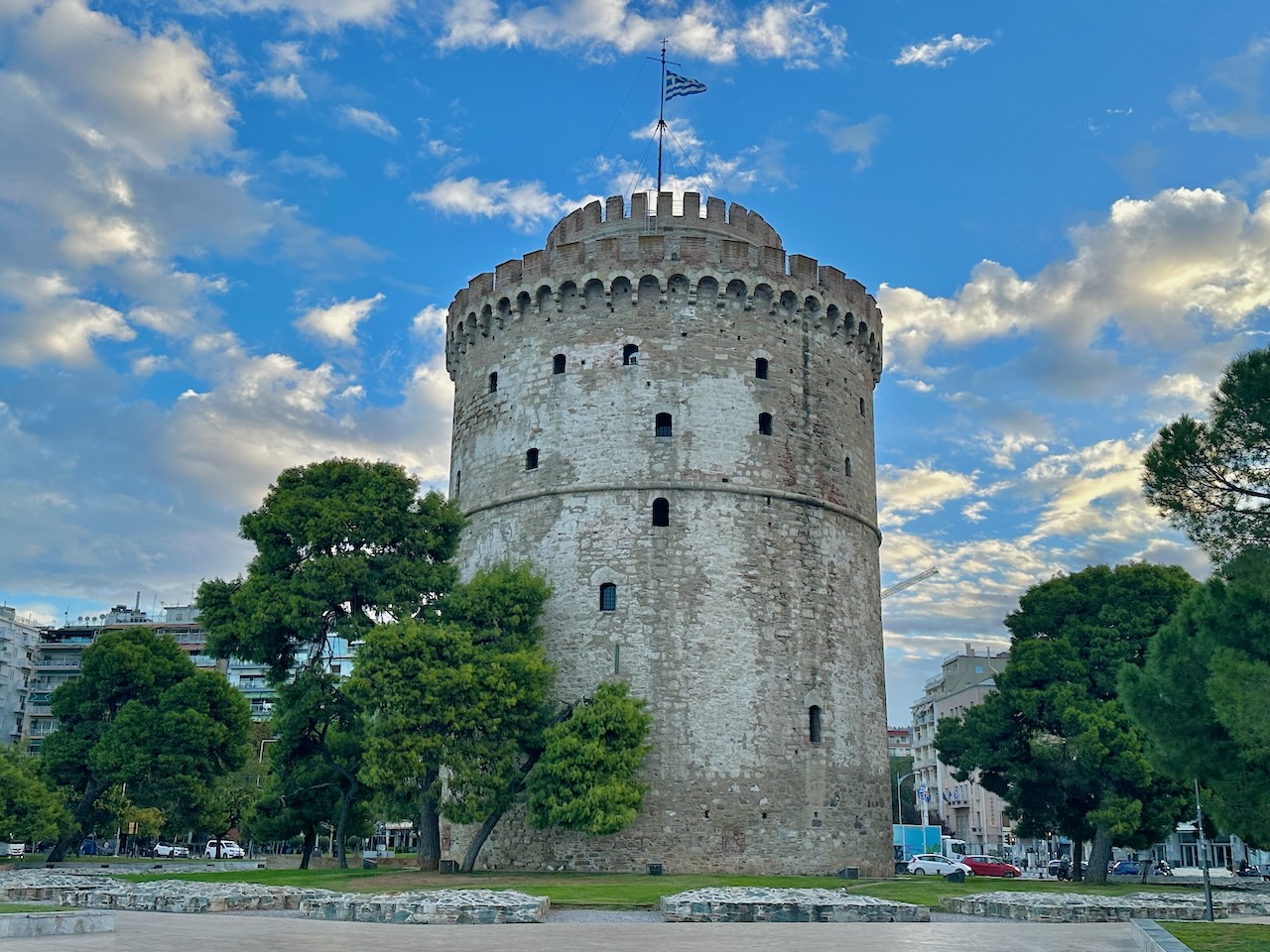
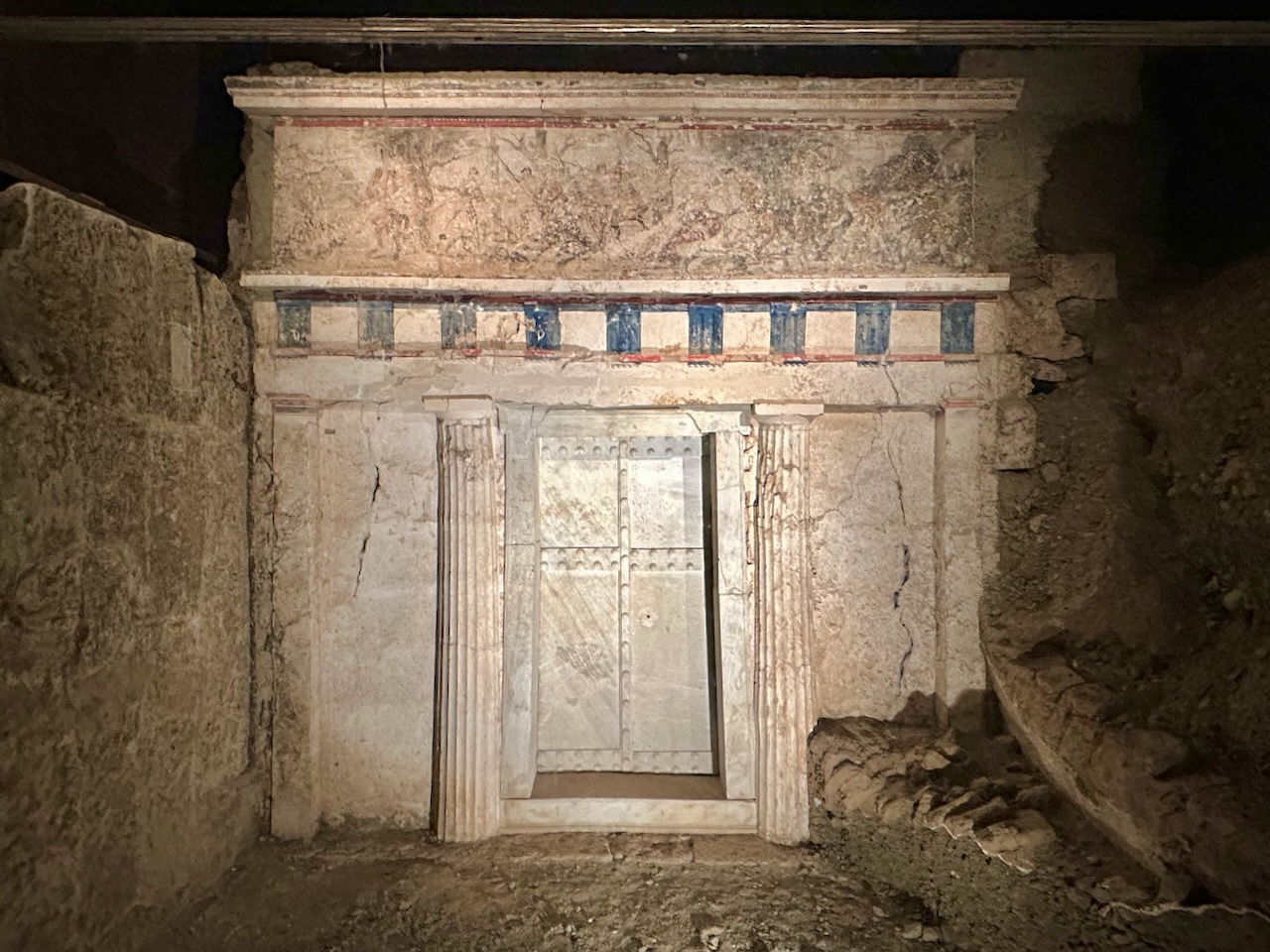
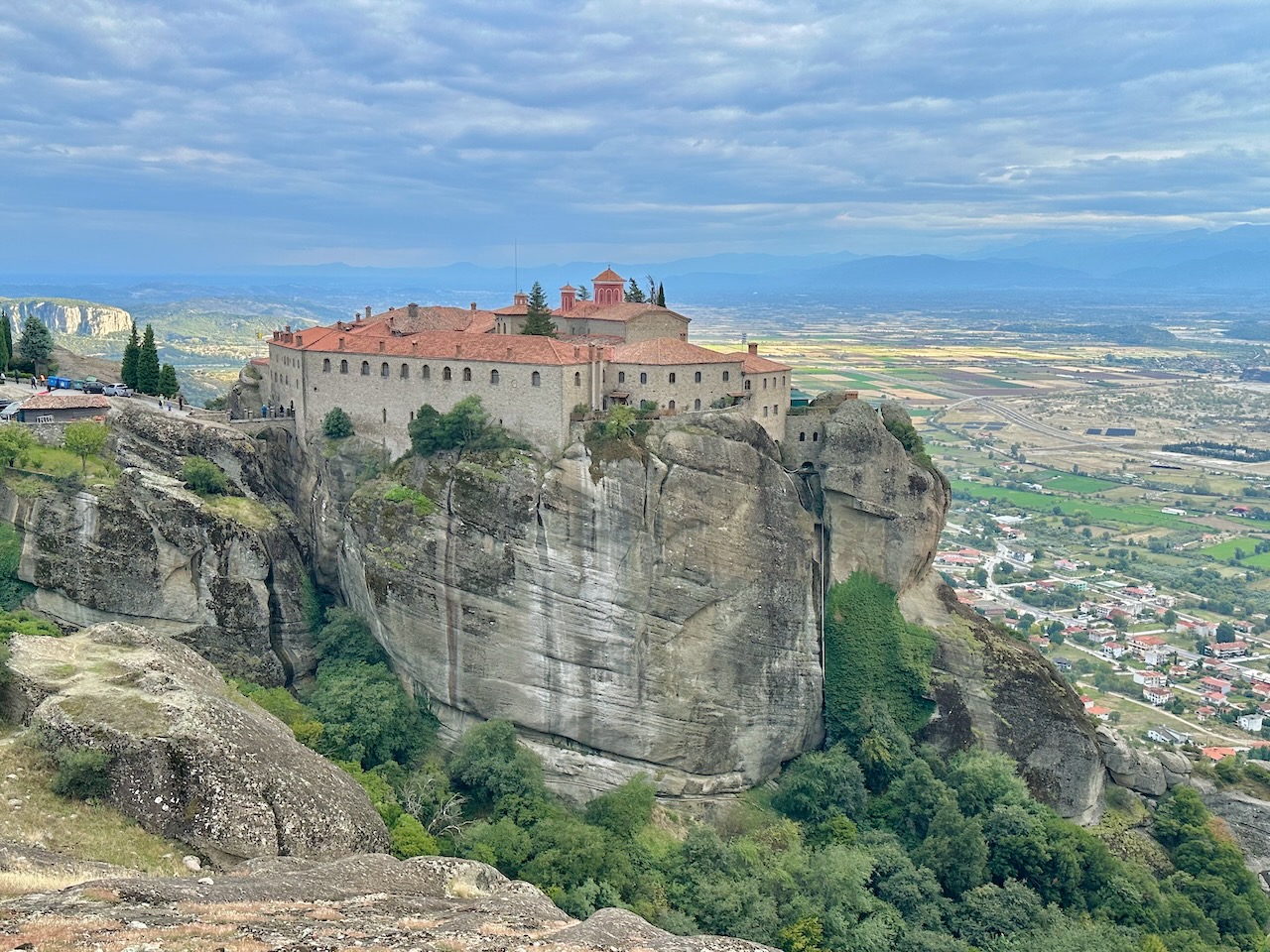
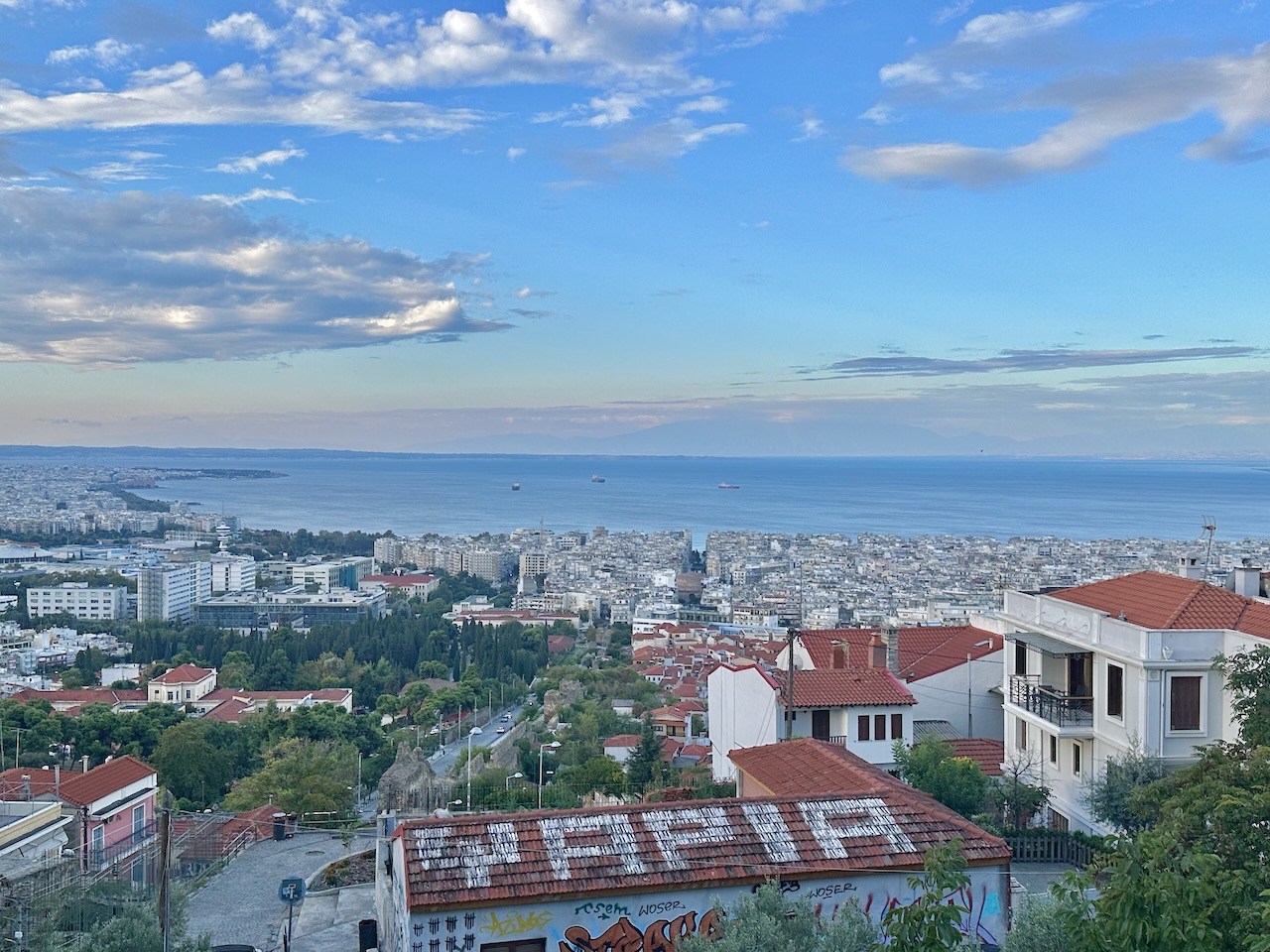
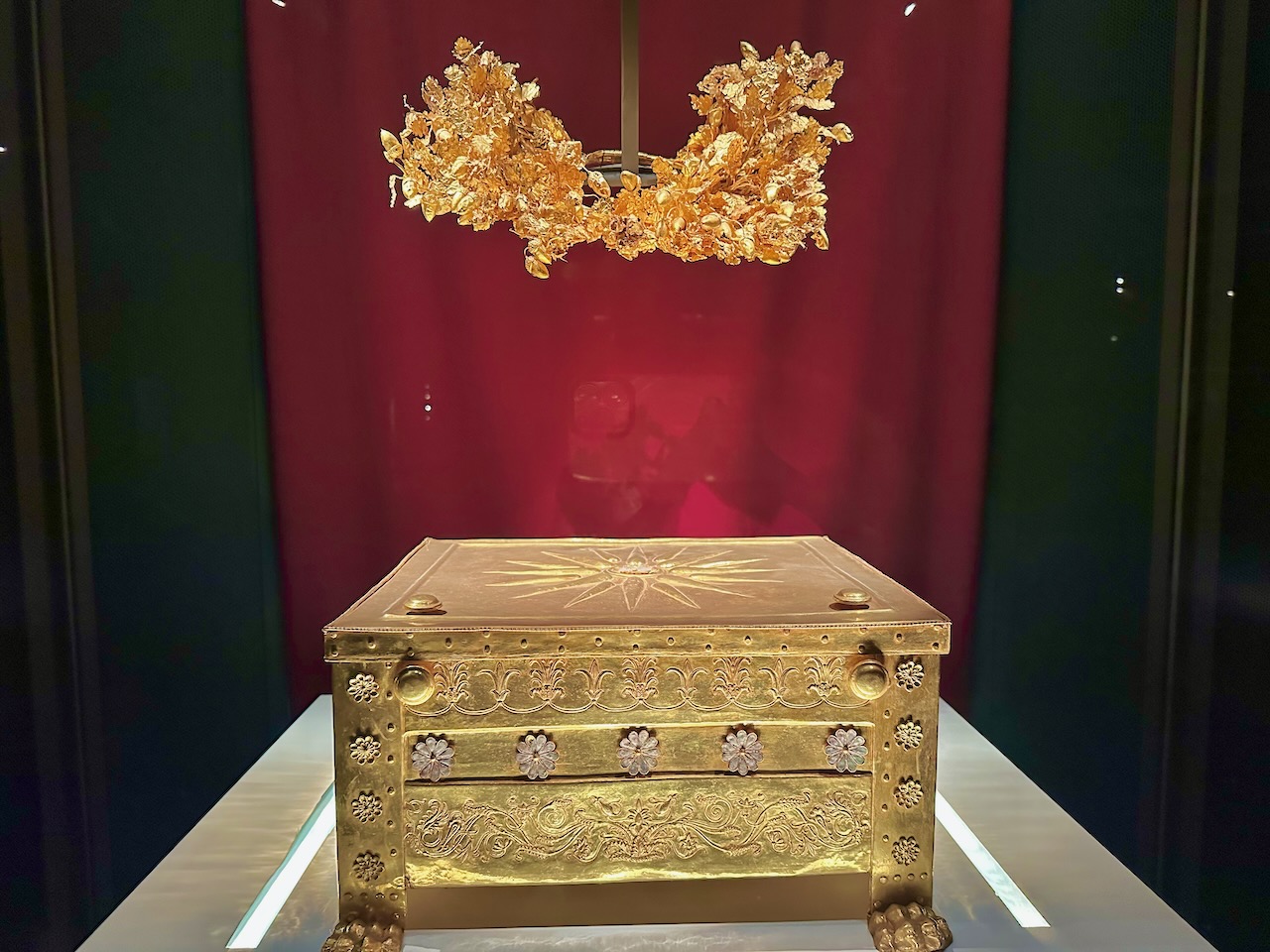
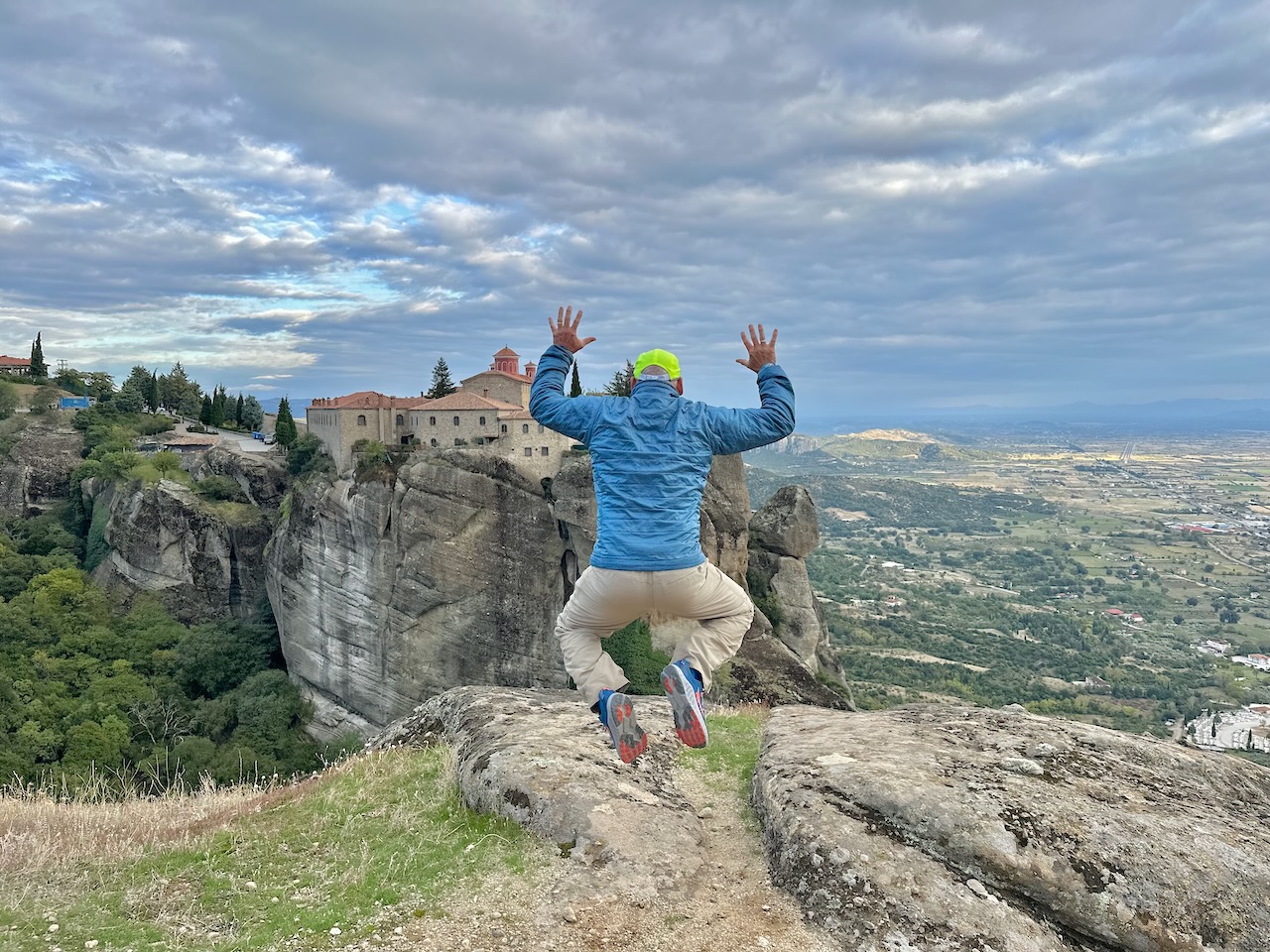
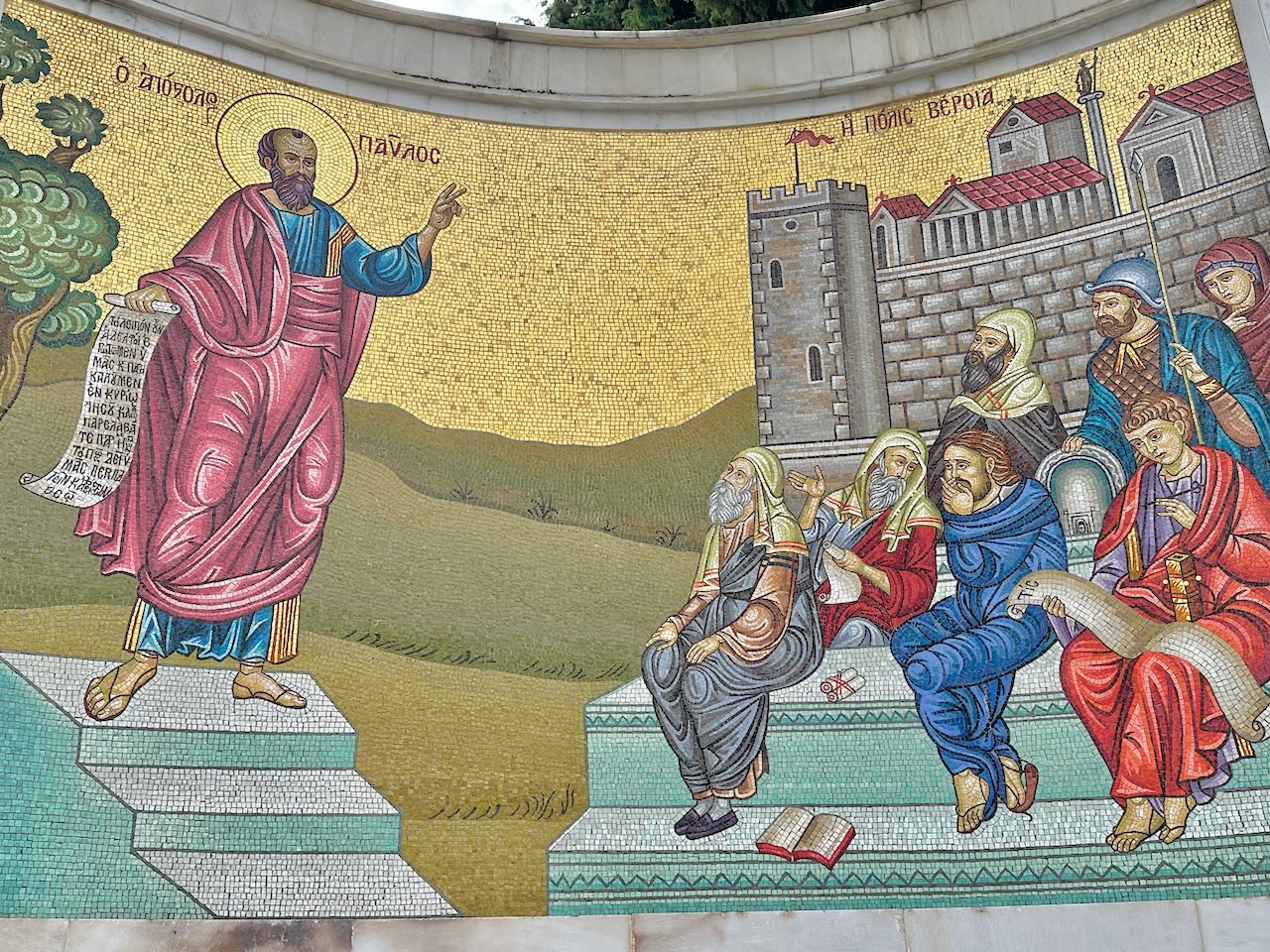
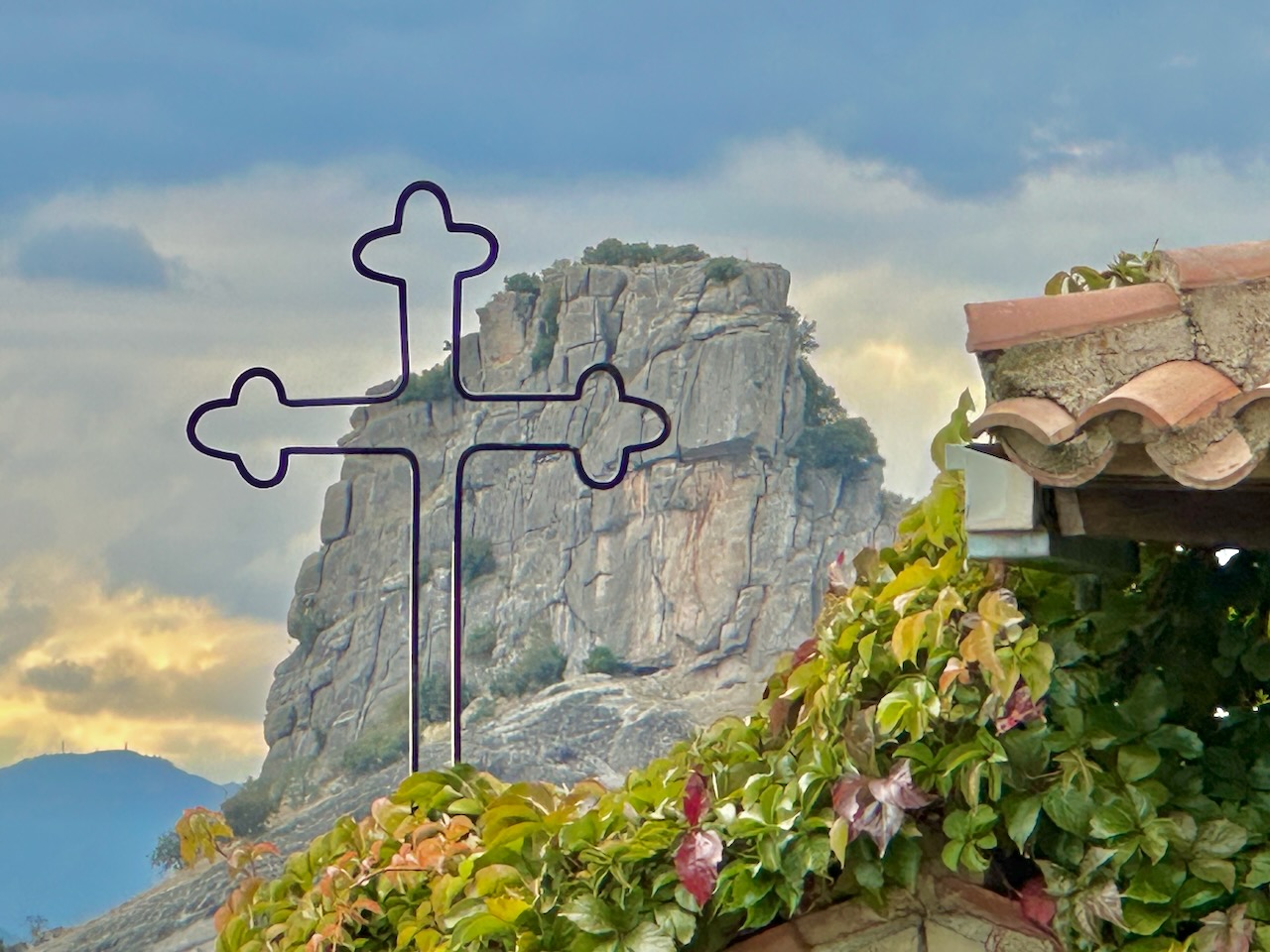
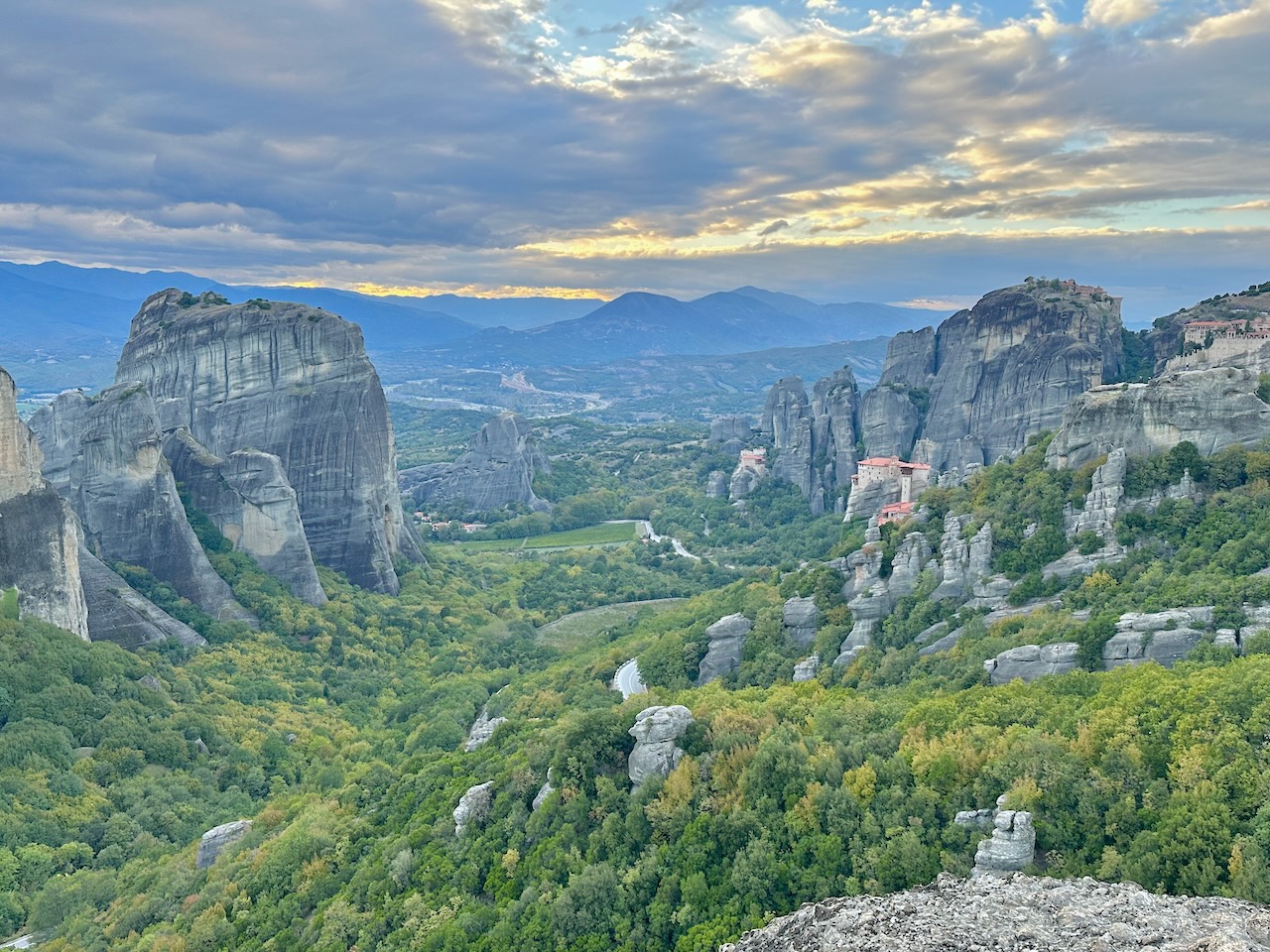
Day 5 – Wednesday, October 8: Thermopylae, Delphi, Athens
Today we drove south through more of the mountains of Greece, with a final destination in Athens. Again, the beauty of the high mountains (80% of Greece is mountainous), valleys, and plains of inland Greece was incredible to behold. The weather was enjoyable, with a partly cloudy skies, with peaks of sun. Temps were around 65. We left the hotel at 7:45 to begin the day. We read various portions of Paul’s letters, taking note of the important themes he seemed to highlight in each letter.
Thermopylae
The morning drive took us on a section of a beautiful brand new highway to the area of Thermopylae. It was here in the famous battle that took place in 480 BC where King Leonidas, along with 300 Spartan greeks (and incidentally along with 700 Thespian greeks) were defeated by the Persians. The battle field could be clearly seen. These Persians would be later defeated in a sea battle at Salamis shortly after. Today, only a monument stands in honor of the courage of these brave greek warriors.
Delphi
Continuing southward, we drove towards Delphi. Before climbing the final stretch of mountains, we first enjoyed lunch at Itea, a small quaint town along the Ionian (Adriatic) Sea coastline.
Following lunch, we arrived in Delphi. First, we walked through the museum. Many impressive artifacts are displayed here, including the famous bronze charioteer (dating to 476 BC), and the Gallio Inscription. This was written by Claudius who mentioned “my friend Gallio the proconsul of Achaia.” Luke mentions him as well as the one who listened to Paul at Corinth (Acts 18). It was discovered here in 1905.
The archaeological site nearby was quite impressive. We ascended through the site, complete with the famous Athenian Treasury, Temple of Apollo, and the theater. The Pythian Games were held at the stadium (which we could not see) here in Delphi every four years in honor of Apollo. Many also climbed to the top of the well-preserved stadium at the top of the site. The climb was challenging but worth the effort. Paul used the image of “running the race” often (i.e. 1 Corinthians 9, Philippians 3, 2 Timothy 2, etc…).
Delphi was known in this classical period of Greece as the place of oracles. The women who shared oracles were call Pythia. Acts 16:16 uses the same word. Paul and Silas preached that accepting Christ as spoken in the very Word (e.g. oracle) of God and trusting in God’s Spirit is what gives purpose and direction for our lives! Paul would also say that we are the “temple of God” with God’s Spirit indwelling within us (1 Corinthians 3:16f). We read portions of Romans 8 about how the Spirit directs and guides our lives! Incidentally, it is interesting that the famous artist Michelangelo incorporated the display of the Pythia in the ceiling painting inside the Sistine Chapel,
As we left the site, from a distance we saw the gymnasium and the Temple/Sanctuary of Athena (the Tholos, a unique rounded structure) below us amidst the ruins. This is the most photographed structure in all of Delphi.
Athens
Following the visit of this incredible classic Greek site, we drove to Athens. We arrived about 3 hours later. We checked into our hotel and enjoyed a late dinner together. Following dinner, many of us walked to Constitution Square to see the changing of the guard at the Tomb of there Unknown Soldiers.

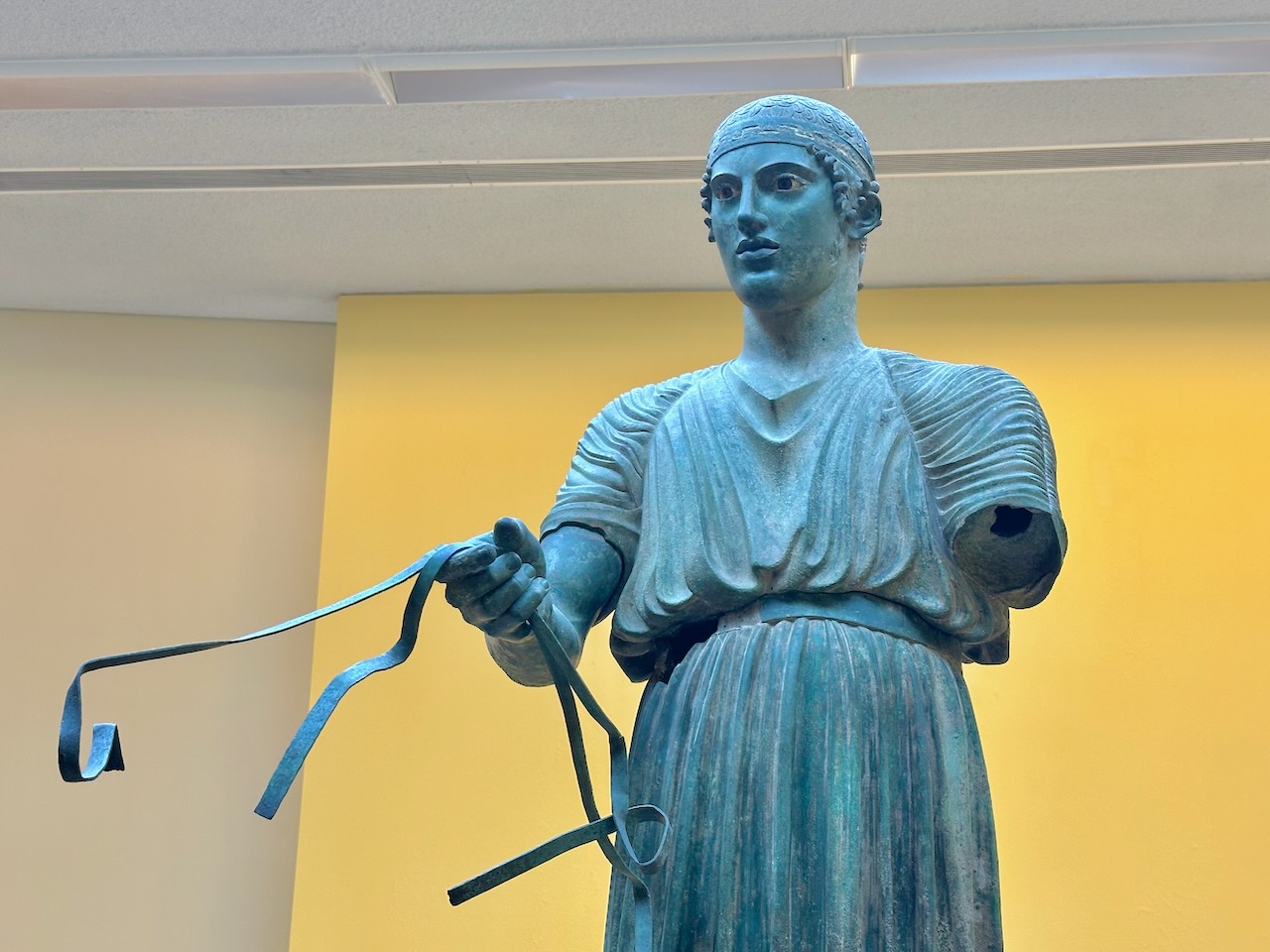
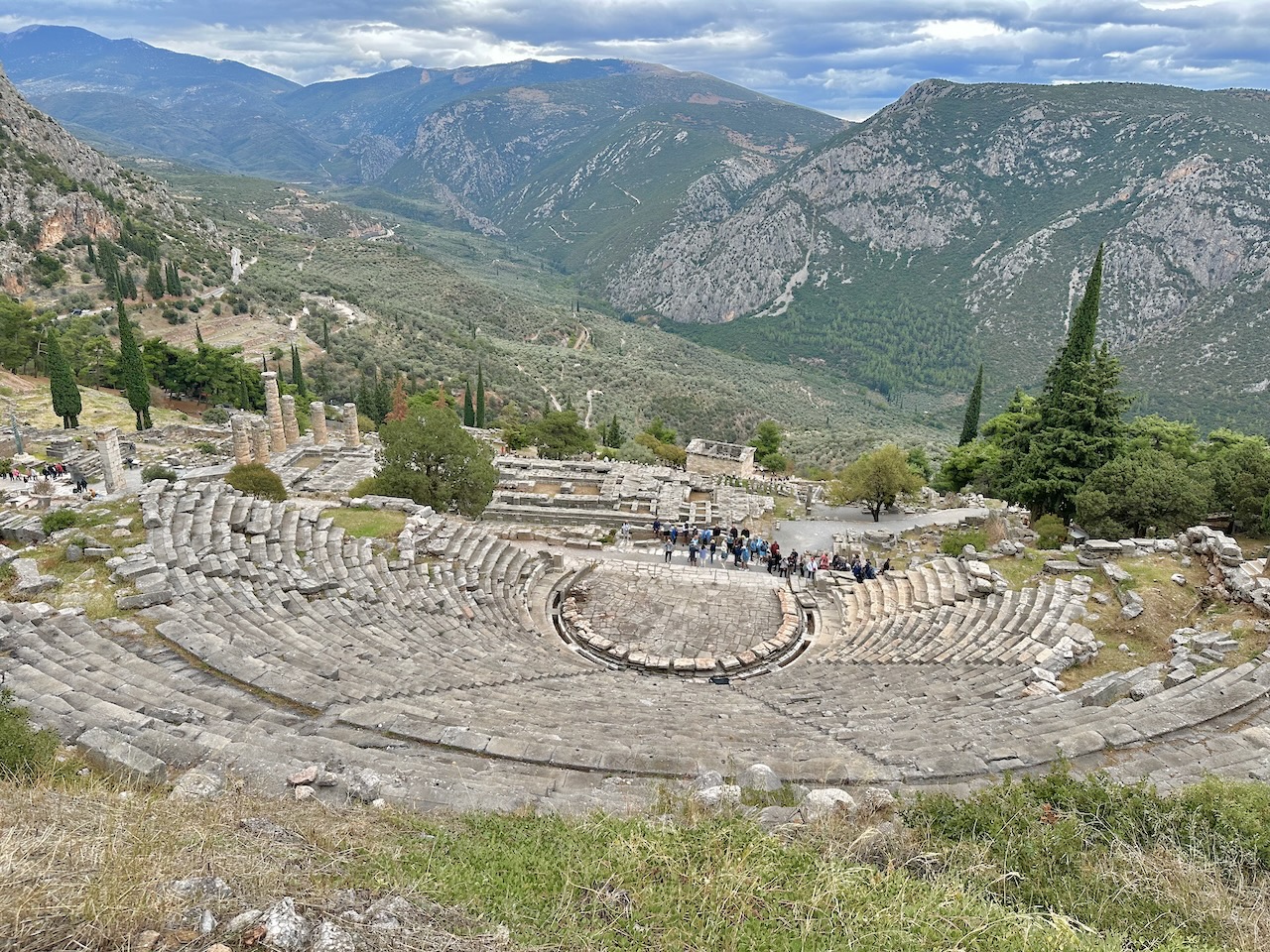
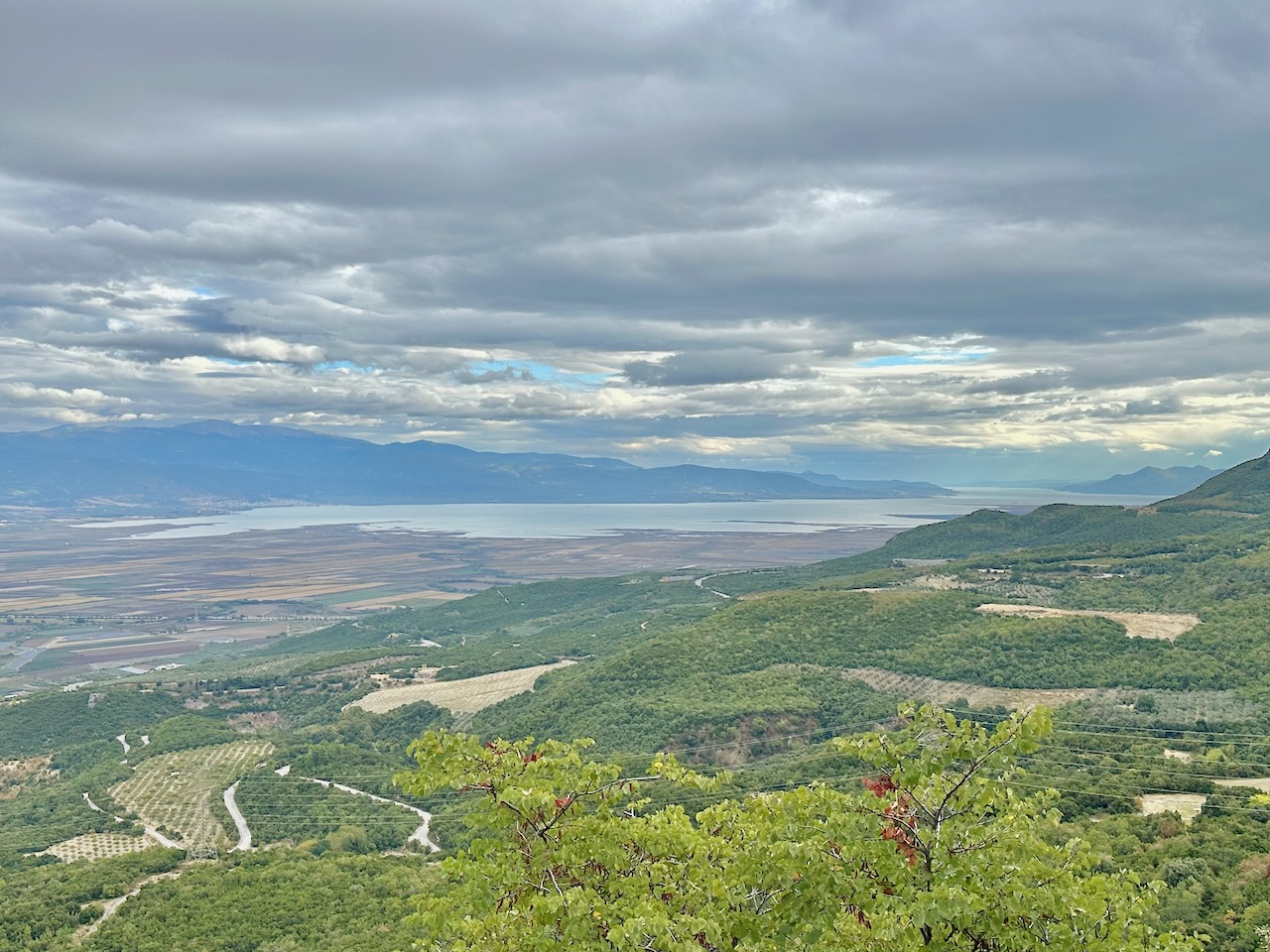
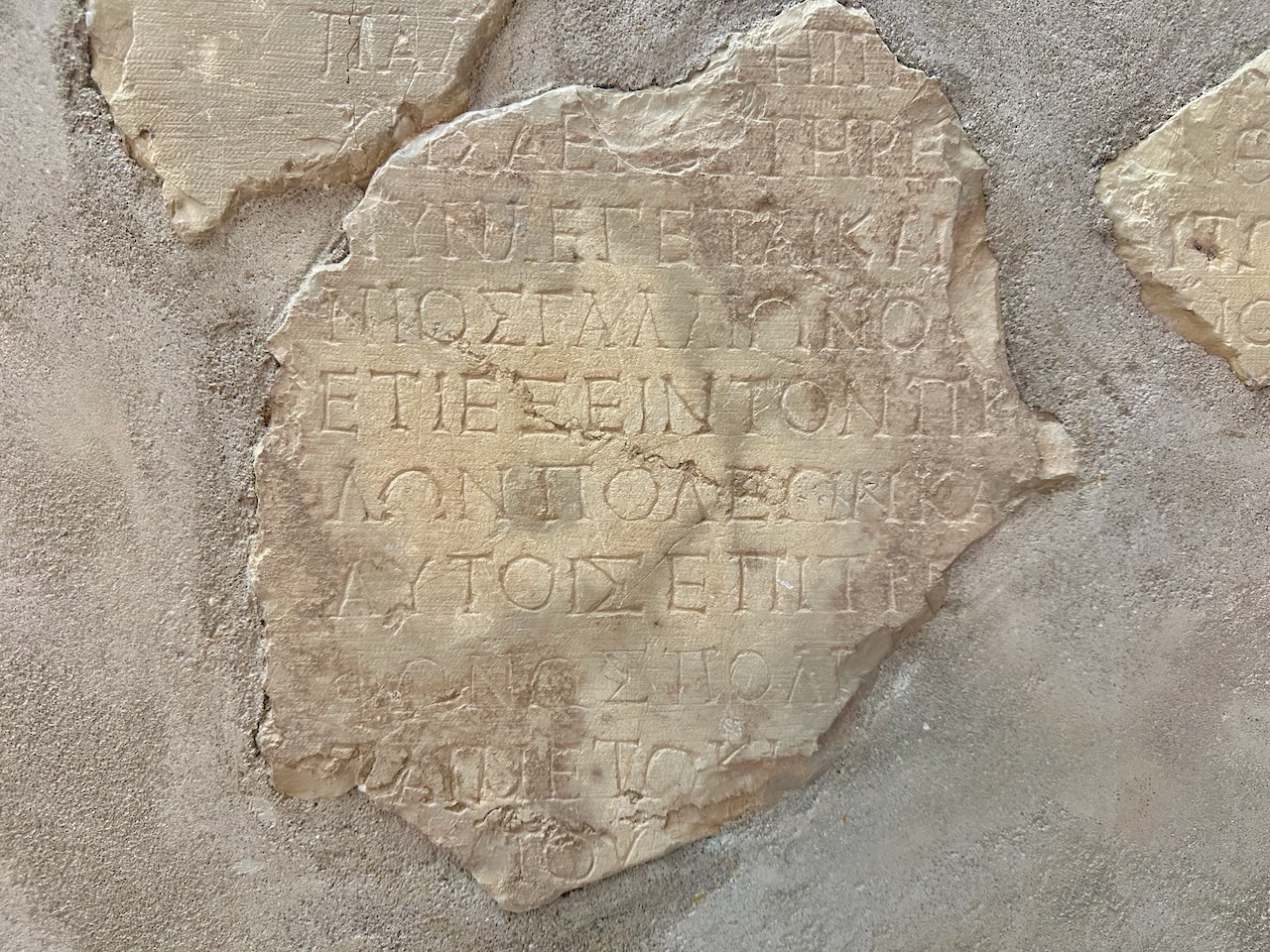

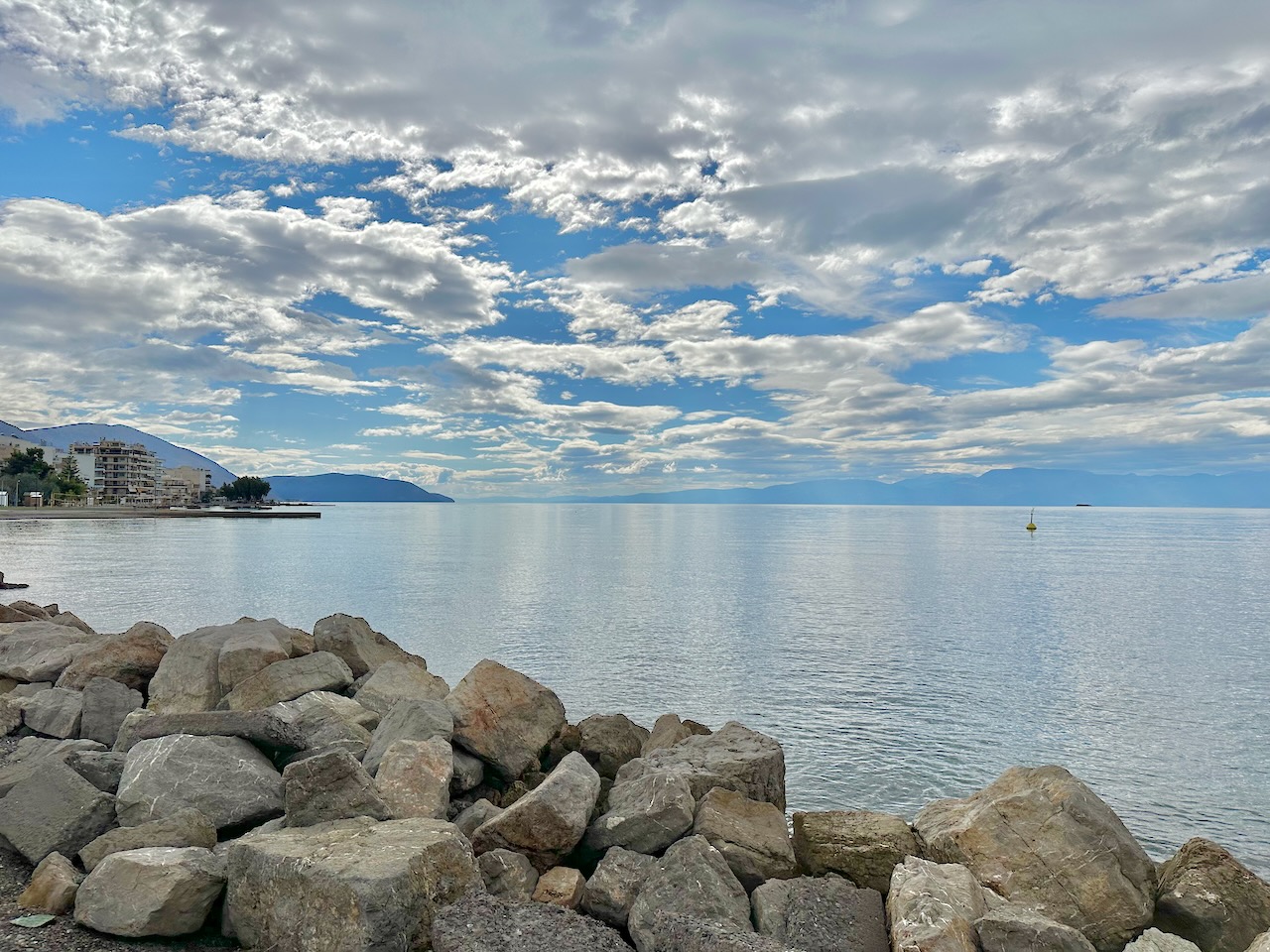
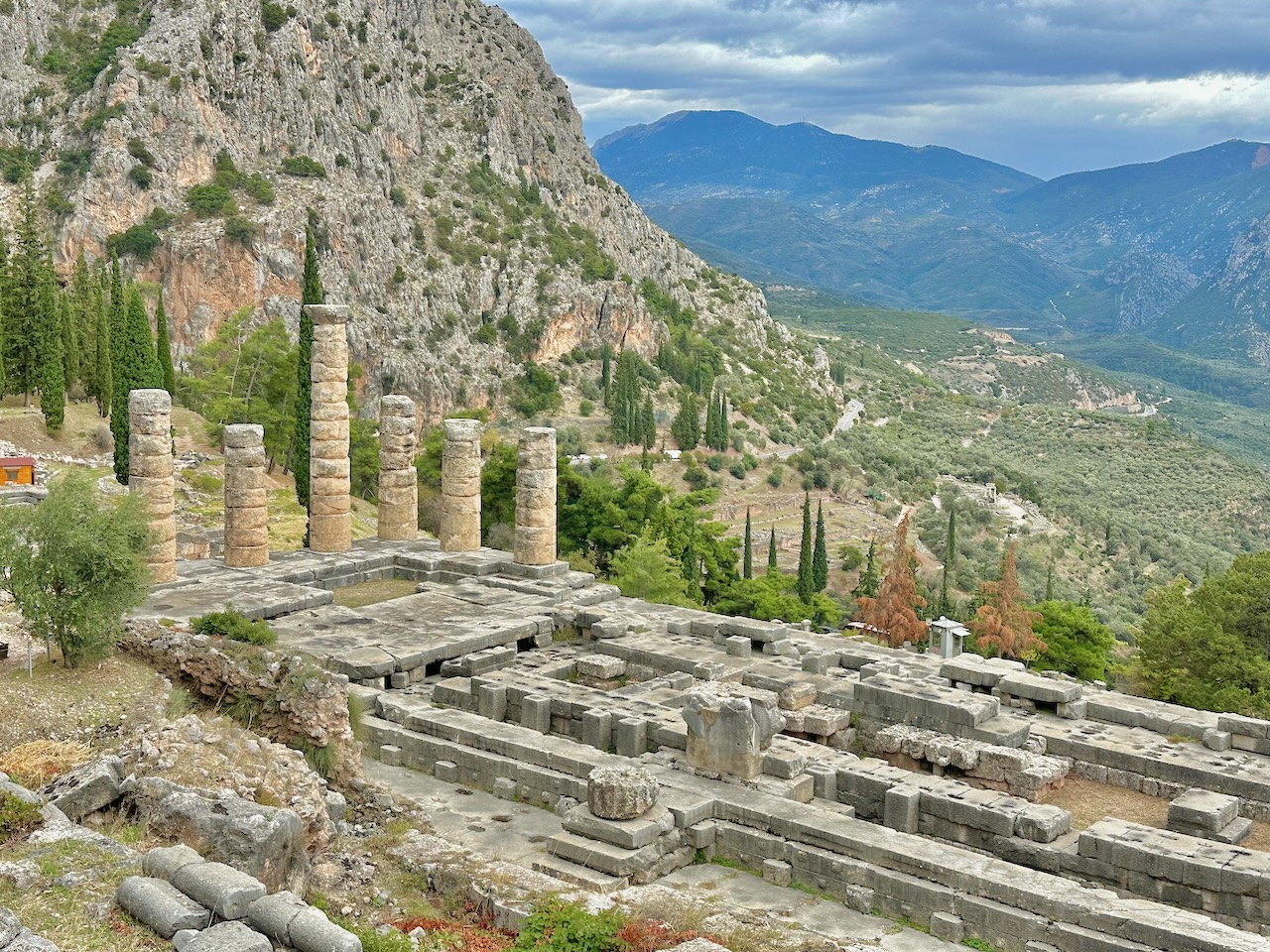
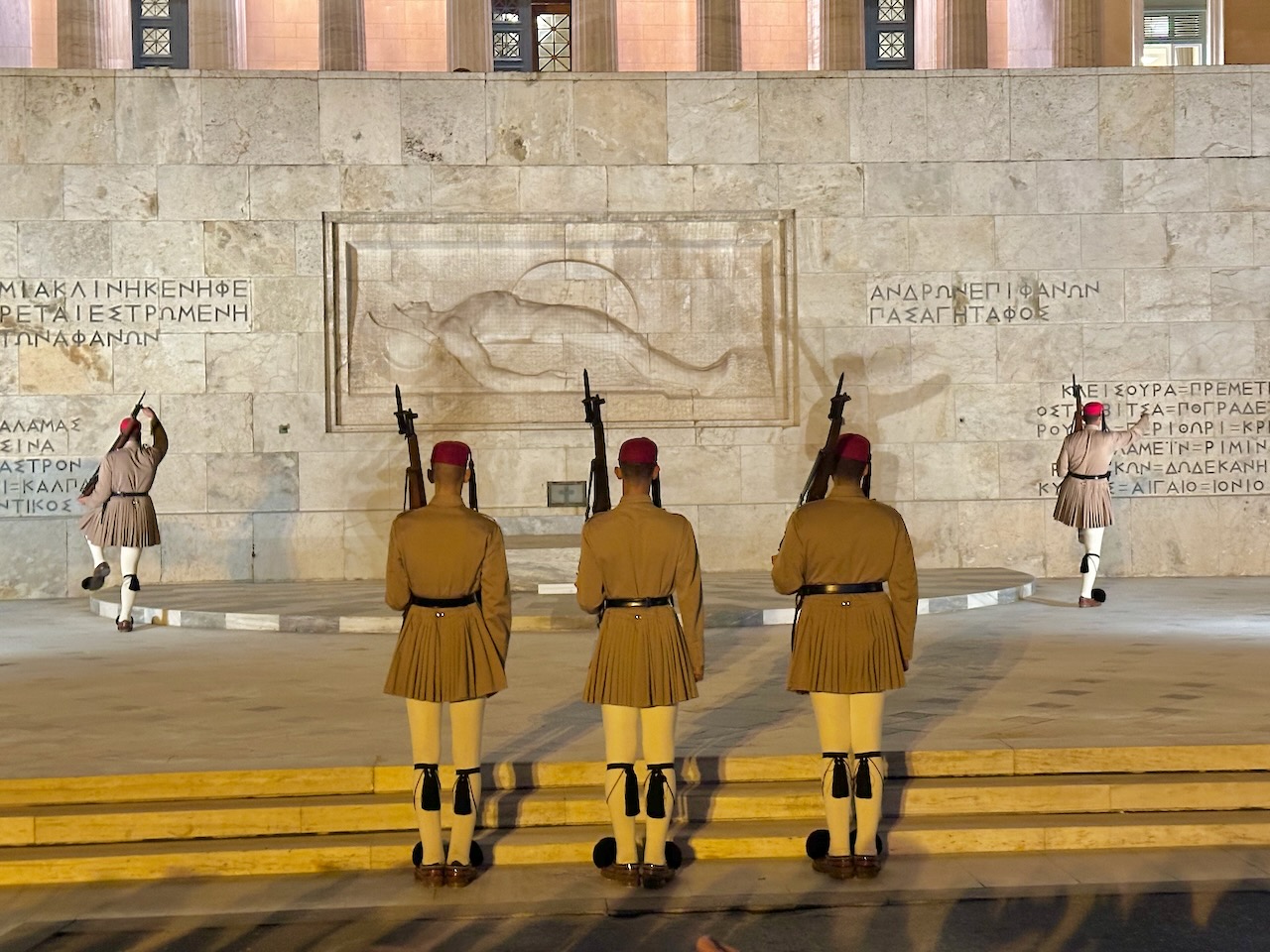
Day 6 – Thursday: October 9: Corinth, Mycenae, Cenchreae, Athens
Today we traveled to the Peloponnese of Greece. We left the hotel at 7:30 again following breakfast. The weather was perfect, with partly sunny skies, and temps around 70. We read portions of 1 Corinthians 4 and 2 Corinthians 5 as we left the hotel.
Corinthian Canal
We drove south from the hotel to the Peloponnese of Greece. Our first stop was at the famous Corinthian Canel. It was built over a 11 year span (1882-1893) and is 3.8 miles long, 75-85 feet wide (the width varies at each ends), 280 feet deep, with the water level around 26 feet. It is really a quite incredible engineering feat! We saw a few boats sail through also!
Ancient Corinth
We then traveled another 15 minutes to the ancient site of ancient Corinth. We first walked down to the area of the theater where we saw the important Erastus Inscription (he donated his own money for the public works, see Romans 16:23). Erastus is also mentioned in Acts 20 and 2 Timothy 4.
At the archaeological site, we began in the small museum. Here, we saw an image of the Menorah and many clay sculptures of the body parts represented (dedicated to Asclepius, also see 1 Corinthians 12). Among the ruins we saw the Temple of Apollo (one of 14 total pagan temples), the forum (agora in Greek), and the bema (or judgement seat) where Paul shared his defense/testimony before Gallio (see Acts 18). Paul was here for a year and a half during his 2nd mission journey. From here he wrote letters to the Thessalonica church in the north. During his brief stay here at the end of his 3rd mission journey, we wrote Romans. It was delivered by Phoebe (Romans 16).
After lunch in the public square of Corinth (many had gyros!), Before leaving the area of Corinth, we drove up to the Acropolis for a peak of the Temple of Aphrodite and a spectacular view of the plain of Corinth 1800 feet below. The massive walls and gates date primarily from between the the time of the Crusaders, Ottomans, and Venetians. However, the lower coarses of wall go back to the Greek and Roman periods. Many made the climb to an incredible viewpoint of the plain and port of Corinth below.
Mycenae
From here we drove about 30 minutes to Mycenae. Much of what we saw dates from 1,350 – 1,200 BC. Entering the site, we walked under the famous Lion’s Gate (1,200 BC). We also saw the shaft tombs (where over 30 pounds of gold was found in the 1870s excavations, including the famous golden masks), the palace area, and the cistern. We also saw the Bee Hive tomb of Atreus, the father of King Agamemnon (also called the Treasury of Atreus). We enjoyed singing the Doxology and Amazing Grace in the tomb. We sounded like a heavenly choir. 🙂
Cenchrea
Leaving Mycenae, we started our way back to our hotel in Athens. But before leaving the area of Corinth we made a brief stop at Cenchreae (Acts 18) on the way. This was the harbor Paul used to sail to Ephesus and eventually back to Caesarea. Here Paul cut his hair because of the Nazarite vow he had made (Numbers 6:18). Phoebe also served the church established here (Romans 16:1). We then drove back the rest of the way to the hotel, arriving for dinner.
Mt. Lycabetus
Following dinner at the hotel, some (11) in the group walked to the top of a highest hill in Athens called Lycabetus. The view was incredible from here offering a panoramic view of all of Athens. This includes seeing the Acropolis and the port of Piraeus! We all walked back to the hotel and back to our rooms to retire for the evening. We are all looking forward to the start of our 3-day cruise tomorrow morning.
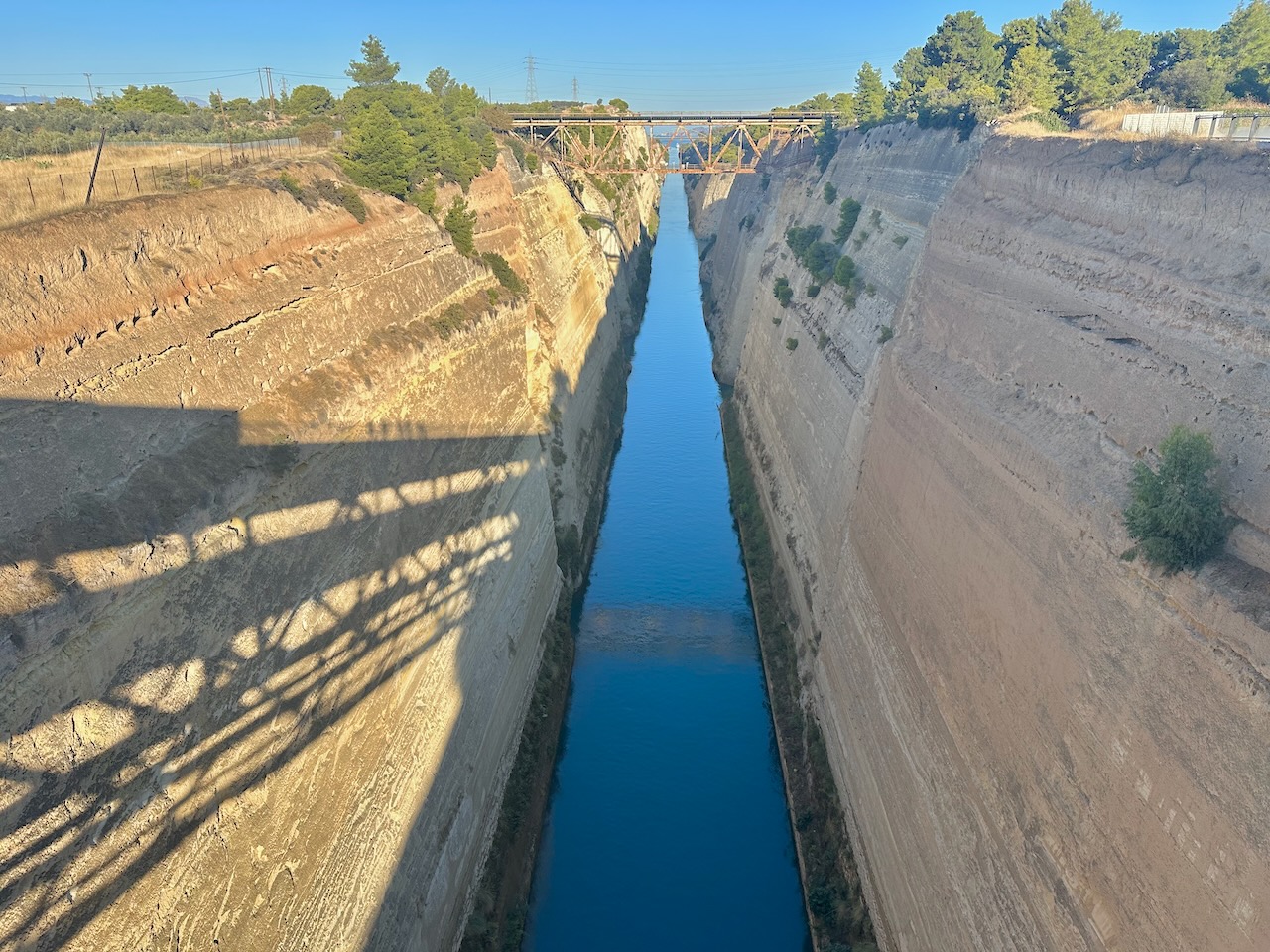
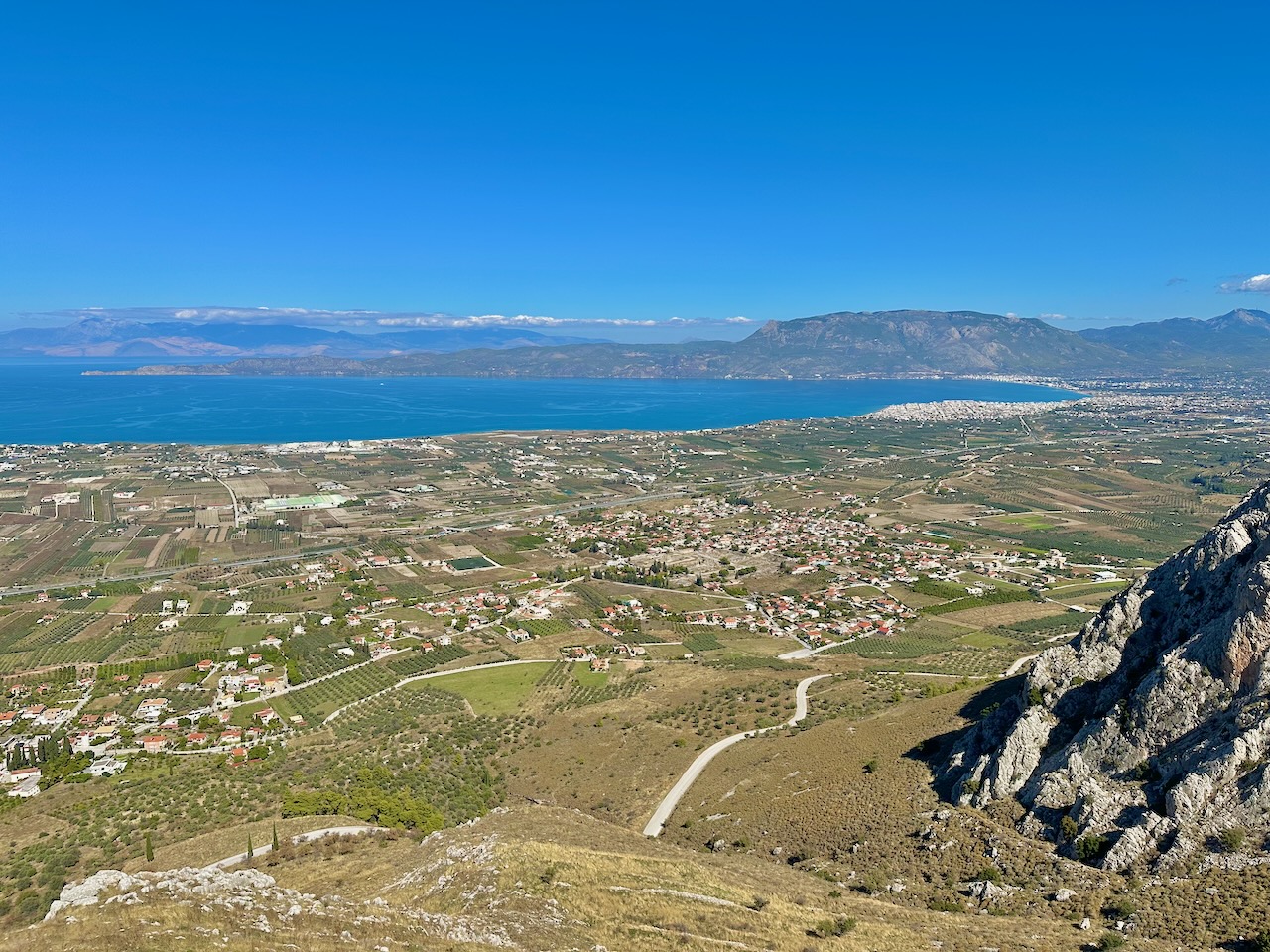


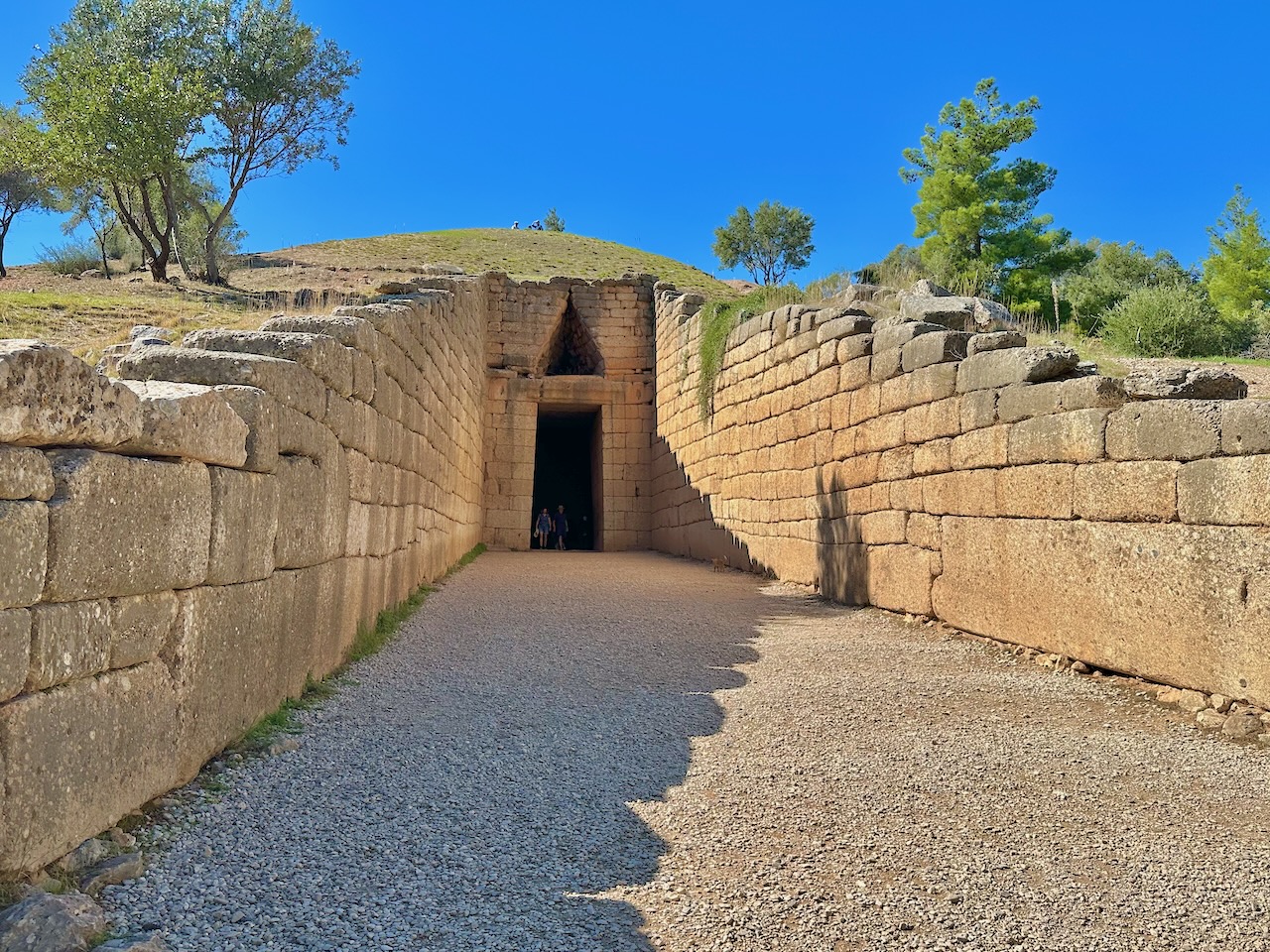

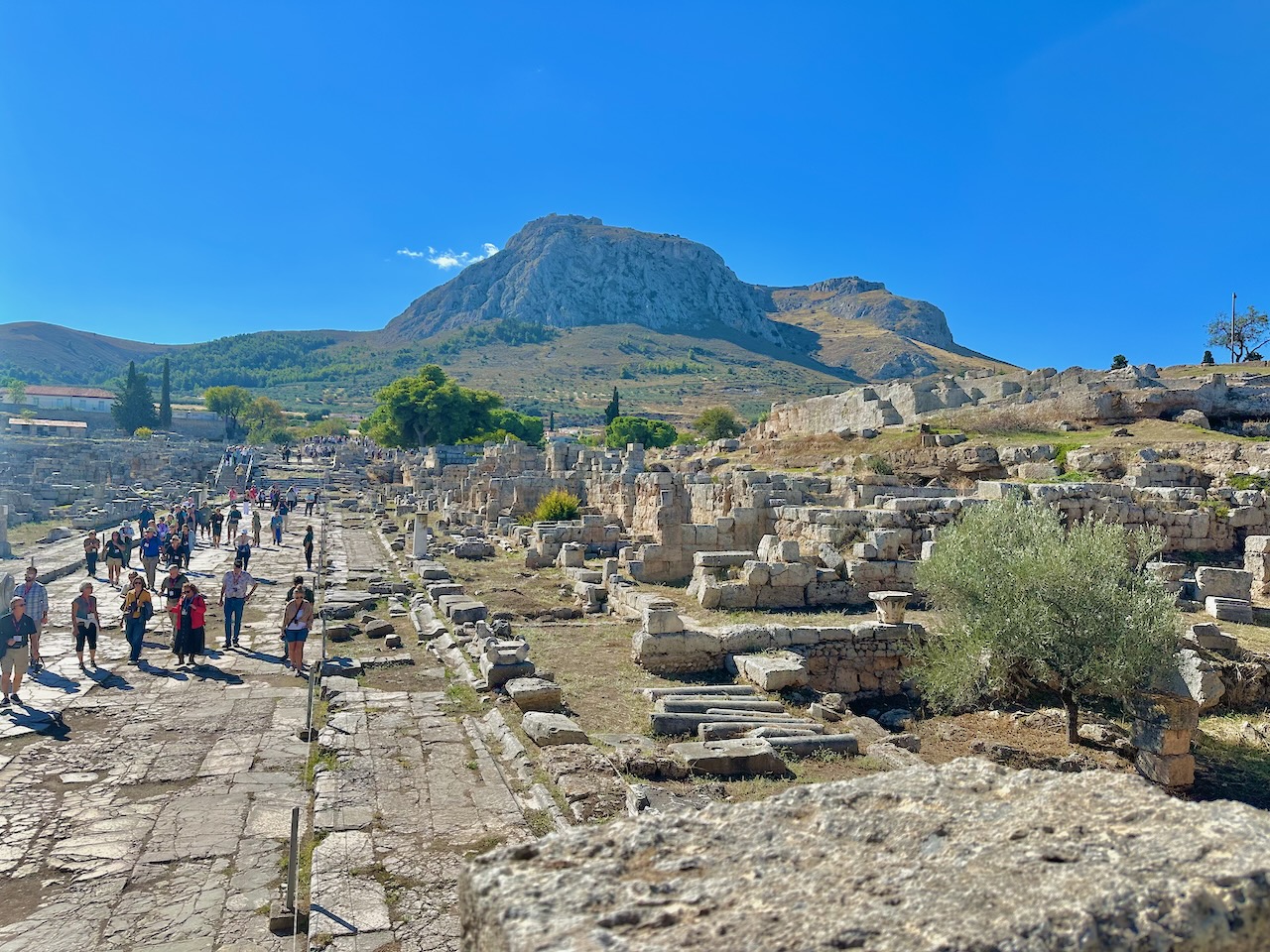
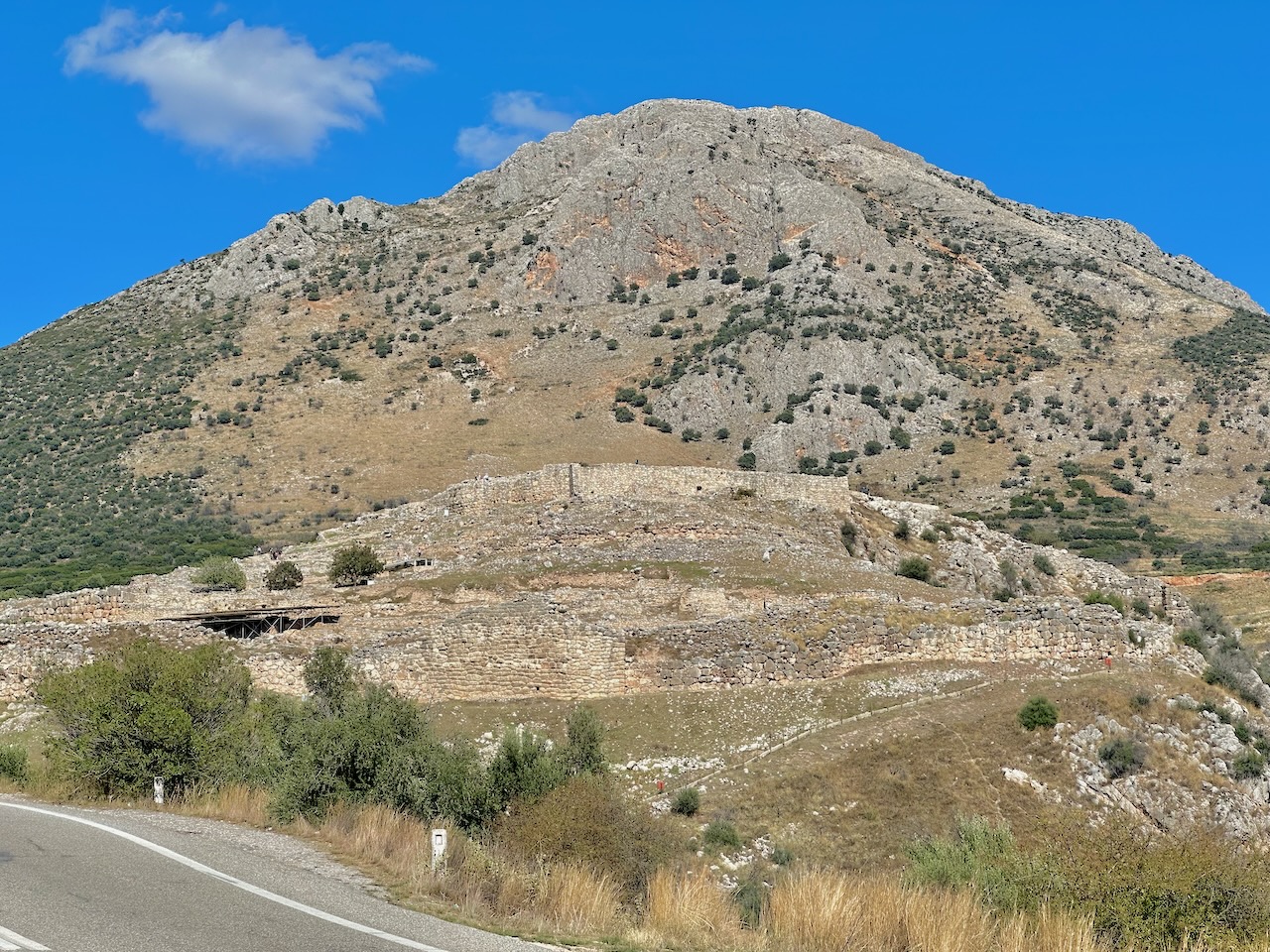
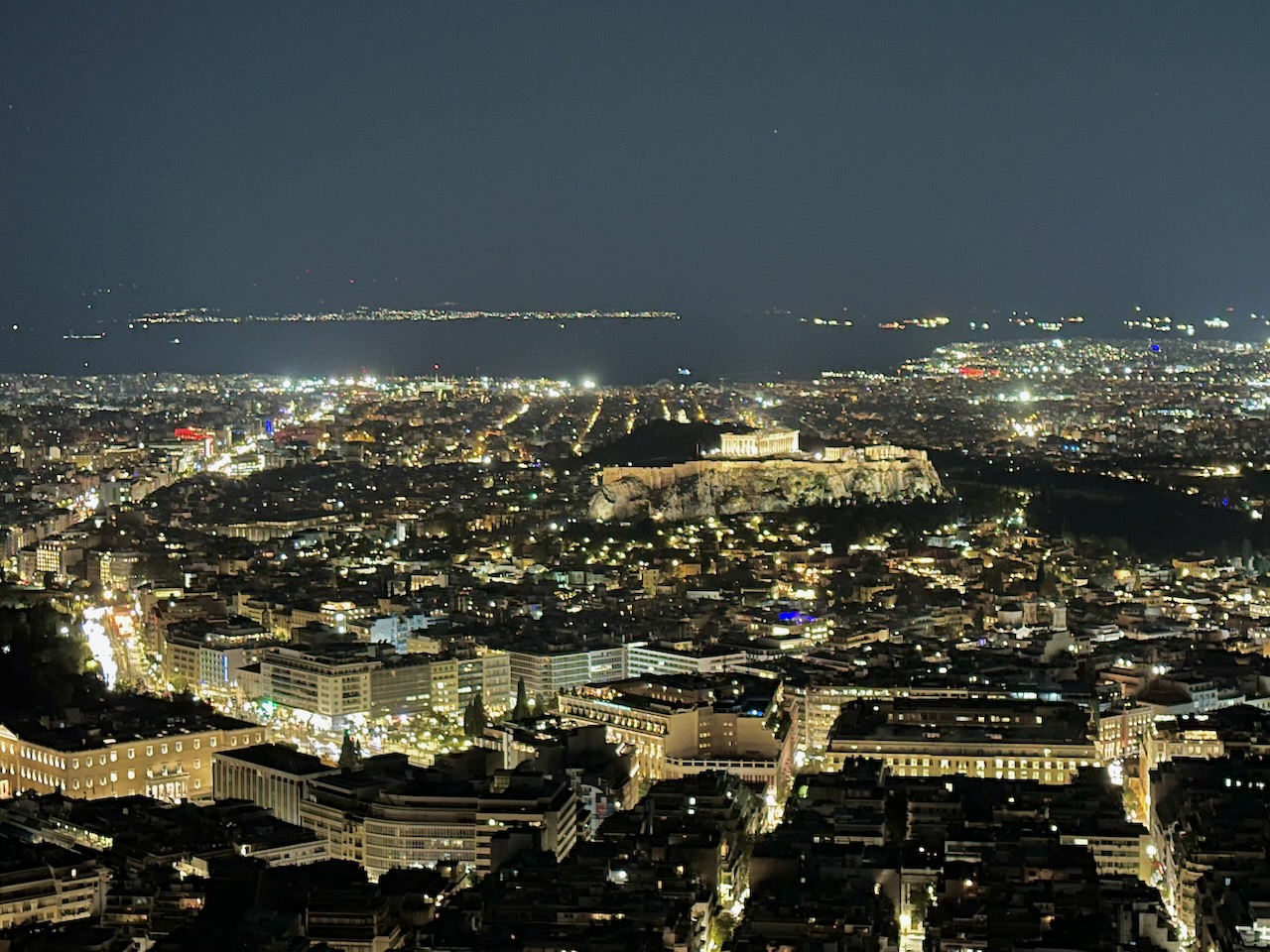
Day 7 – Friday, October 10: Athens, Embark on 3-Night Cruise, Island of Mykonos
This morning we enjoyed a late departure (9:45). This allowed us to enjoy a relaxing breakfast. Tasos and Sarah (our Greek agents with us for the 3 day cruise) gave us tags for our bags for the cruise boat. We loaded the bus for the drive to the Laurion port of Athens (not the usual port of Piraeus). The drive to the port took a little over an hour.
Following the standard procedures of boarding the ship, the ship pulled out of the port in the early afternoon. We enjoyed the standard life-jacket drill and lunch on the ship. The rest of the afternoon was a leisurely one as we sailed about 66 miles to our first Greek island, Mykonos. The deep blue waters of the Aegean was beautiful! Today’s weather also made it perfect, with full sun once again and highs in the 70s.
Mykonos
We arrive at the island of Mykonos about 6:00 p.m. We disembarked the ship around 6:25. We then took shuttle buses to the old harbor. We then strolled through the maze of walkways and white-washed buildings before arriving at the famous windmill area. We enjoyed the waterfront (called Little Venus) lined with shops and cafes. The sunset was incredible as well!After time walking around on our own, we returned to the ship on our own for a late dinner. While we sleep tonight we will travel to Kusadasi on the western coastline of Turkey.
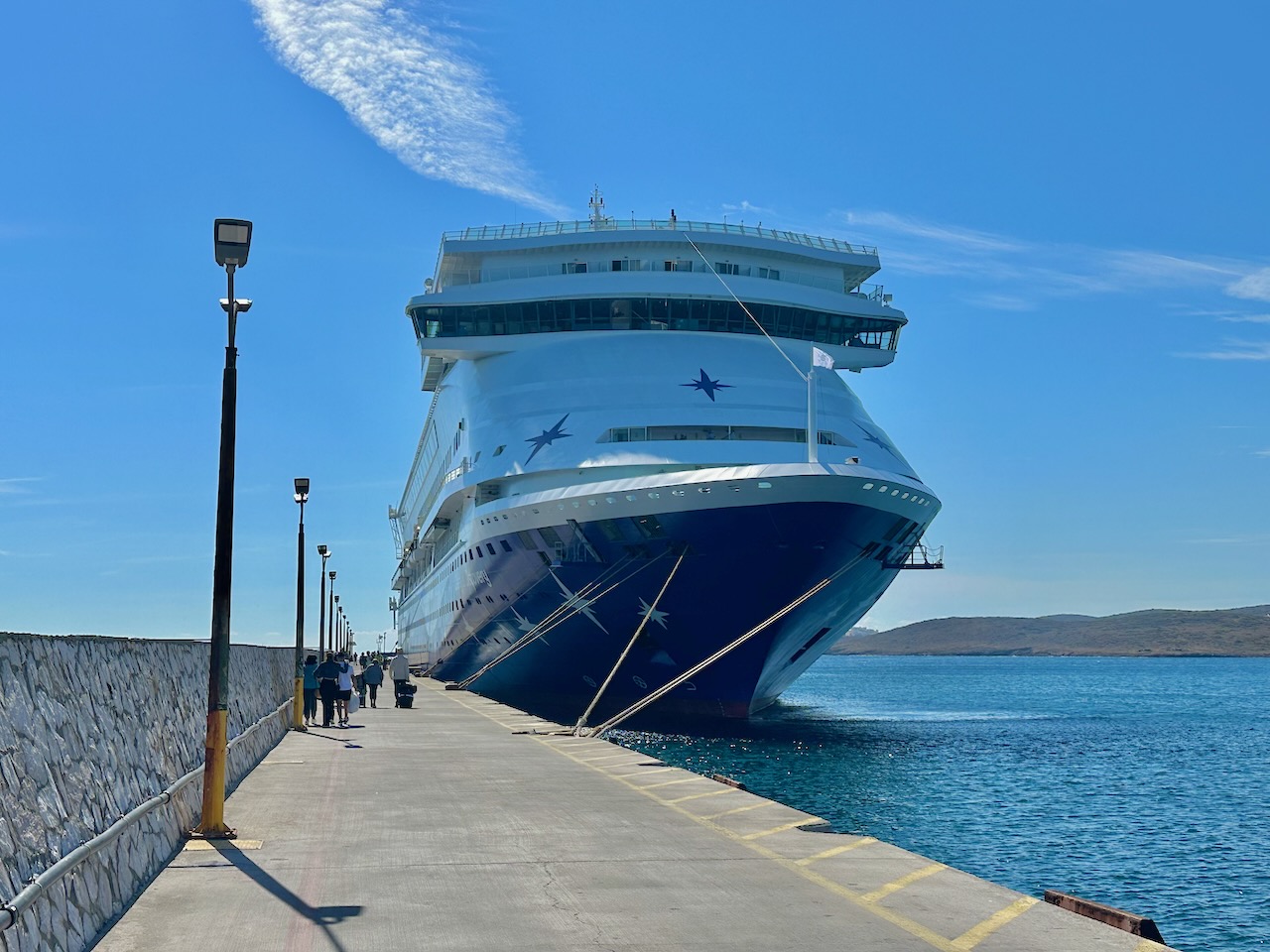
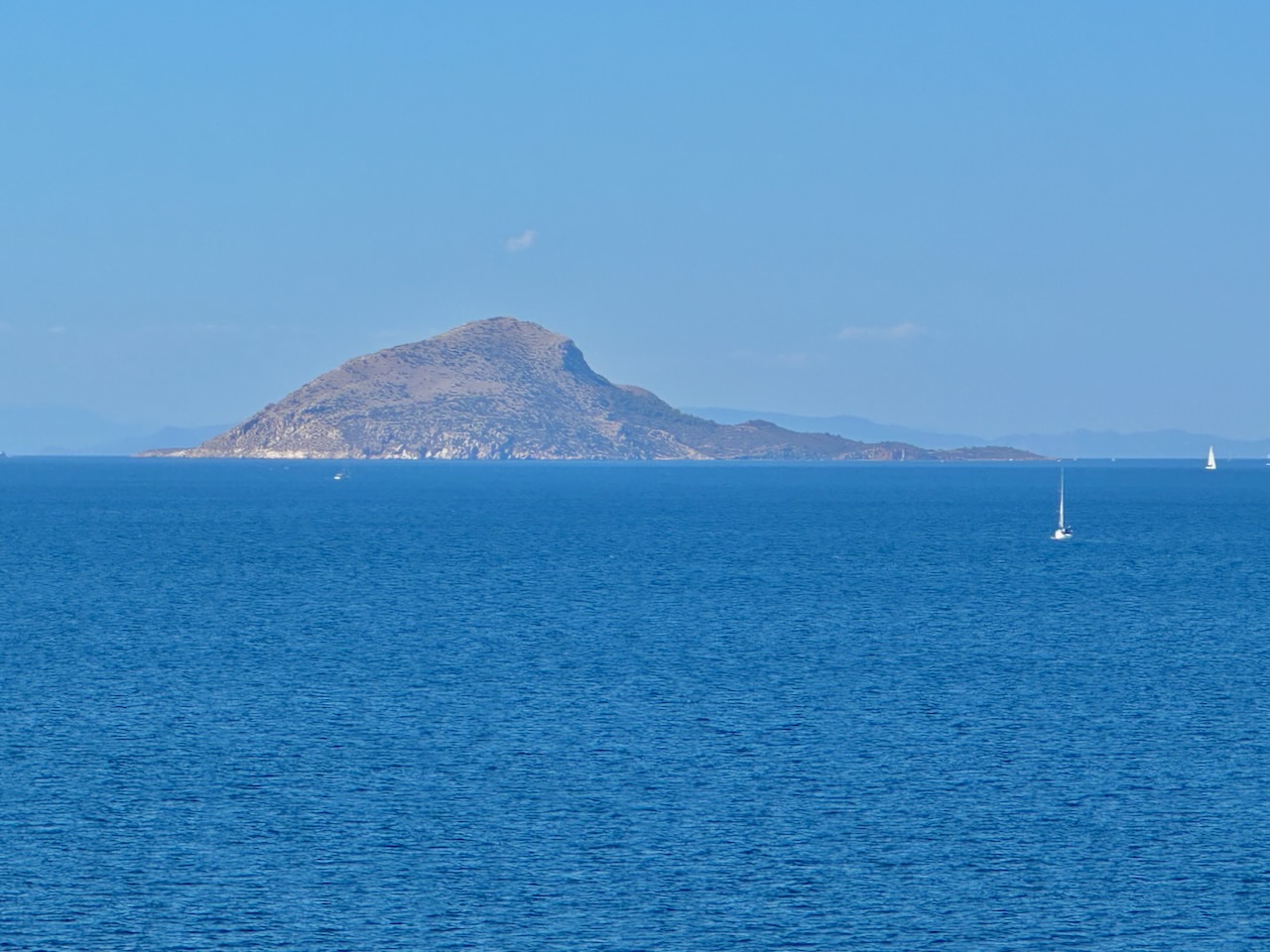

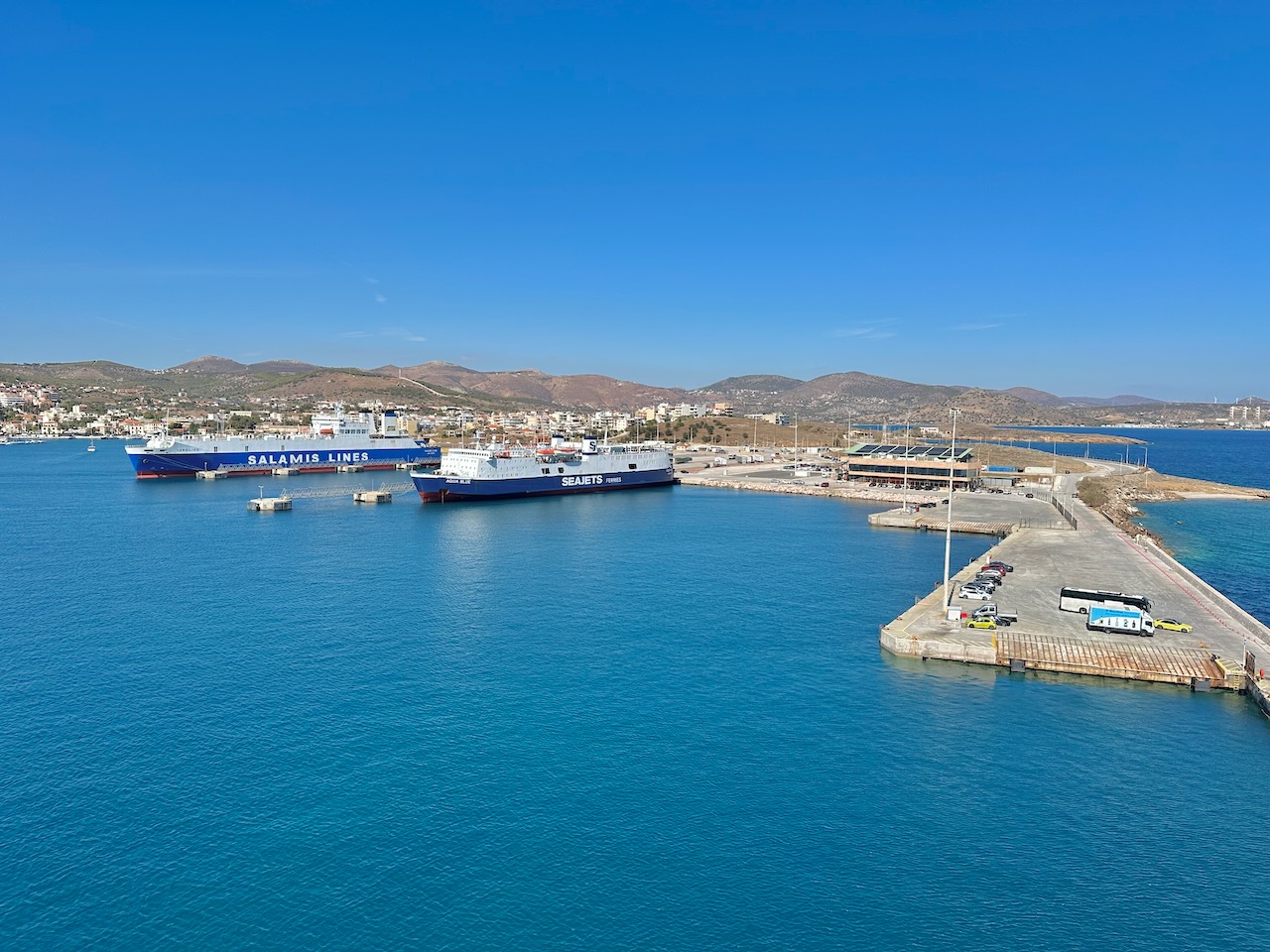


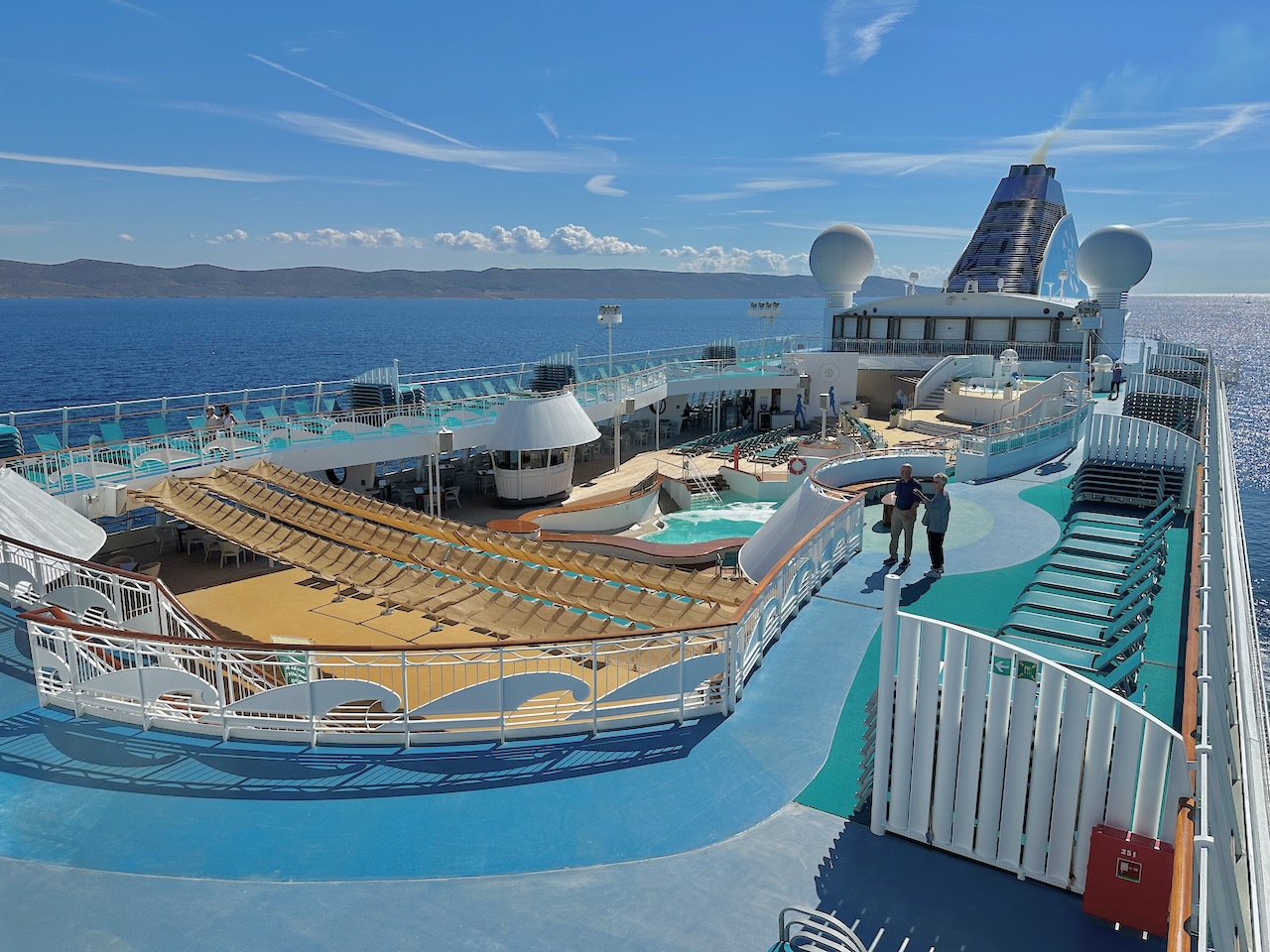

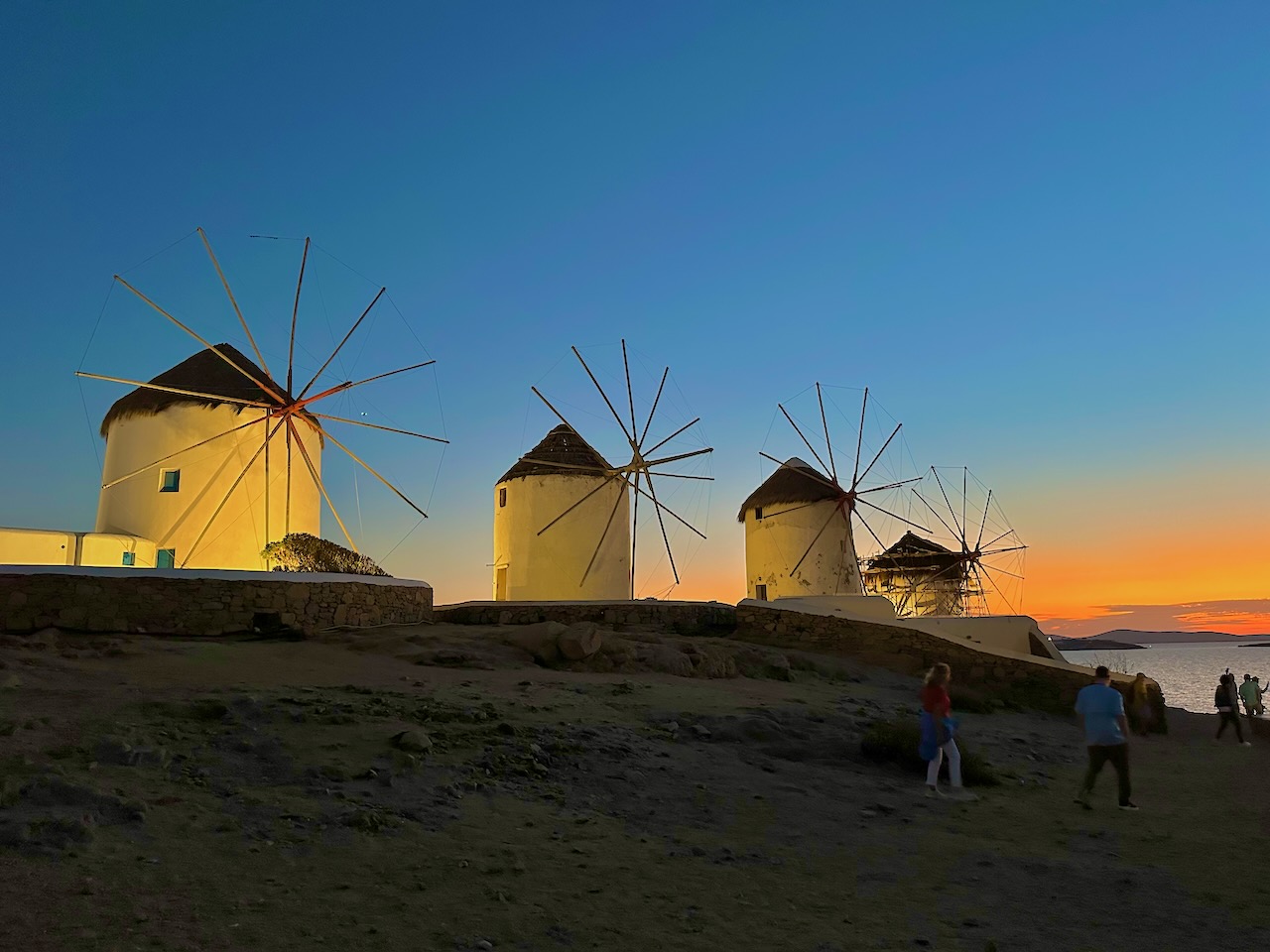
Day 8 – Saturday, October 11: Kusadasi (Ephesus) & Patmos
Following sailing through the night to Kusadasi (on the western coastline of Turkey), today was another perfect weather day, with bright sunny day, blue skies and highs in the low 70s. It was a day of connecting to Paul’s ministry once again (at Ephesus), but also John’s ministry as he authored Revelation (from Patmos). The day started early, with a 6:45 a.m departure from the ship following breakfast. We read from Revelation 2 and sang our song (“Oh, the sun’s coming up…”) before we disembarked from the ship.
Kusadasi, Turkey
Here at Kusadasi (it means “bird island” in Turkish) is where we met our bus and local guide (Isa – he will be guiding us for the extension as well). Located on the western coastline of Turkey, this port city is a vacation and retirement locations for many Brits and Europeans. From here we drove directly to Ephesus.
Ephesus
We arrived in Ephesus at about 7:45 a.m. This was a massive port city back in the days of Paul. Today the water’s edge is about 4 miles away! Paul spent about three years here during his 3rd mission journey.
Starting from the upper part of the city and walking on the ancient 2nd century BC stone pavement (used by Paul later) towards the port, we past by a vast number of archaeological ruins. This included the odeon (small theater), statues, pillars, arches, inscriptions, public latrenes, and the Celsus Library (which dates to the early 2nd century AD). Sitting together in the agora, we read portions of Acts 19 about the dramatic event that took place in the grand theater. It held about 20,000 people! People gathered in the theater “confused” and “not knowing why they were there” because they anticipated being treated to food and wine, as was the custom). For us, unfortunately, the theater was closed for renovations, we read the rest of Acts 19 from a distance but still in view of the theater (note: photos from within the theater were taken on a previous trip).
Upon leaving the site, we drove to the Temple of Artemis (Diana) that once stood here. All that remains is one pillar (of a total of 127 in this massive temple). Indeed Paul was challenged in sharing the kingdom message here at Ephesus.
On the way back to the ship we made a stop at a local rug shop/store (it’s an unavoidable part of the excursion deal required by the cruise line). It was very interesting, however, to learn how Turkish rugs are made, whether from cotton, wool, or silk. Shortly after noon we re-boarded the ship and enjoyed lunch and some free time. It was fun being on the deck as the islands past by.
Patmos
As we set sail out of Kusadasi for the southwest, we past by the narrowest opening, with the coastline of Turkey on our left and the Greek island of Samos on our right (Acts 20:15). Paul stopped here on this mountainous island at the end of his 3rd mission journey en route back to Jerusalem.
Later in the afternoon we gathered on the top deck as we approached the island of Patmos. This island is another one of the picturesque Greek islands. While imprisoned on this island, the Apostle John wrote the Book of Revelation from here (either in AD 90 during Emperor Domition or as Dr. John suggests, prior to AD 70 prior to the destruction of the Temple). To get to the island, we had to use tender boats, which is fun and beautiful in itself!
Upon arriving on the island, we enjoyed some free time. Some took a taxi up to the Grotto of the Apocalypse (a very traditional stop where John supposedly was imprisoned and received his vision) to the area of a Greek Orthodox monastery. It is called St. John’s and it has been active for a little over 900 years! Most in the group explored the hiking trail that ascended up towards the Grotto. The view from here is spectacular! We read portions of Revelation 4 & 5, and 22 and spent a brief time of reflection and worship (“Worthy is the Lamb”).
This visit to Patmos reminded us that Revelation is a victory book written by John who was exiled here, that honors Christ. We celebrated the promise of Christ’s redemption and victory over evil, His Second Coming, His exaltation as King of kings and Lord of lords, and the establishment of a new heaven and earth!
Down at the water’s edge we explored the shops and cafes at our leisure on our own before we took the tender boats back to the ship for dinner. During the night hours while we sleep we sail to the island of Crete.









Day 9 –Sunday, October 12: Crete & Santorini
Today was another perfectly sunny day, with temps once again around 70. The Greek islands are known for its blue skies and beautiful islands. The morning began with a full buffet breakfast once again. We then all met on the 9th deck where we read from Titus 1 and 3 as we prepared to leave the ship at 7:30.
Crete
Once we disembarked the ship, we met our two local guides and boarded our buses. The excursion here on the island of Crete first took to the Knossos excavations. Here we saw the archaeological discoveries of the Minoan civilization. They were probably one of the forerunners of the Philistines. Most suggest Caphtor (in Jeremiah 47:4, Amos 9:7) is the ancient island of Crete, while they were called the Sea Peoples by the Egyptian Pharoah, Ramses III in the late 13th-12th century BC. As for the Minoans, this people group dates back to about 2,000 BC (about the time of Abraham).
At Knossos we saw the restored palace area, with many frescoes and other ruins. Biblically in the New Testament, it was Paul who left Titus here on this island, giving instructions on appointing church leaders in the towns (Titus 1:5f). Also, Paul himself would have sailed around the lee of Crete (Acts 27:7) on his way to Rome. They found refuge from the wind in the port called Fair Havens on the southern side of the island.
Before leaving the island we enjoyed some free time walking around the shops and stores at the town square of Heraklion. A few of the ruins from the Venetians can be seen here as well. Some of us bought olive oil (since Crete is well known for having the best!). Many also enjoyed the beautiful blue waters down at the port area. We boarded back on the bus that took us back to our ship.
Santorini
After re-boarding the ship, we enjoyed lunch and some free time before gathering once again on the top deck at 3:30. The approach into the port of Santorini was incredible. Most of the city is perched high on the edge of this ancient volcano. It most likely erupted around 1550 BC (some suggest 1453 BC) and brought an end to the Minoans living here.
Leaving the ship by tender boats again (like Patmos), the entire group waited for our turn to take the cable car to the top. Unfortunately due to a rock slide two days ago, the donkey path to the top was closed. The “hikers” were disappointed, but there was nothing we could do. The cable car ride took us about 750 feet to the top.
The view from the top for everyone was breathtaking! No words can adequately describe it! Santorini is the most picturesque islands! At the top of Thira, we all took the time to explore on their own, with many enjoyed dinner as the sun set to the west over the “bowl” of the volcano below (now all water). The sunset was incredible!
We returned back to our tender boats on our own by 9 p.m. Once back on board the ship, during the night we set sail back to the Laurion Port of Athens. We anticipate docking tomorrow morning by the time we wake up.
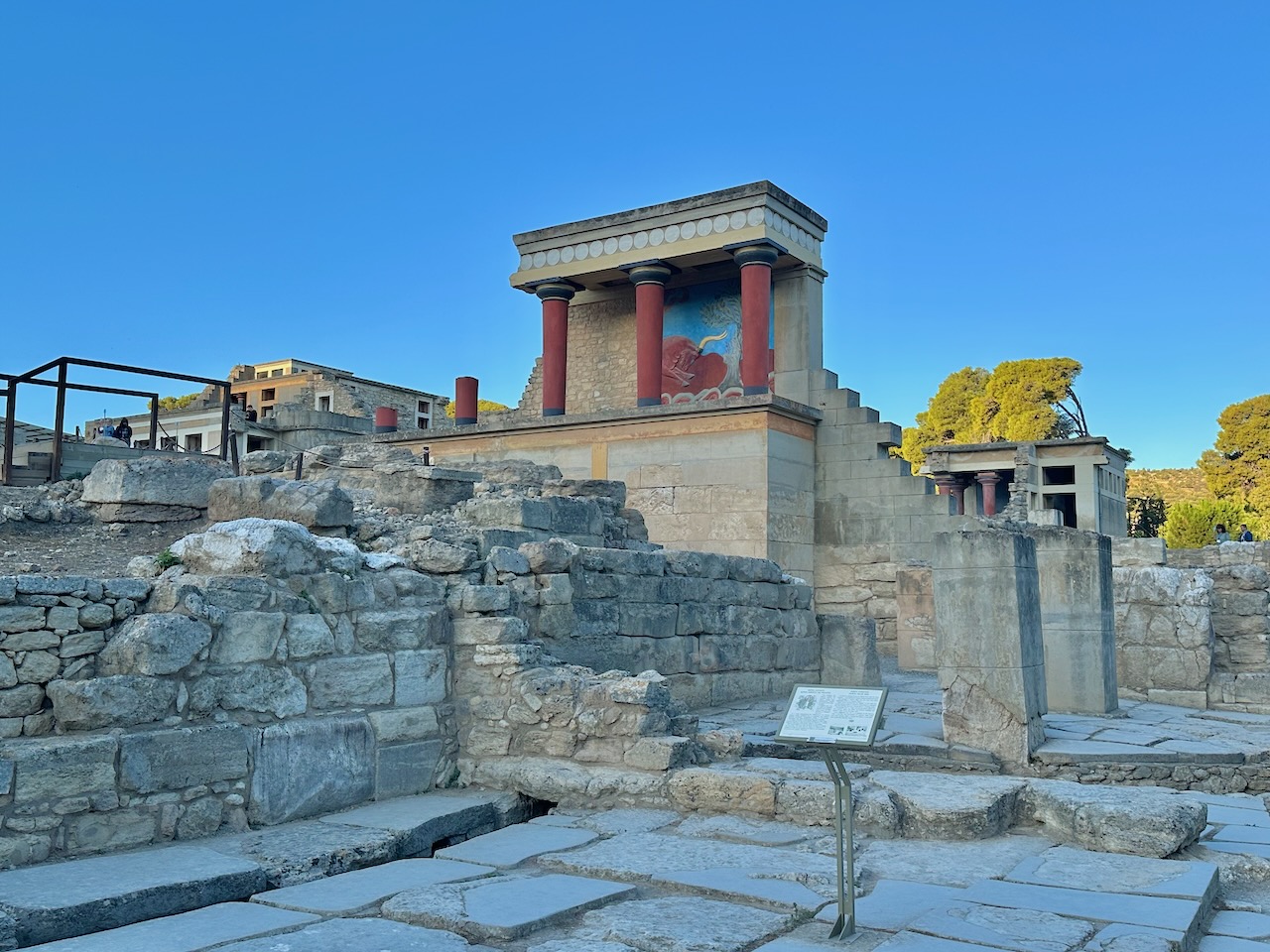
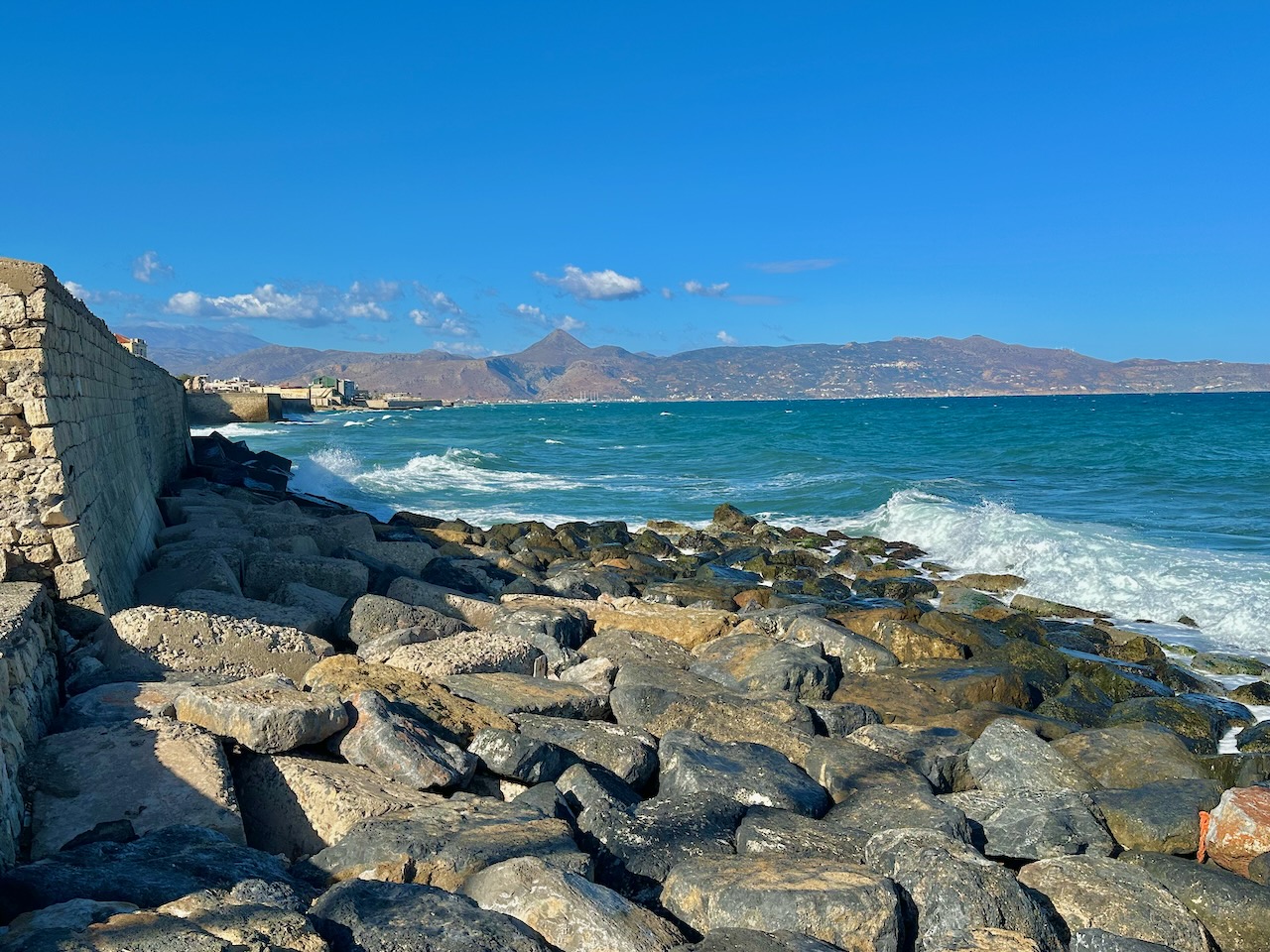

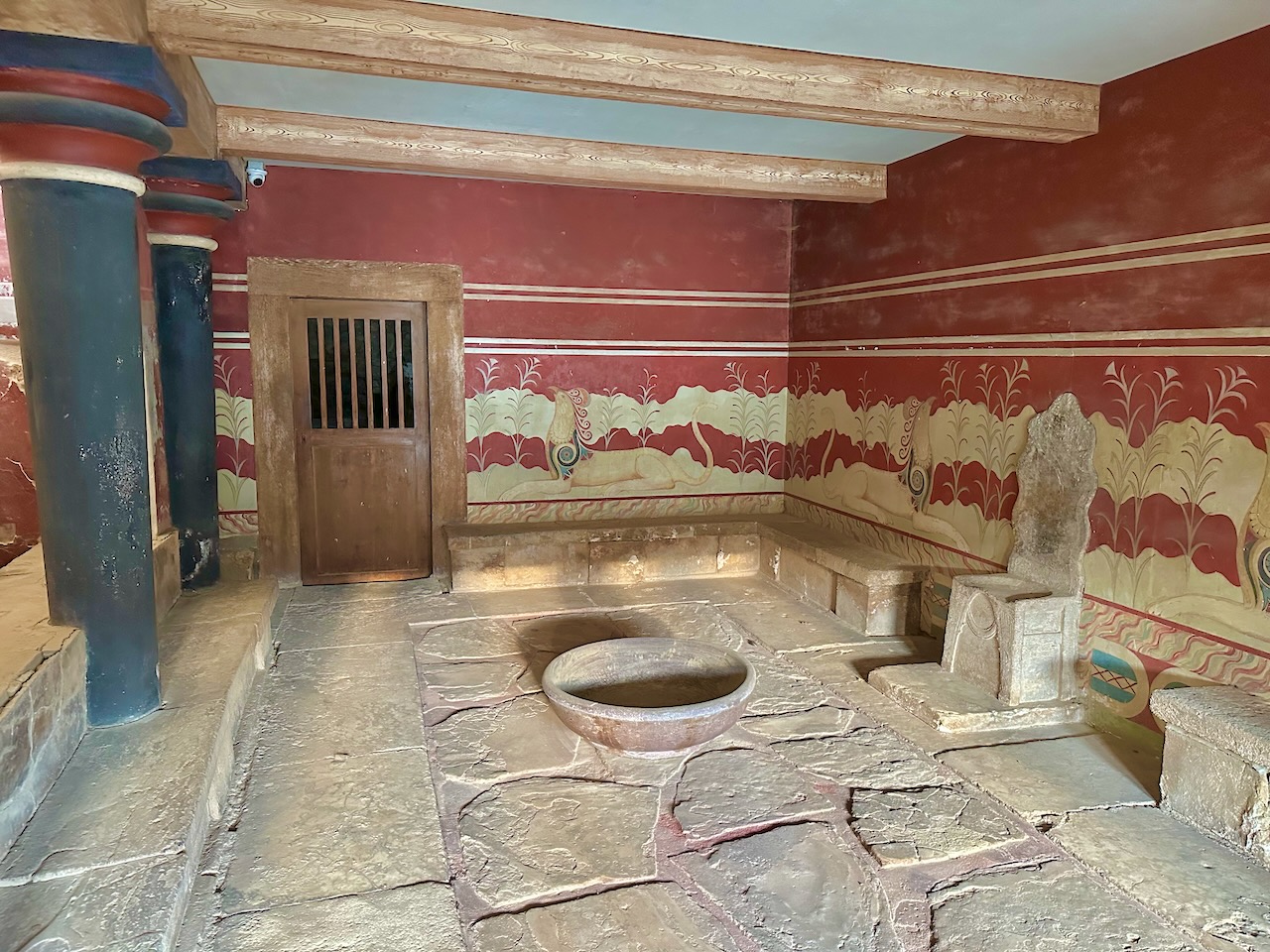
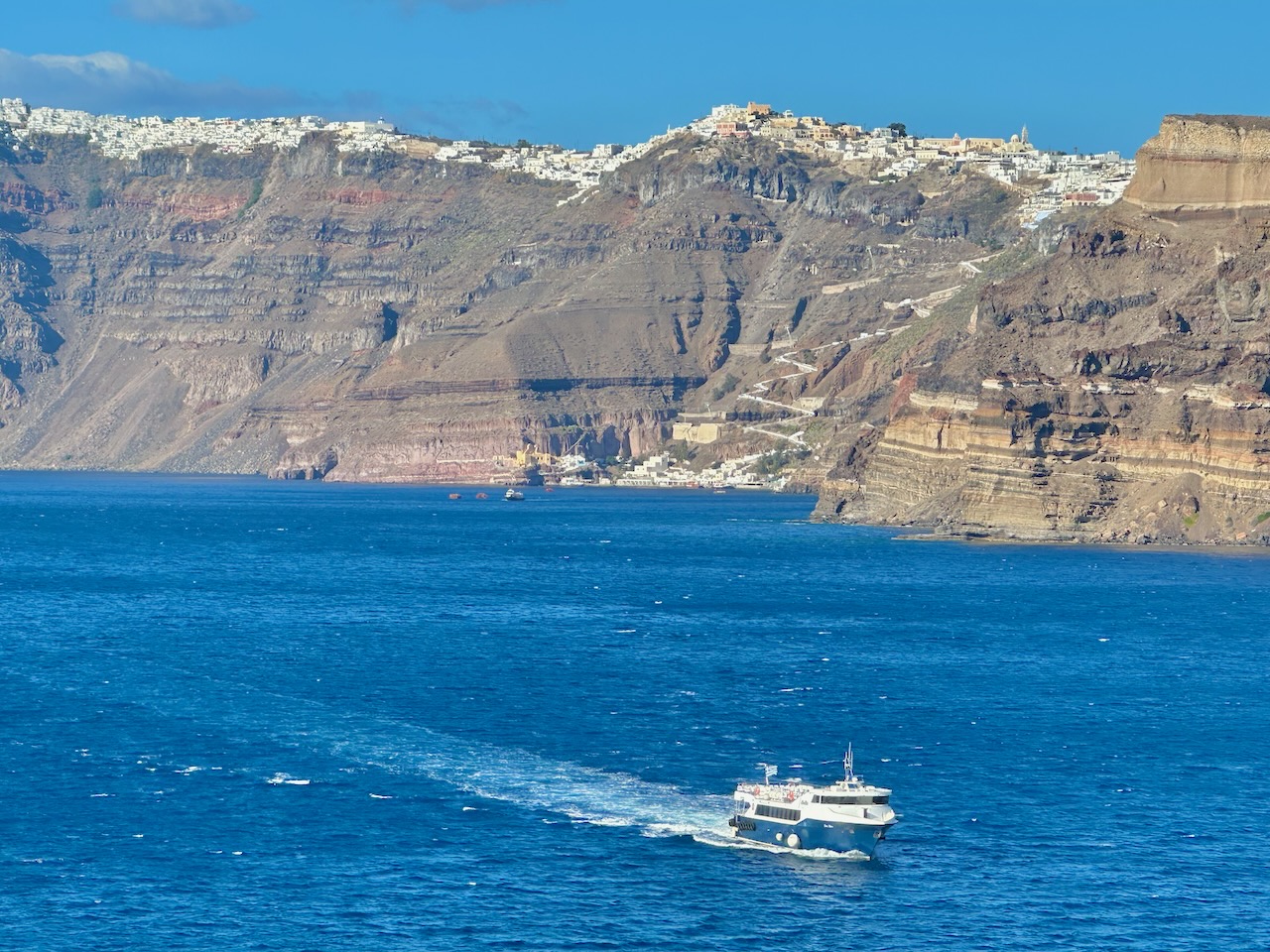
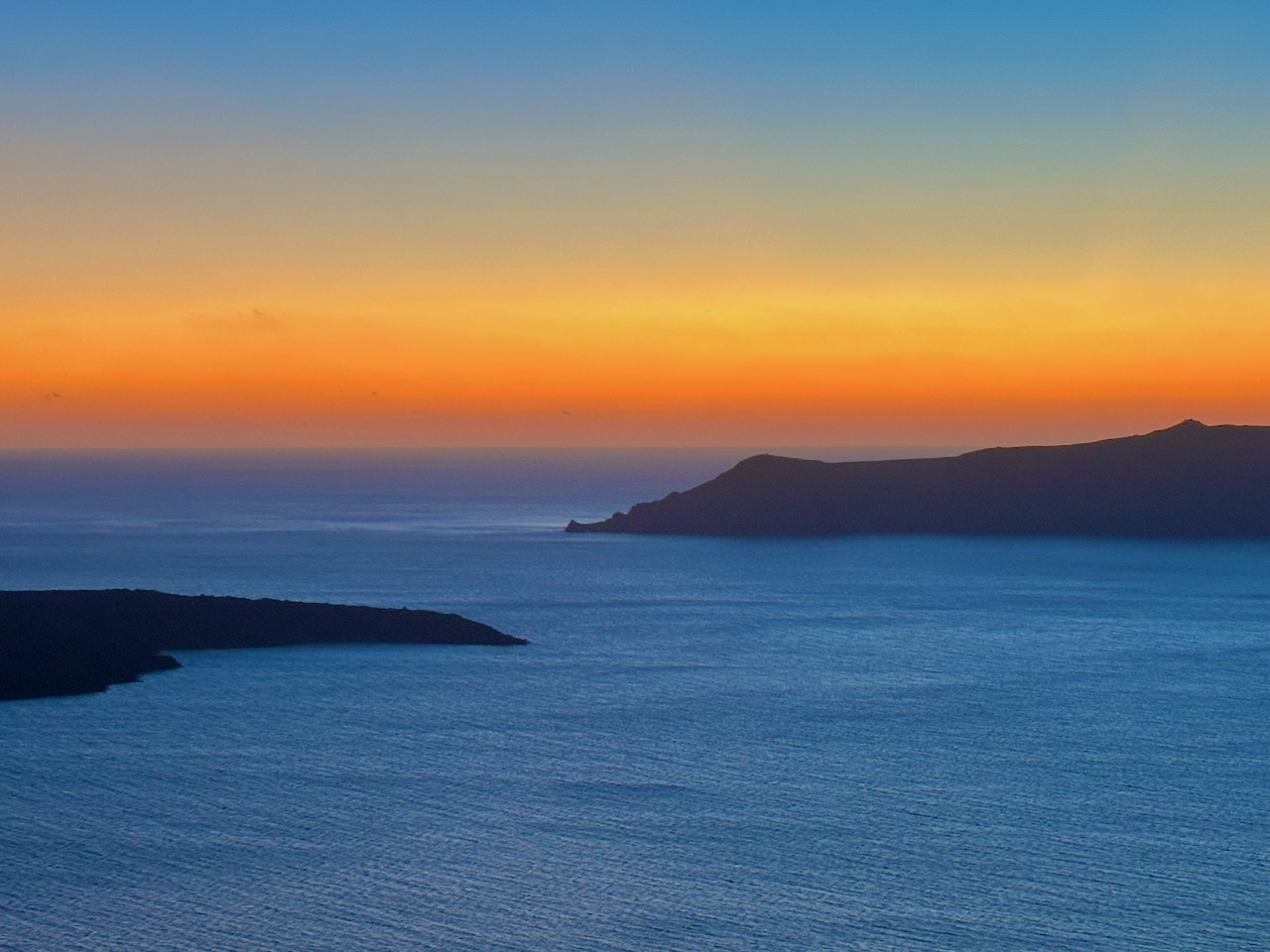
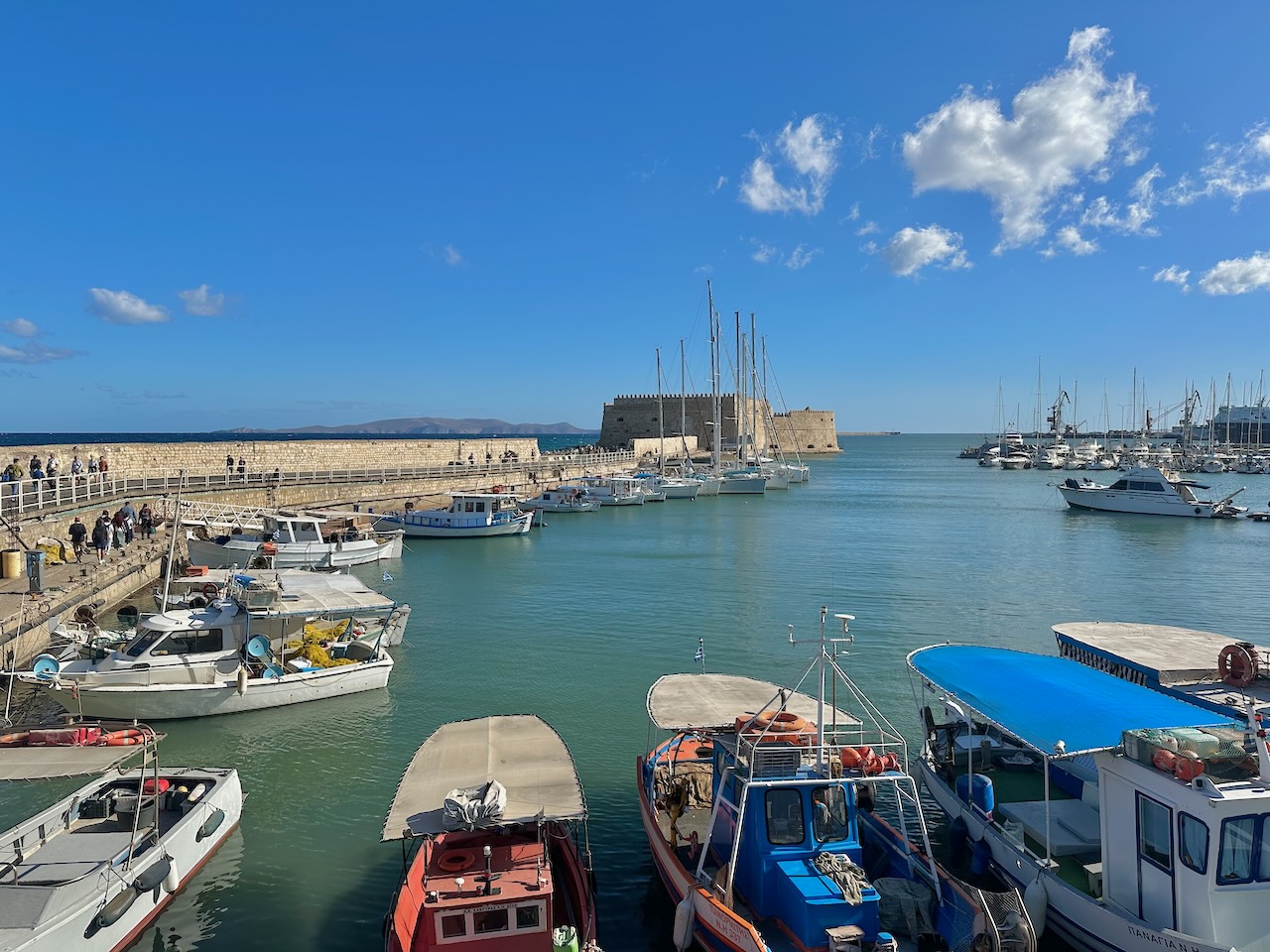
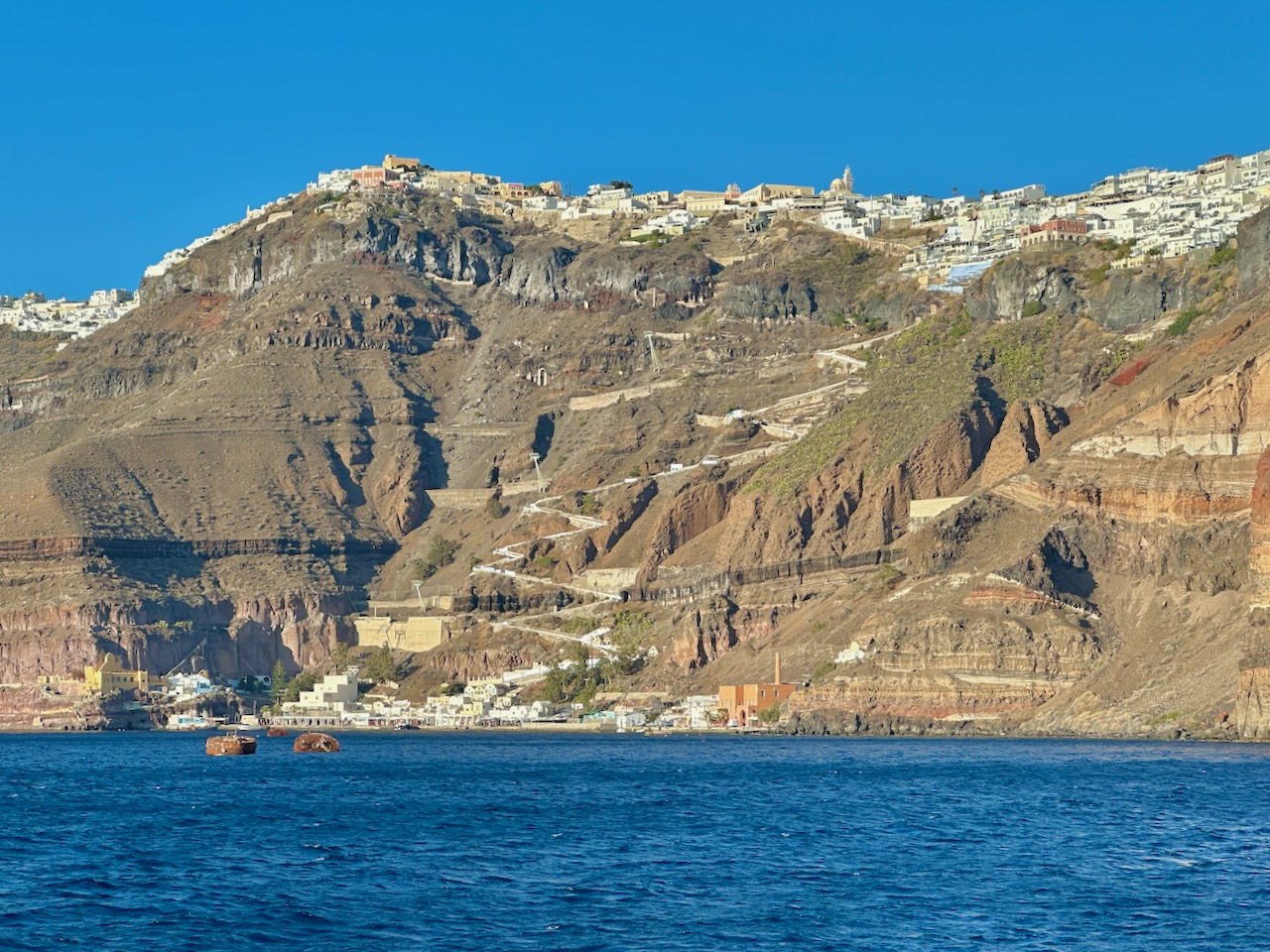
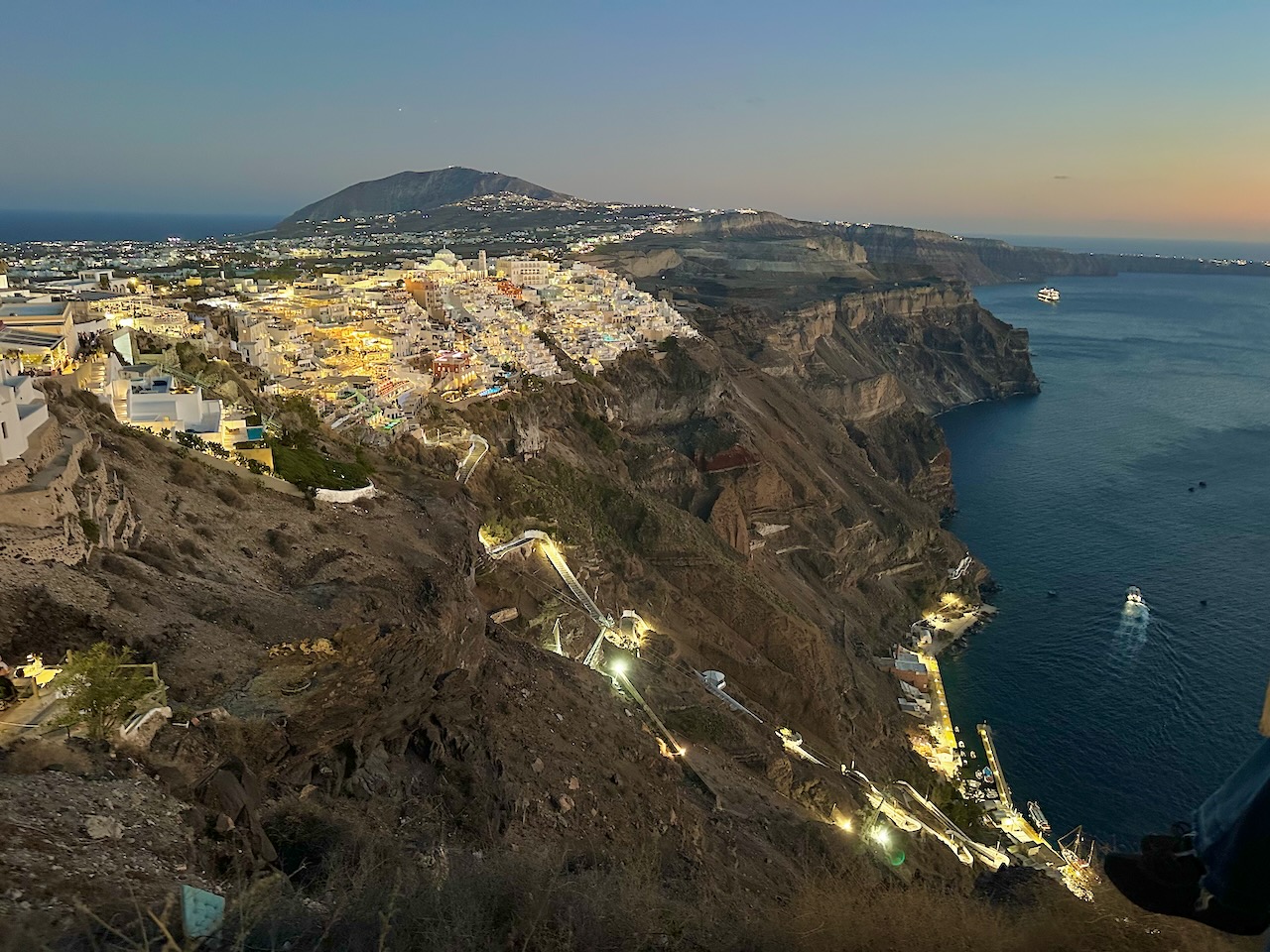
Day 10 – Monday, October 13: Athens, Mars Hill, Acropolis, the Plaka, Free Time
Today was our last full day in Greece and and our last day together as one large group. Following a final breakfast on the ship, we disembarked about 7:30 and loaded up our buses for our tour of Athens. Once again, we enjoyed perfect temps (in the low 70s), with mostly sunny skies in Athens. We read from Colossians 1 as we left the the port.
City Tour of Athens
It was about an hour and half drive that took us to downtown Athens. First, we enjoyed a brief bus tour of the city of Athens. We drove past by the Temple of Zeus, and the old Olympic stadium of Athens (made of all marble and restored for the 1896 Olympic Games) and Constitution Square.
Mars Hill
Next, we drove to the base of the Acropolis. Close by is the Rock of Areopagus (“Mar’s Hill) where Paul delivered his testimony. We climbed Mar’s Hill using the modern steps. Paul would have used the steps carved in the bedrock. From the top of this rocky escapement, we could see the Agora a bit closer-up, which included the Temple of Hephaestus and the Stoa of Attilos. We read Paul’s “defense” he gave (recorded in Acts 17) as he was seized and arrested and dragged/siezed (epi-lambano in Greek) before this legal court (similar to how Socrates was seized for teaching something new to children in 399 BC). Paul was not invited to join the Stoics and Epicureans for a philosophy discussion. His life was literally being threatened for what he was teaching. In the context of the pagan customs and culture of the day, Paul was quite bold in proclaiming Christ here. Praise God for those who heard and responded to Paul’s message that day!
Acropolis/Parthenon
From here we began our climb to the top of the Acropolis. We past the odeon (small theater that held 5,000) and the Temple of Nike, and then through the Propylea (“gate-way” marked with huge pillars today). Reaching the top we saw the Erechtheum (a temple built in 421-406 BC honoring Athena, Poseidon, Zeus, and Erechtheus a local goddess) and the Parthenon (built between 447-432 BC). Looking down on the top from the Acropolis in all directions we could see the Temple of Zeus, the Stoa, the Agora (the center of economic and public life), and Mt. Lycabetus (that some in the group climbed earlier this week).
Descending down off the Acropolis we re-gathered and walked to Hadrian’s Arch. For the next two hours (on our own) we walked into the Plaka where we enjoyed grabbing our last gyro, Greek salad here, and last-minute shopping. We returned back to Hadrian’s Arch to be picked up by our buses. From here drove to the Titania Hotel for the rest of the afternoon. Following dinner we said goodbye to those not doing the Turkey extension (since those who are have a very early morning flight to Istanbul. Those not doing Turkey have various-timed flights back to the States in the morning. It was a great Greece trip with a wonderful group!
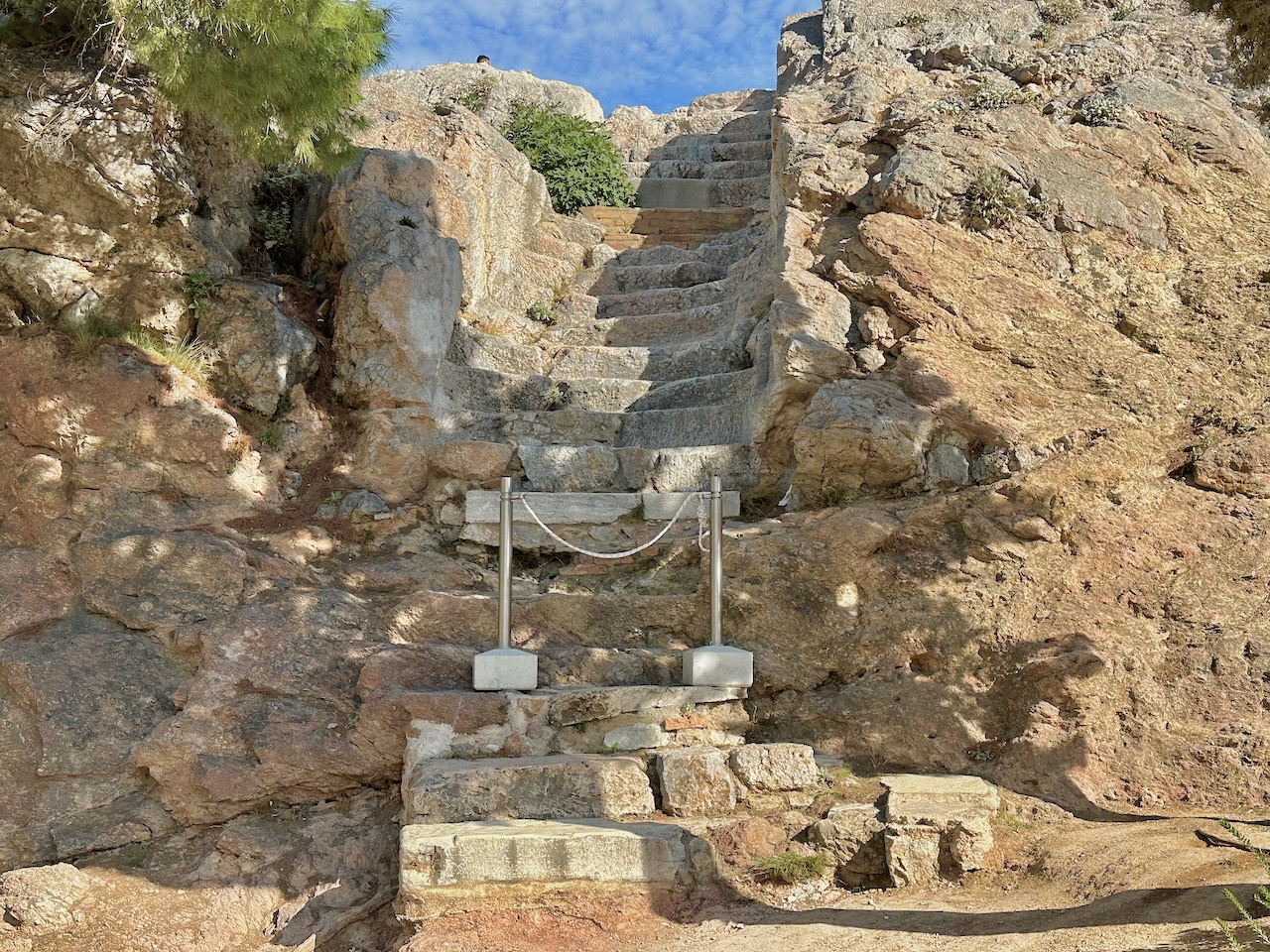
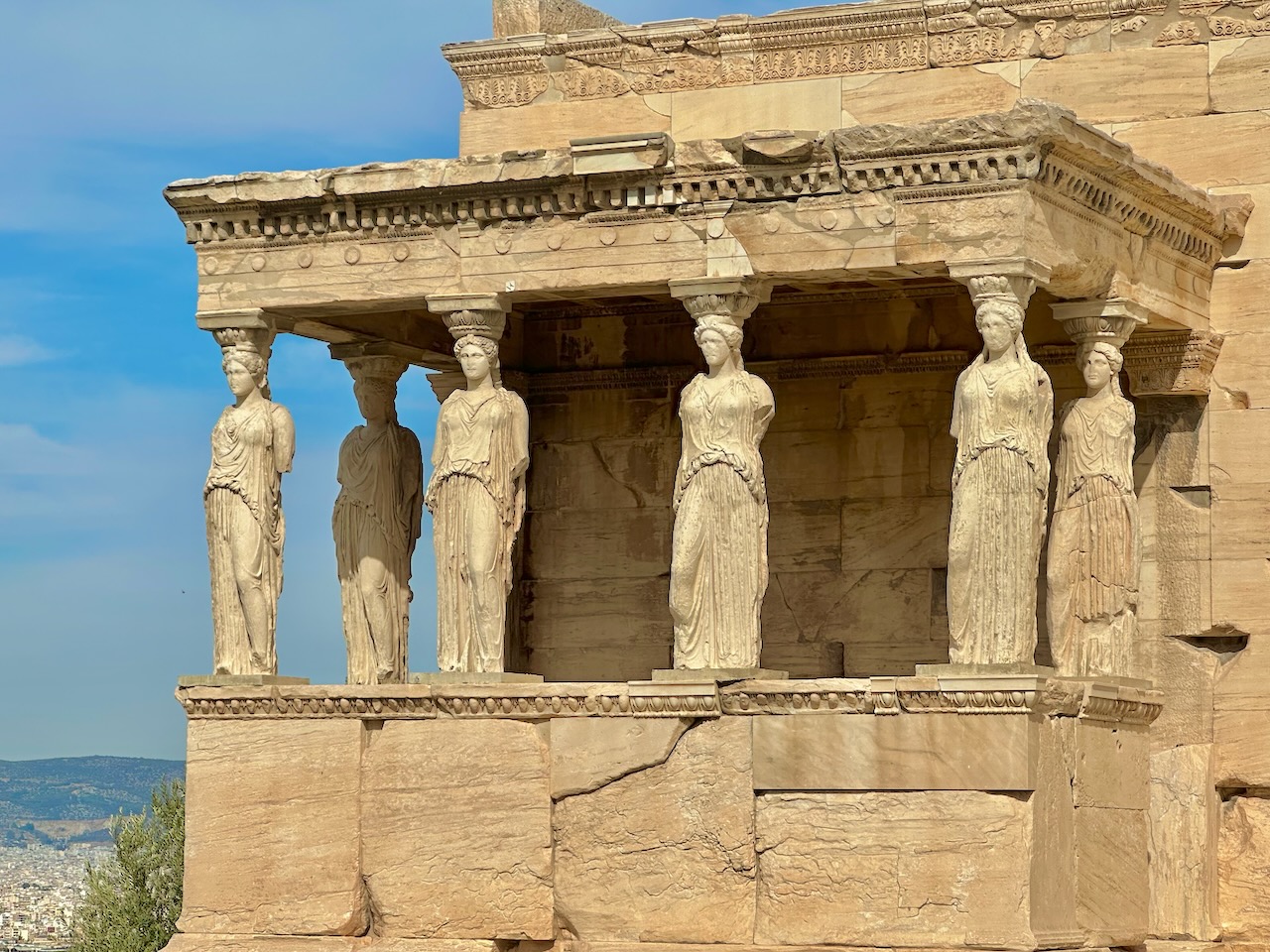
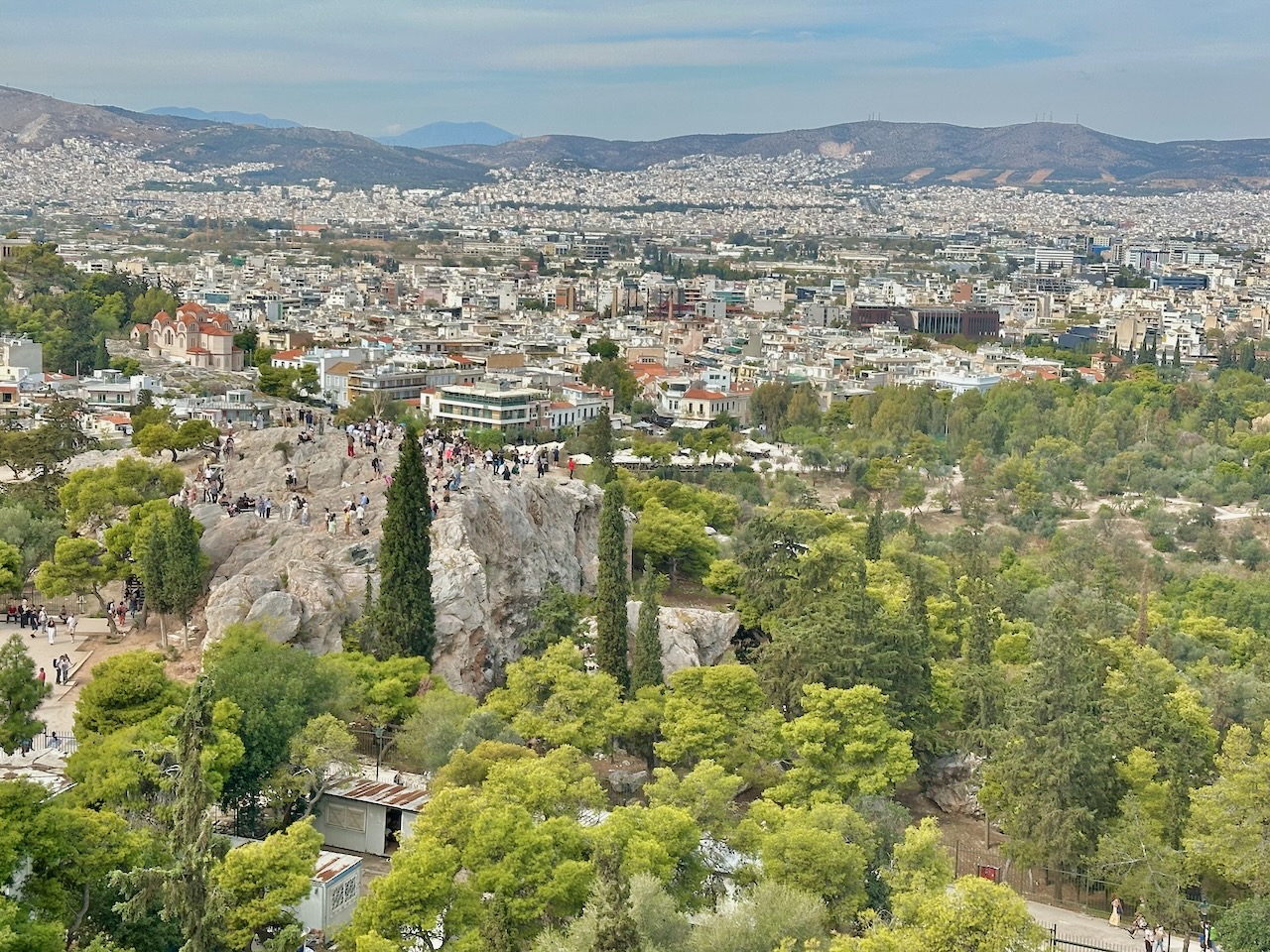
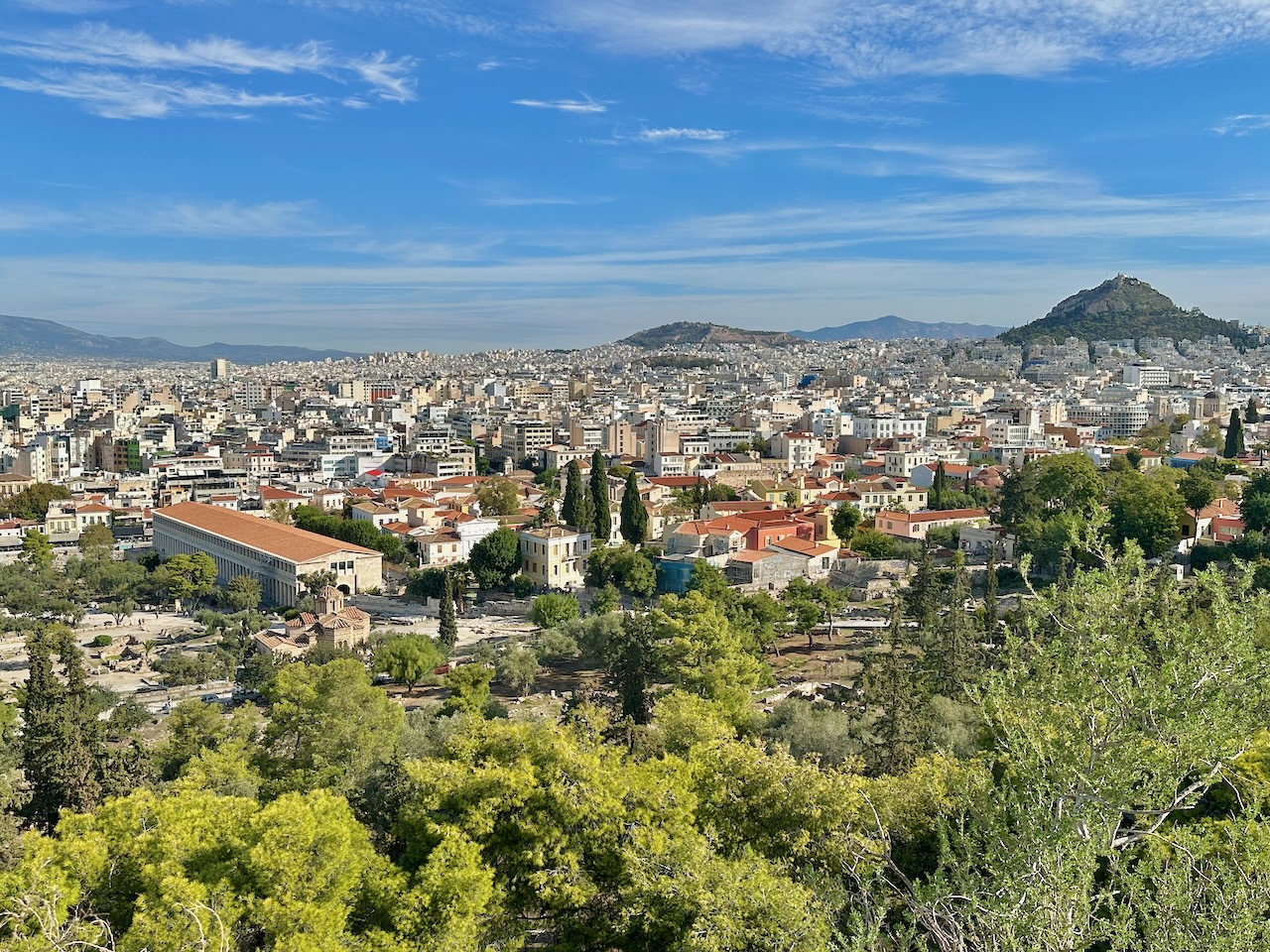
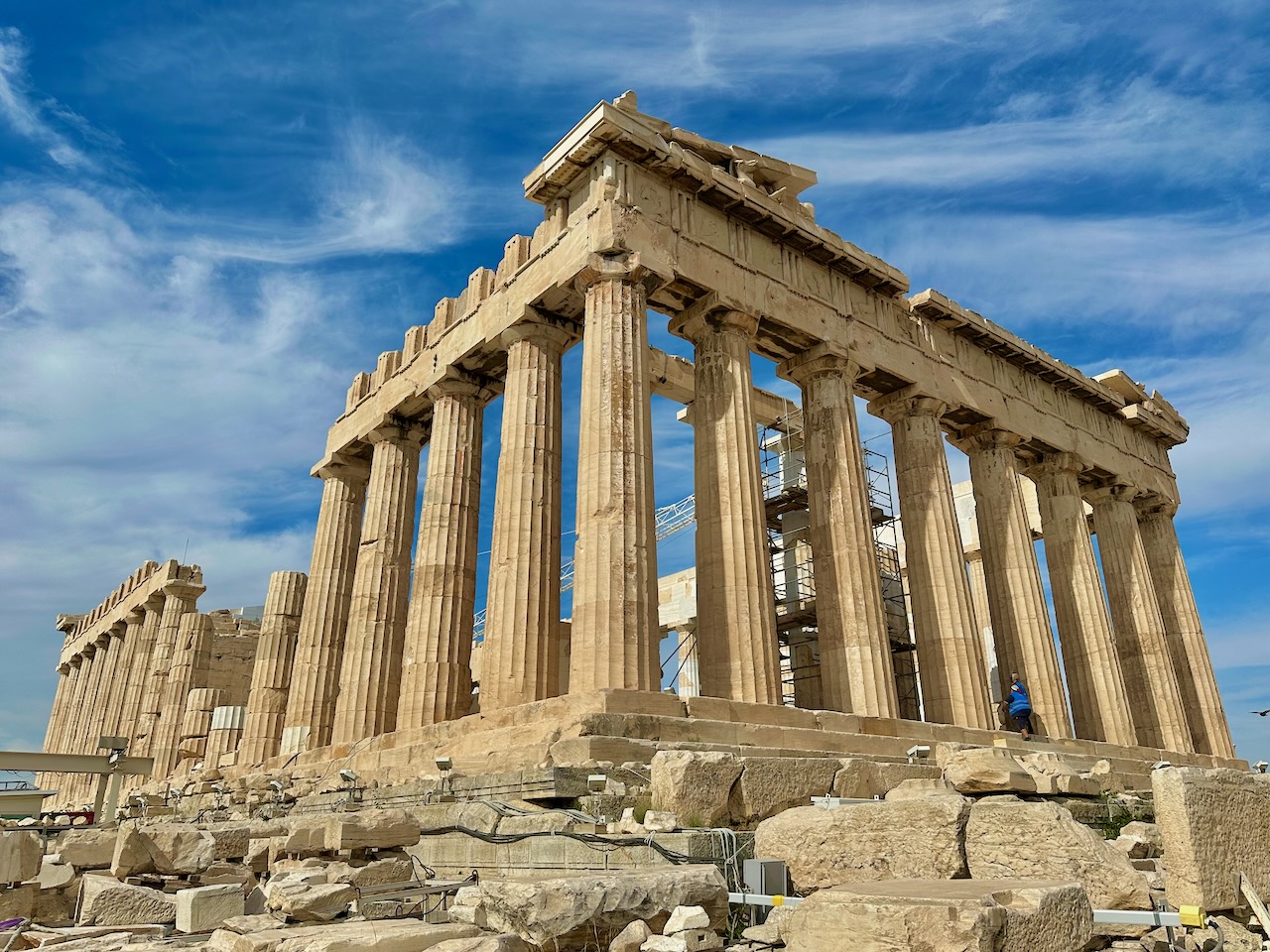
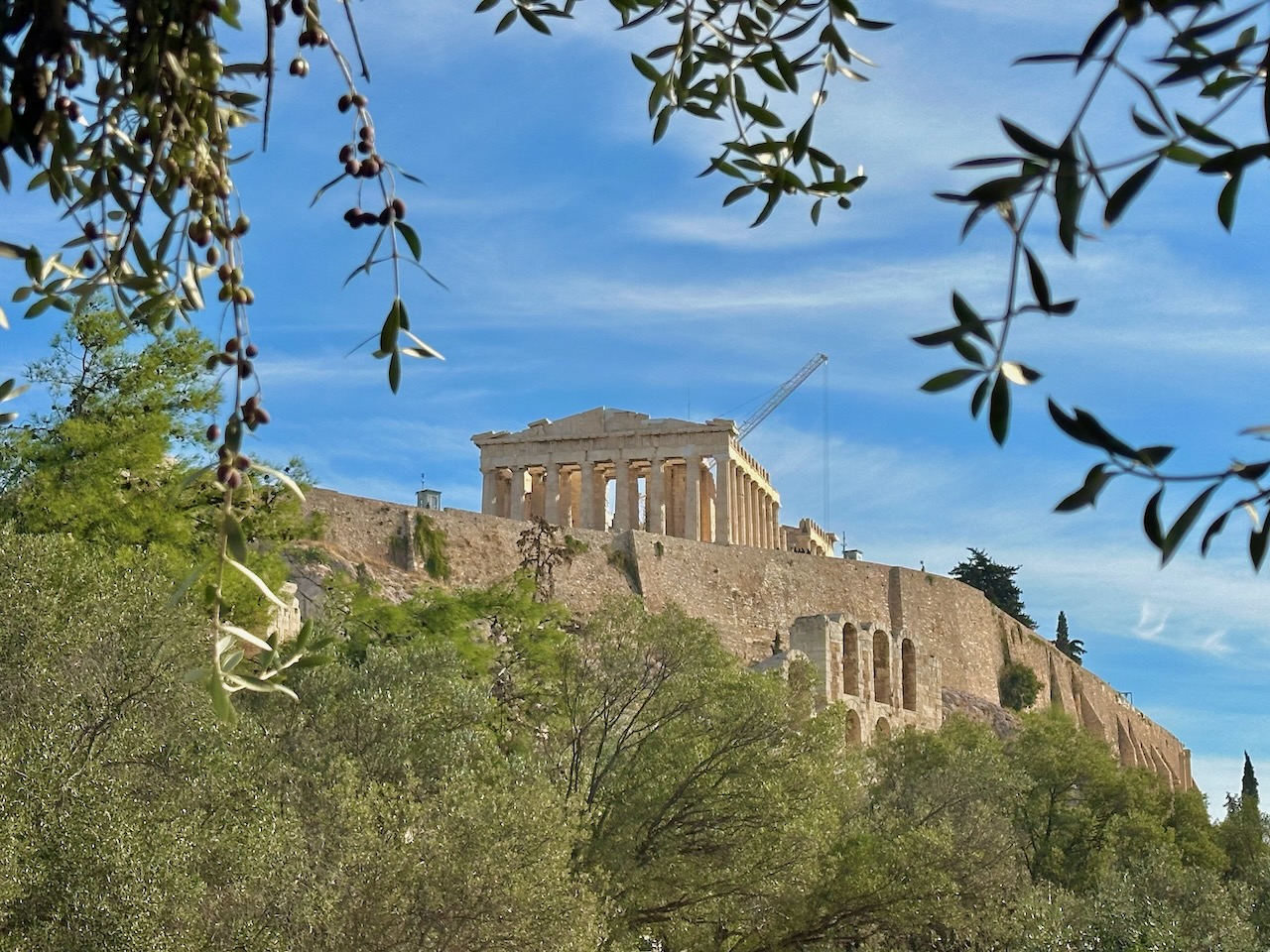

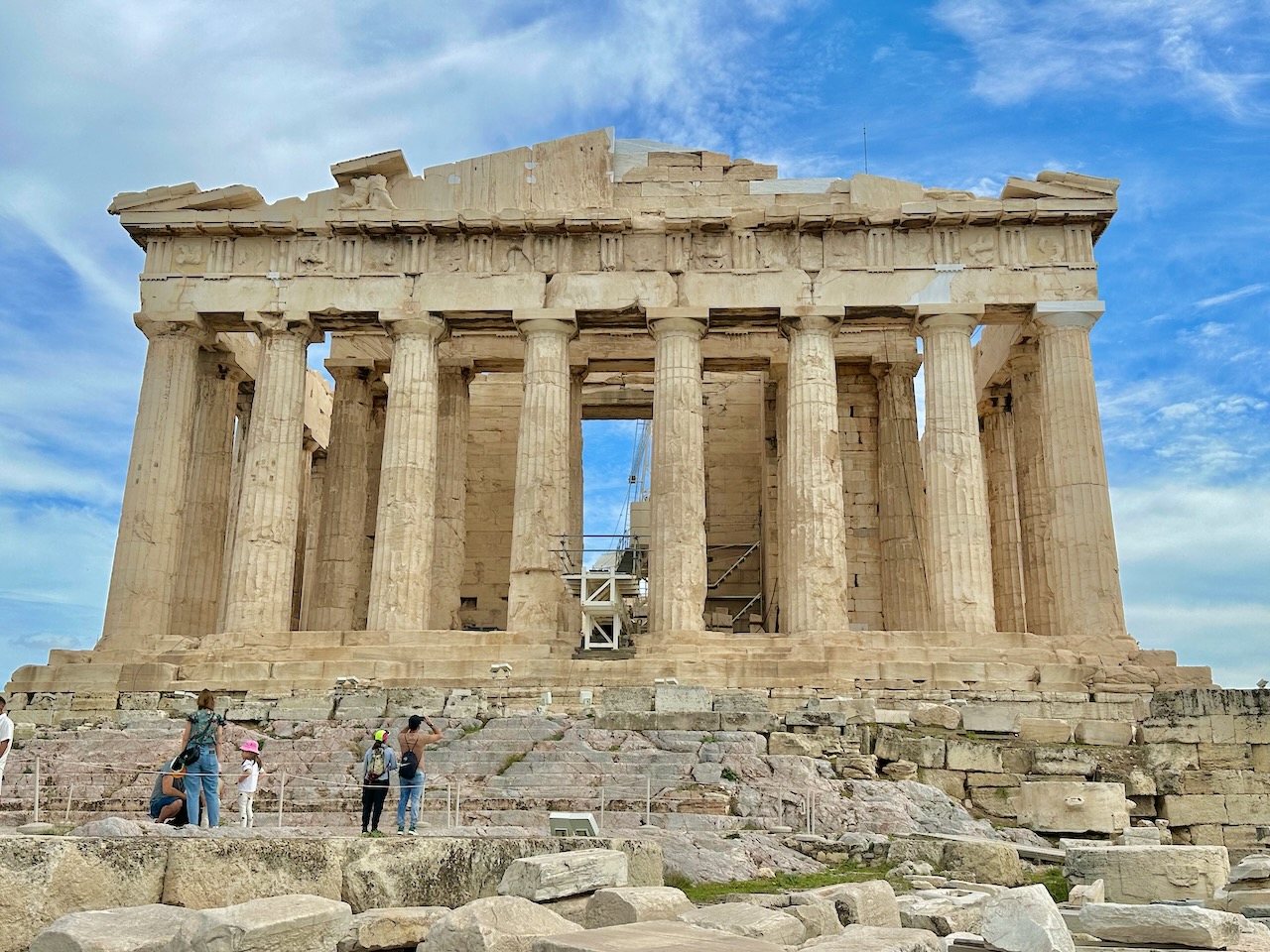
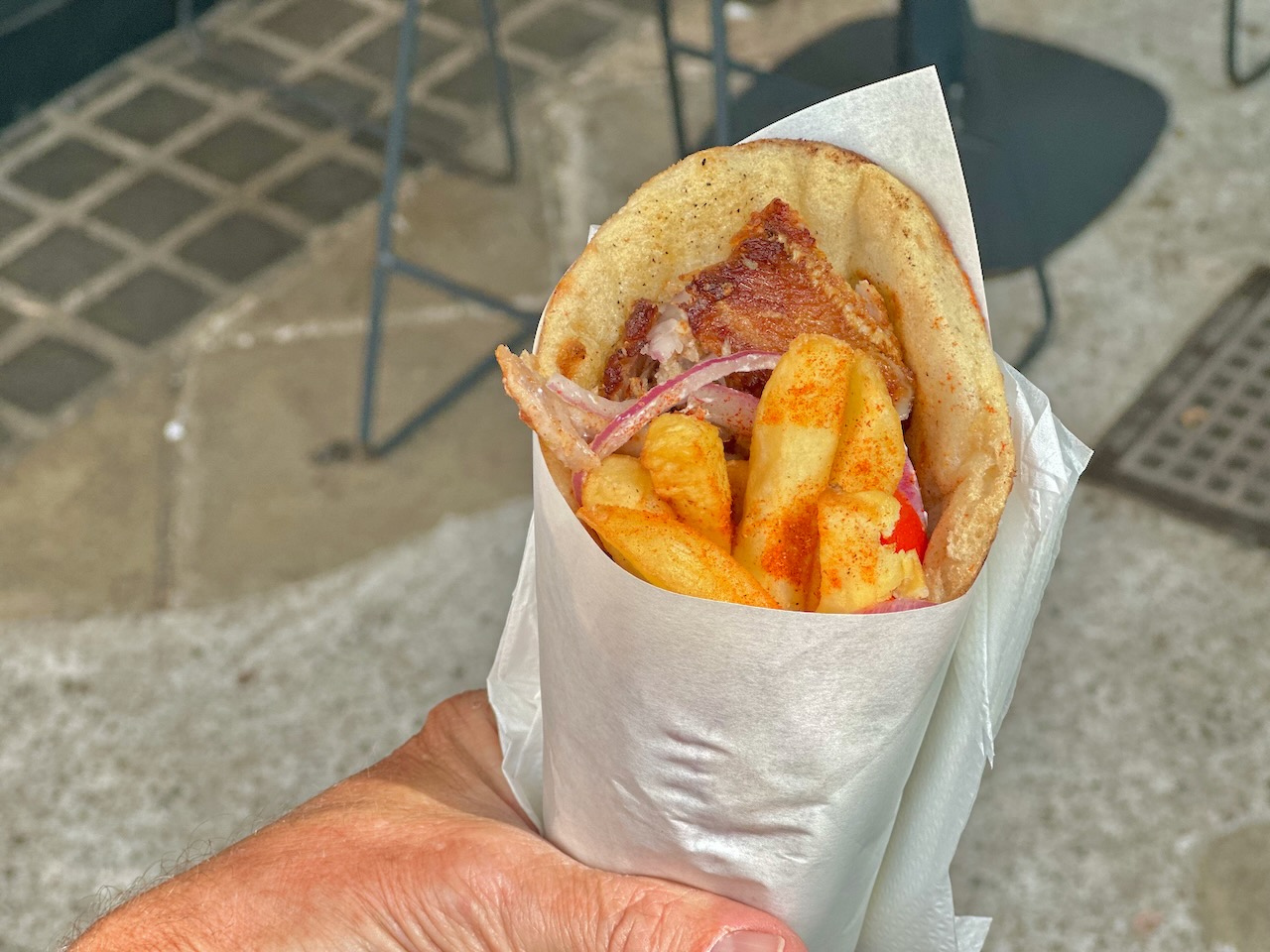
Day 11 – Tuesday, October 14: Flight Home/Turkey Extension
Today about half the group flew back to home, while 29 of us continued our journey to Turkey for the purpose of seeing the other six (6) Churches of Revelation (and a few other biblical sites). Those flying back to the States used different flights and departed at various times. Those going to Turkey left the hotel at 1 am.for our 3:55 a.m. flight to Istanbul, with a connecting flight to Izmir. The weather for this first full day of the Turkey extension was once again pleasant, with partly sunny skies and highs around 70.
Pergamum
Once we landed in Izmir, Turkey (at 8:15 a.m.), we met Isa our Turkish guide (we had him at Ephesus a few days ago) and then boarded our bus. We drove about 1.5 hours towards Pergamum, the third of seven “Churches of Revelation” mentioned in Revelation 2-3. On the way we stopped at a very unique onyx store owned by Orthodox Christians who knew Pastor John’s Armenian Patriarch friend (Mesrob) when he was in Jerusalem 44 years ago. What a small world!
At the site of Pergamum, we took the cable car to the acropolis. What an amazing view from here! We saw many temples (Trajan Athena, Demeter, etc.). We also saw the altar of Zeus, most likely referred to in Revelation as the “throne of Satan.” Most impressive was the theater. It was the steepest in the Greek and Roman world and could hold 10,000. A few of us carefully climbed down the steps and back.
Asclepion
Following lunch at a very Turkish restaurant, we drove a short distance to the site of Asclepion. It was dedicated to the Asclepius, the healing god. Here we saw the colonnaded street, many pillars, the theater, and the “hospital” where the physically and mentally sick were treated.
From here we drove about two hours back to Izmir. We checked into our hotel in Izmir and enjoyed a wonderful dinner together. We had a tiring day of travel, but are grateful for the encounters and safety.

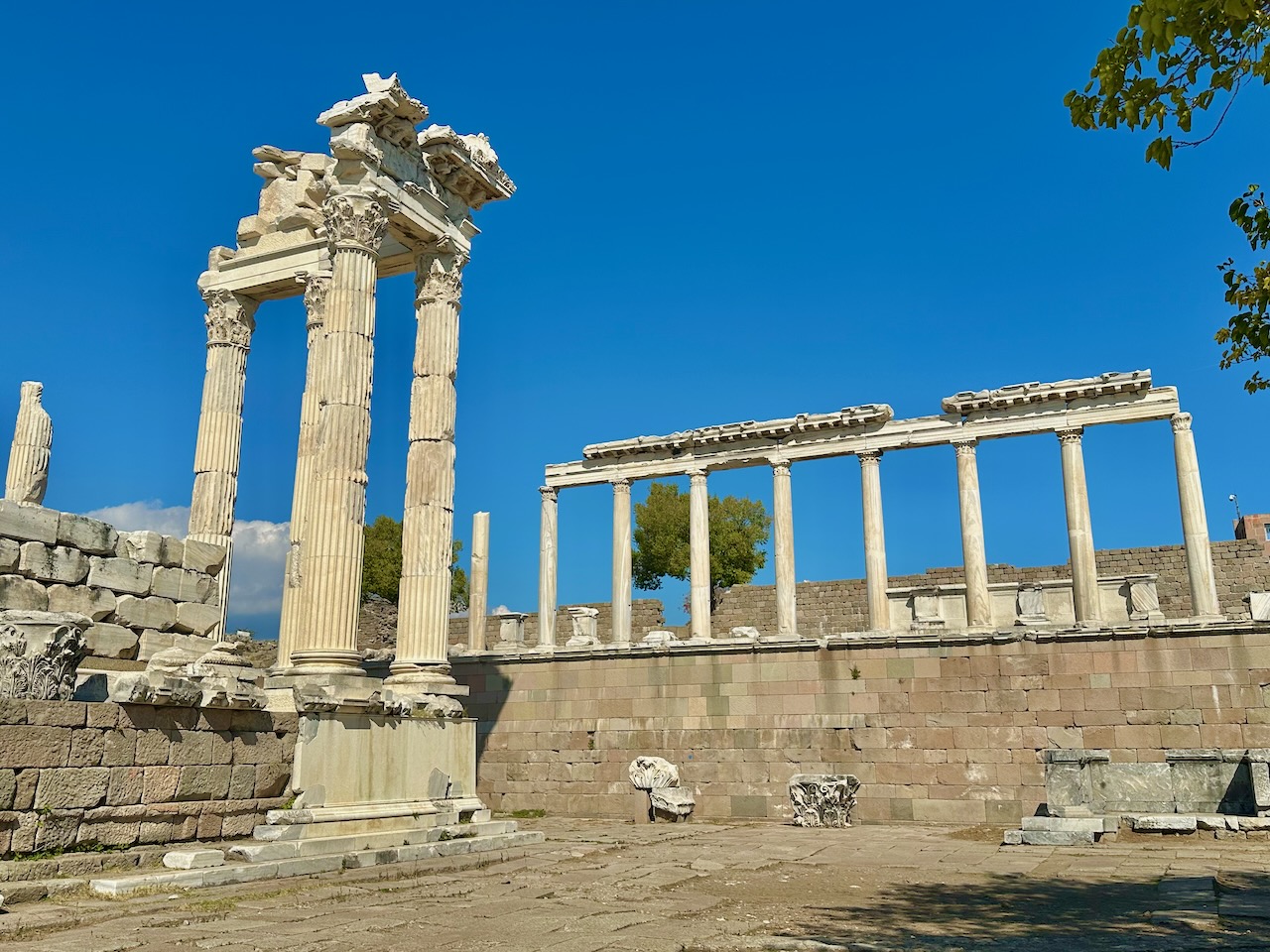
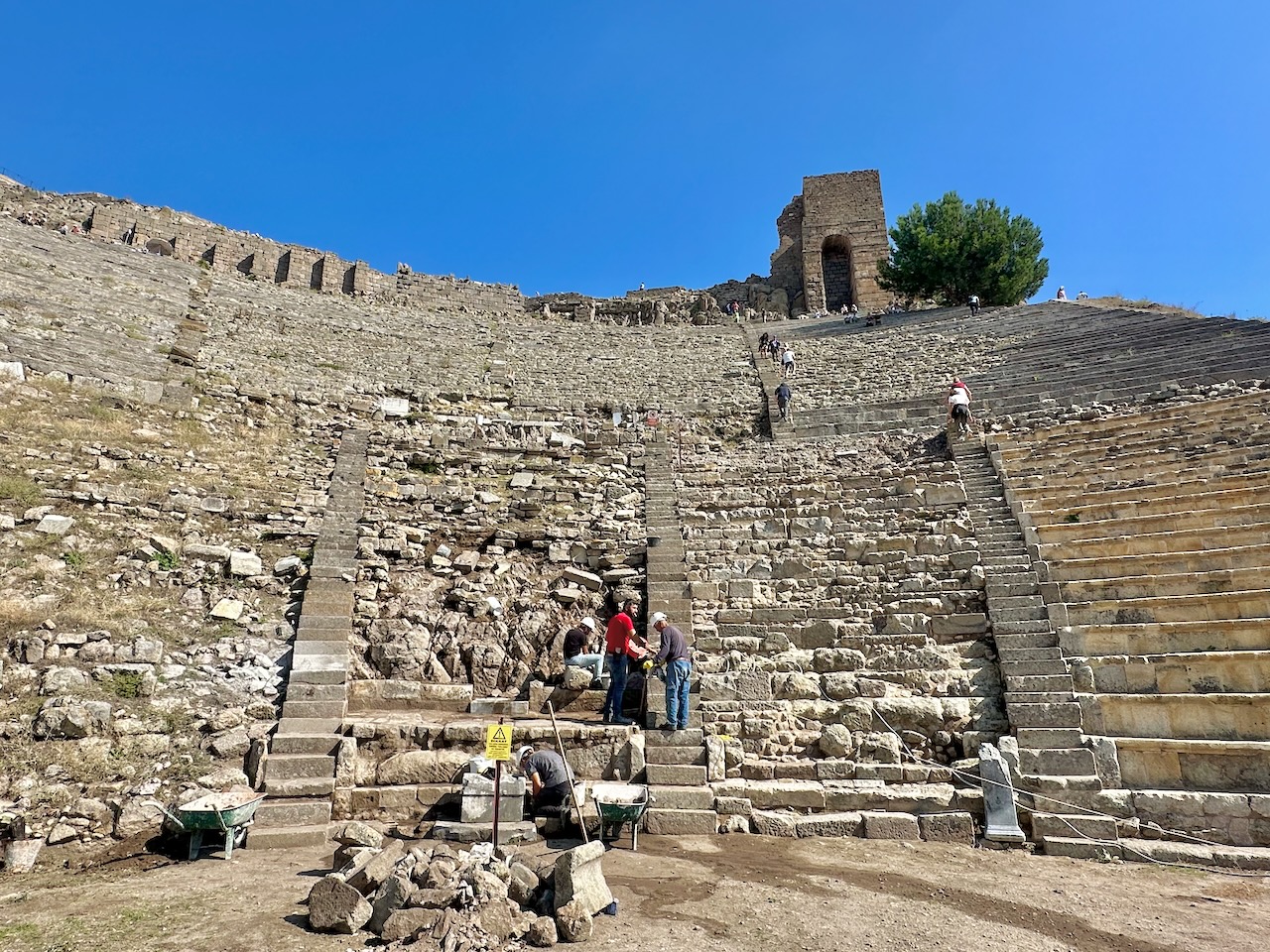
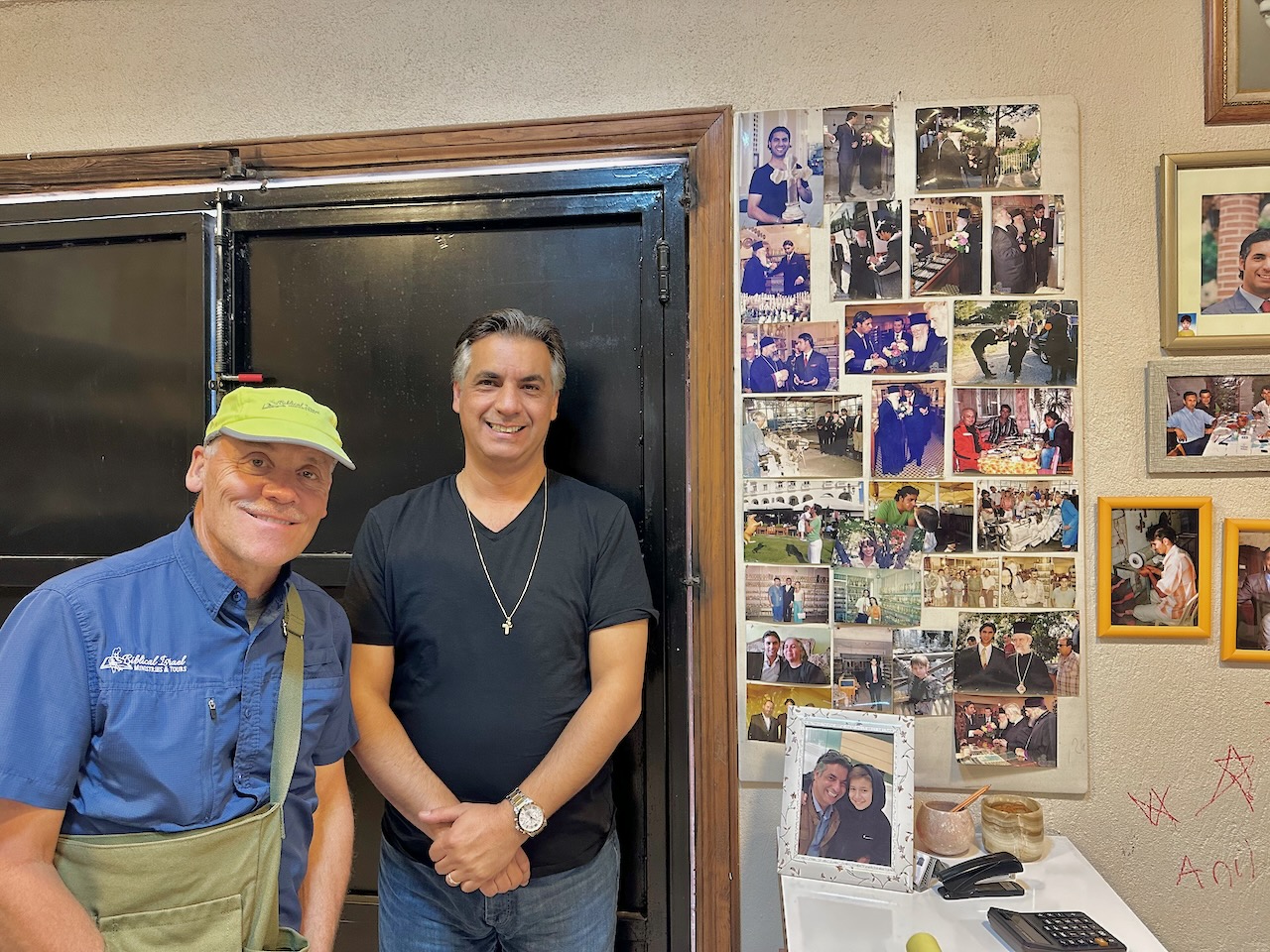



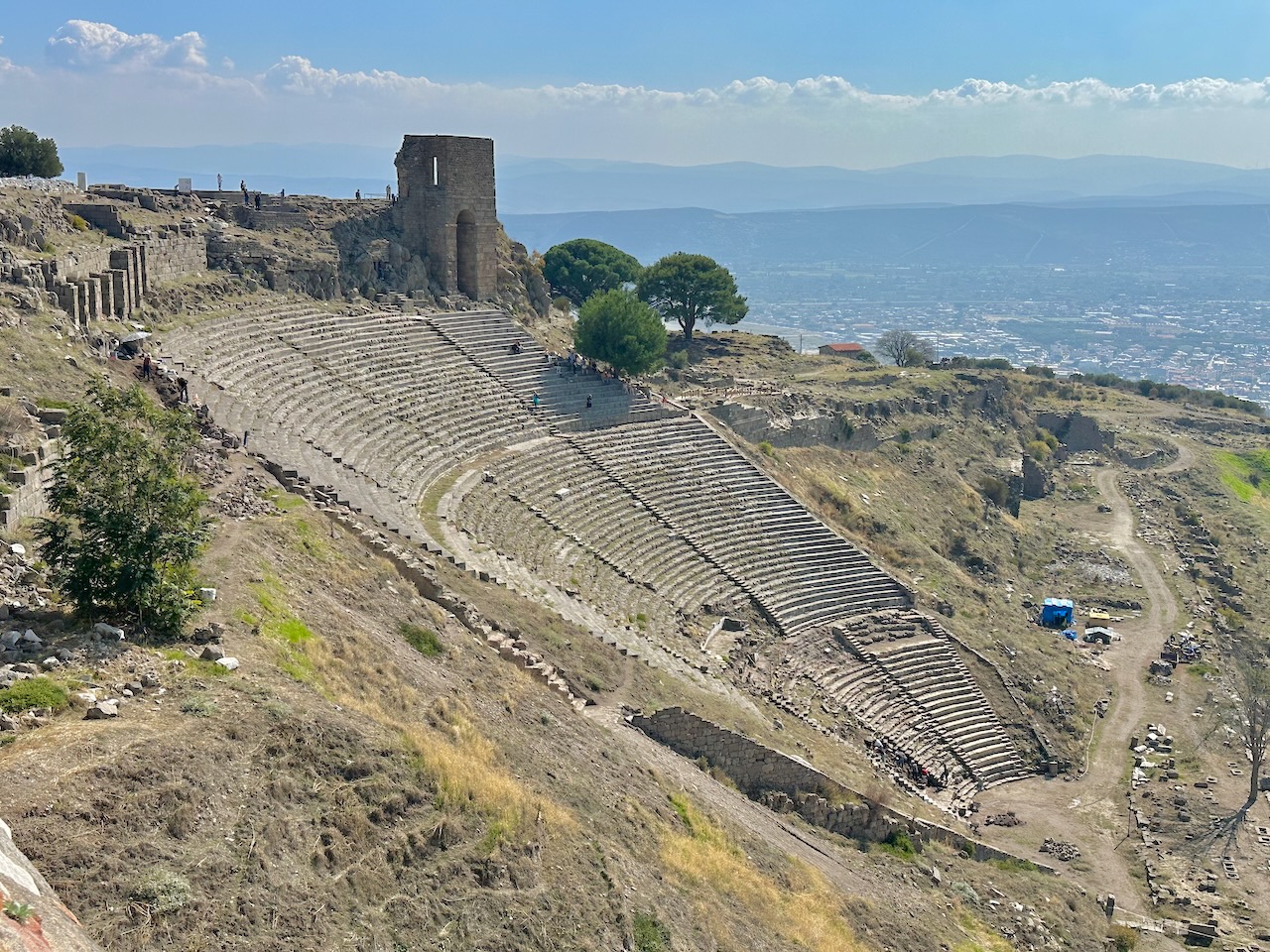
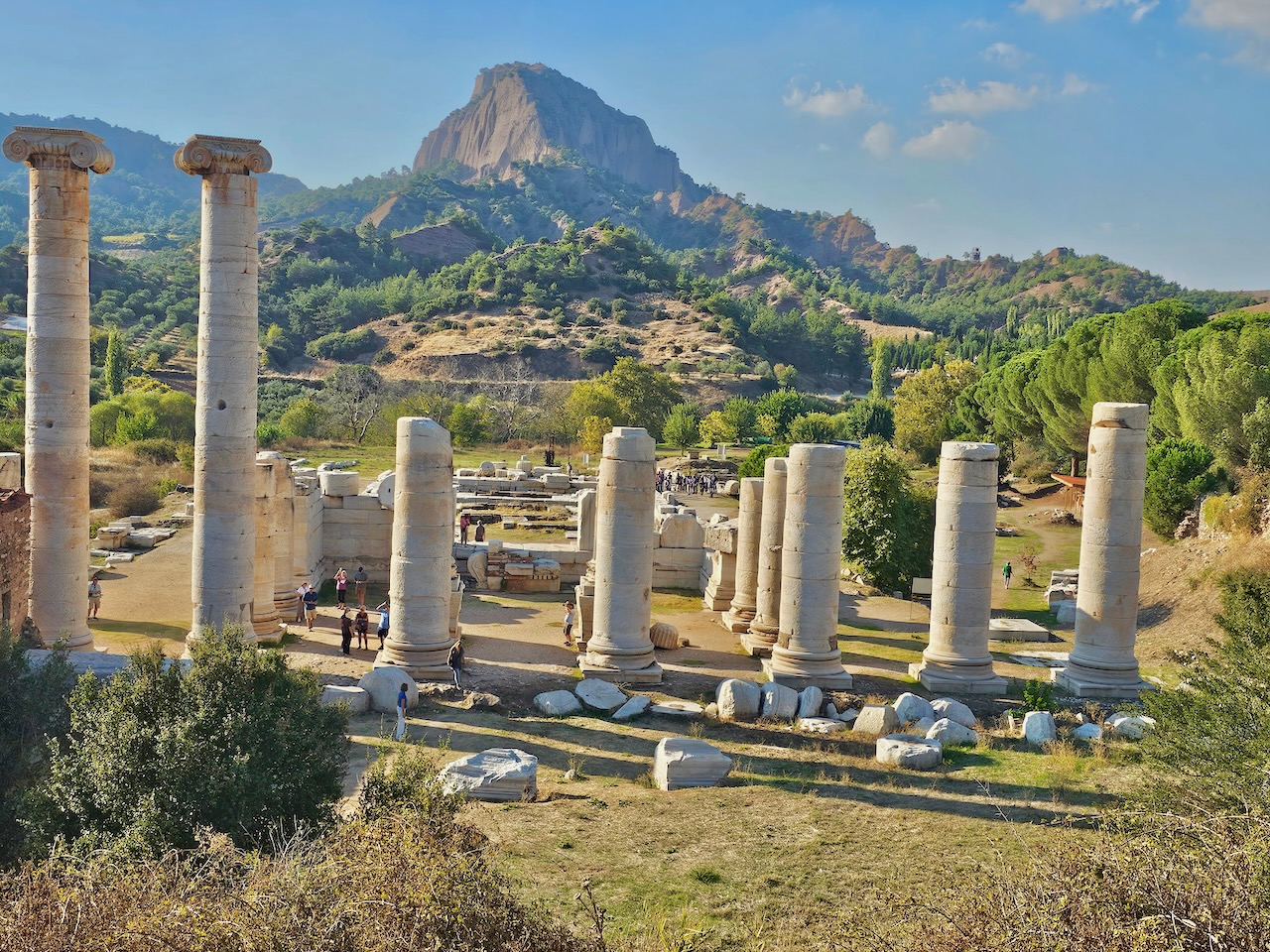
Day 12 – Wednesday, October 15: Izmir, Thyatira, Sardis, Philadelphia, Pamukkale
Today was our second full day here in Turkey. We travel a long distance today, visiting four of the seven Churches of Revelation along the way. Our final destination was Pamukkale. The weather was a little warmer actually (mid 70s) following a cooler morning (50s), with partly sunny skies.
Izmir/Smyrna
Following breakfast and after we loaded the bus with our luggage, we began our walk to the agora of ancient Smyrna. It is located within the modern city of Izmir. We read from Revelation 2:8-11 inside the agora area of the city. We also saw many of the well-preserved arches of the side shops.
Thyratira
Upon boarding the bus again, we read from Hebrews 12 and sang our usual morning song as we drove about 45 minutes east to the next site, Thyatira. Within the site we read from Revelation 2:18-29. Like Smyrna, this site has only limited ruins, mainly from the Late Roman / Byzantine Period, although arches from the time of Alexander the Great (4th century BC) can still be seen. We met David Stott (author of Driving Through History). He was there recording a piece to be aired next May, 2026.
Sardis
We drove about an hour to our next stop, Sardis. Before we arrived we enjoyed another ver nice Turkish lunch. The visit included walking through the ancient synagogue (3rd century AD) with amazing mosaics and the gymnasium. Driving to the other area of ruins, we also saw the huge and most impressive Temple of Artemis. This temple once had about 120 massive pillars. It dates to the 4th century BC. We read Revelation 3:1-6 here.
Philadelphia
Our last site of the day was Philadelphia. It is located 45 minutes east of Sardis. Only two large arches remain among the limited ruins. There was also an inscription with “Philadelphia” in Greek. We read from Revelation 3:7-13 outside the site.
It took about an hour and a half on the road to arrive at our hotel in Pamukkale. It is a very nice hotel. We enjoyed a buffet dinner together. Some even took the opportunity to enjoy a Turkish Bath.

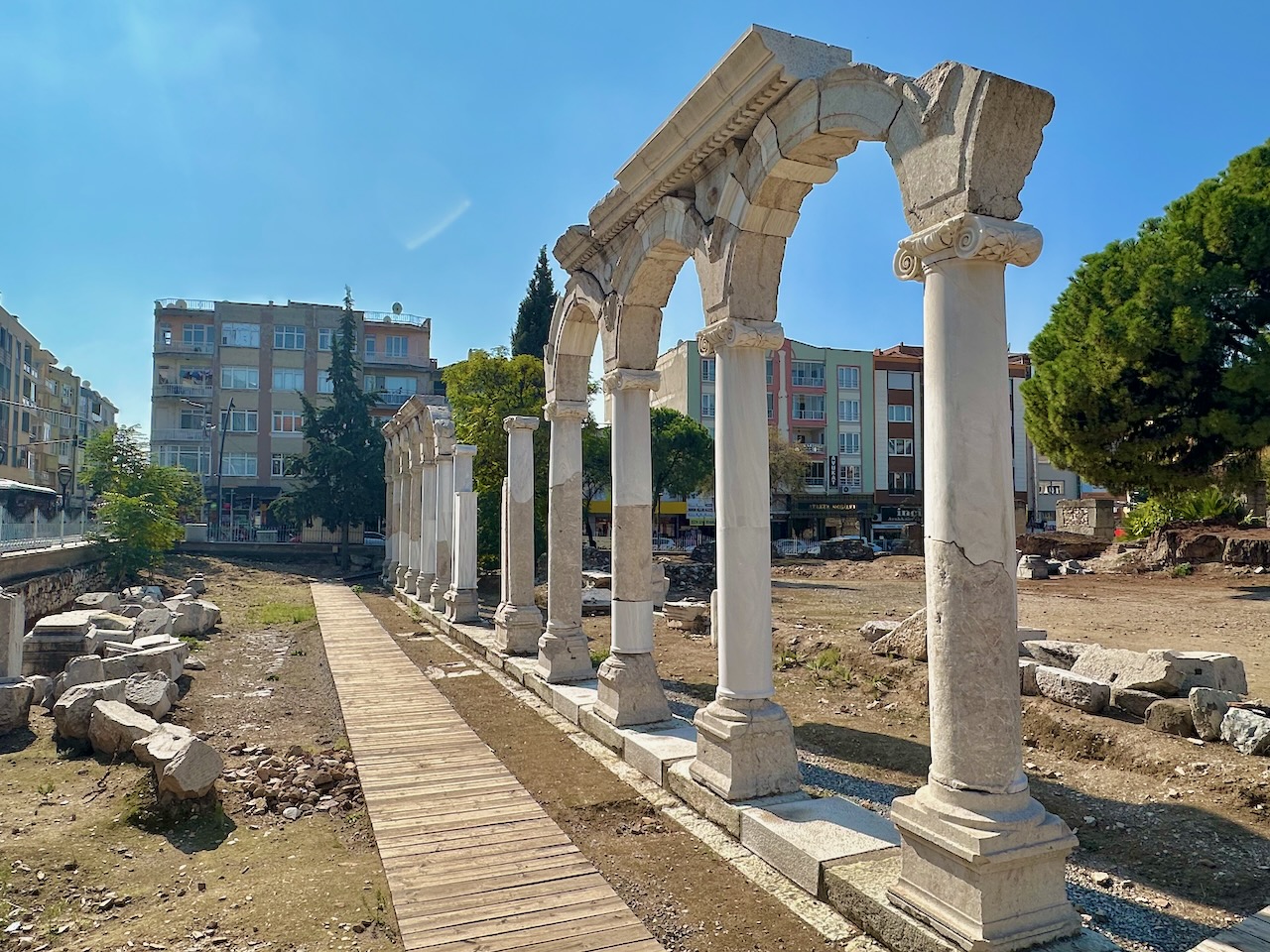


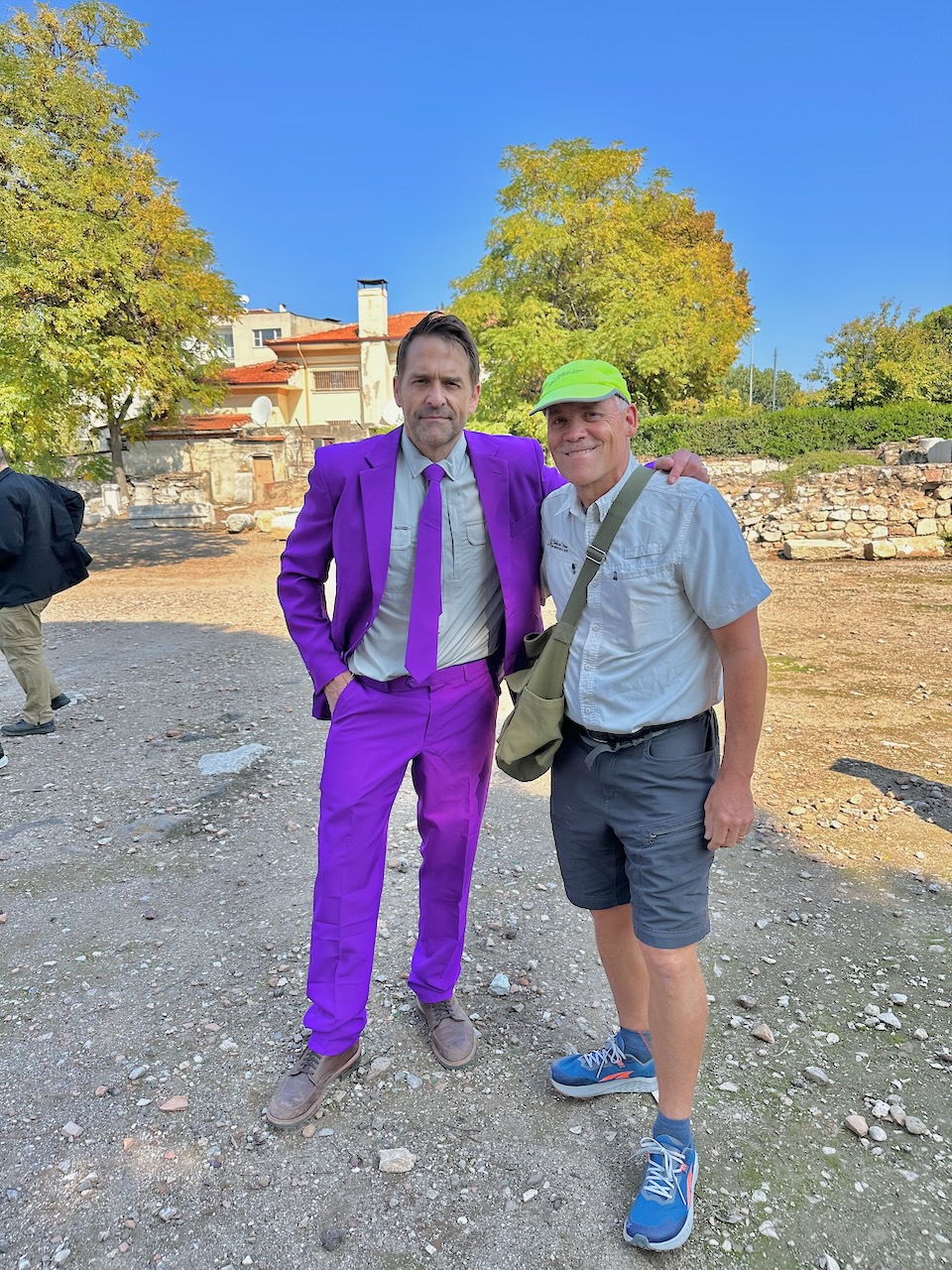
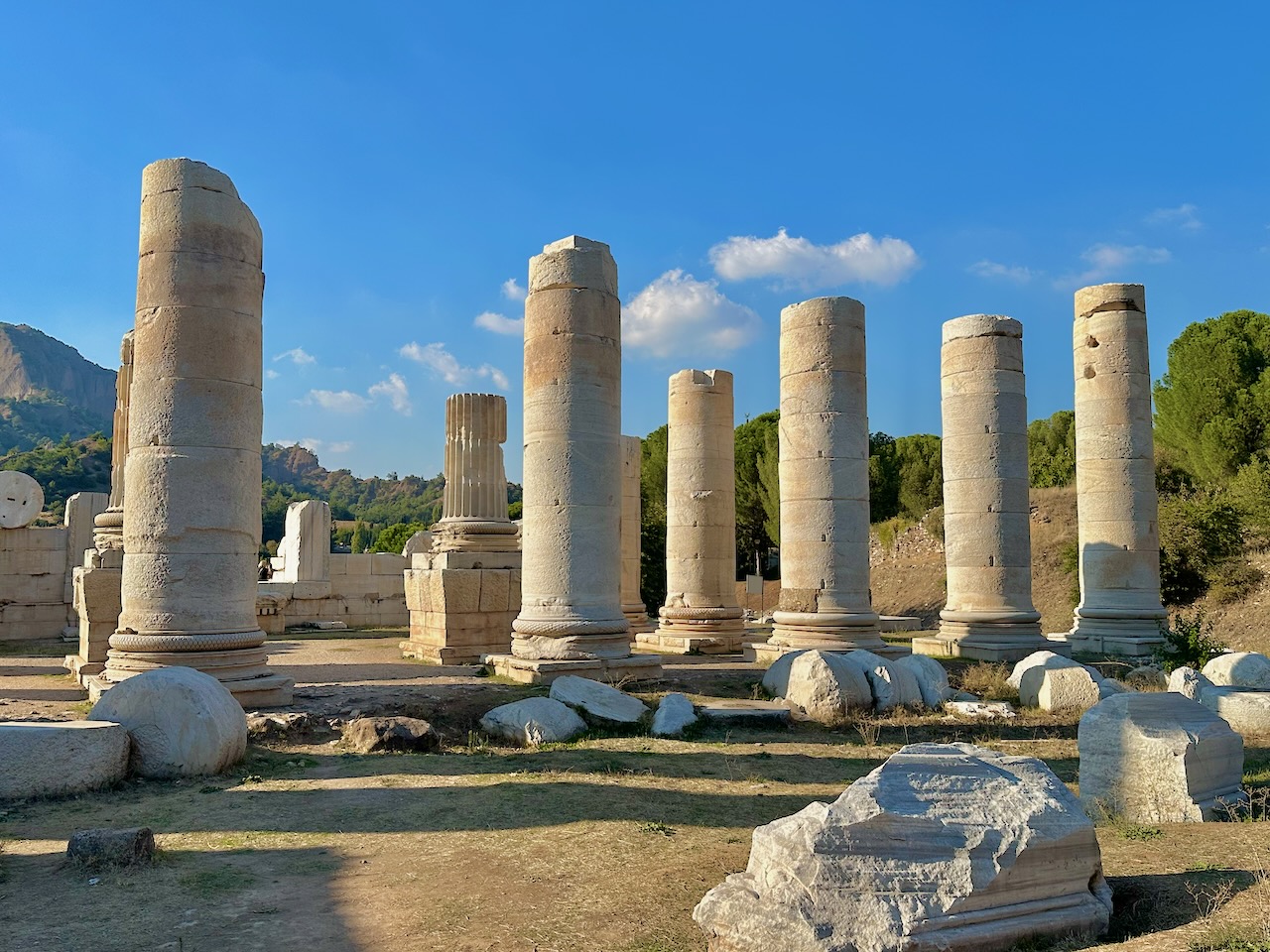
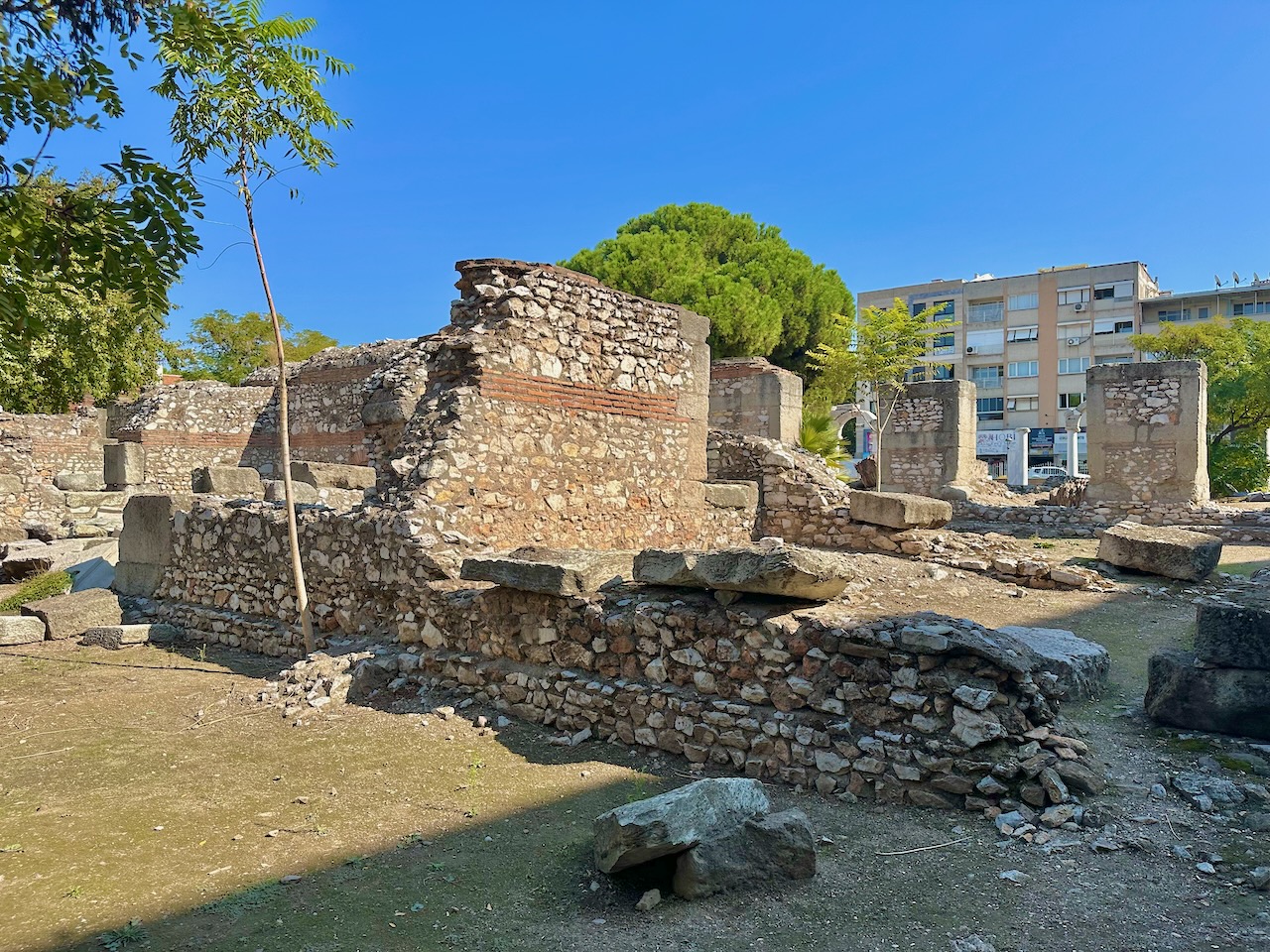
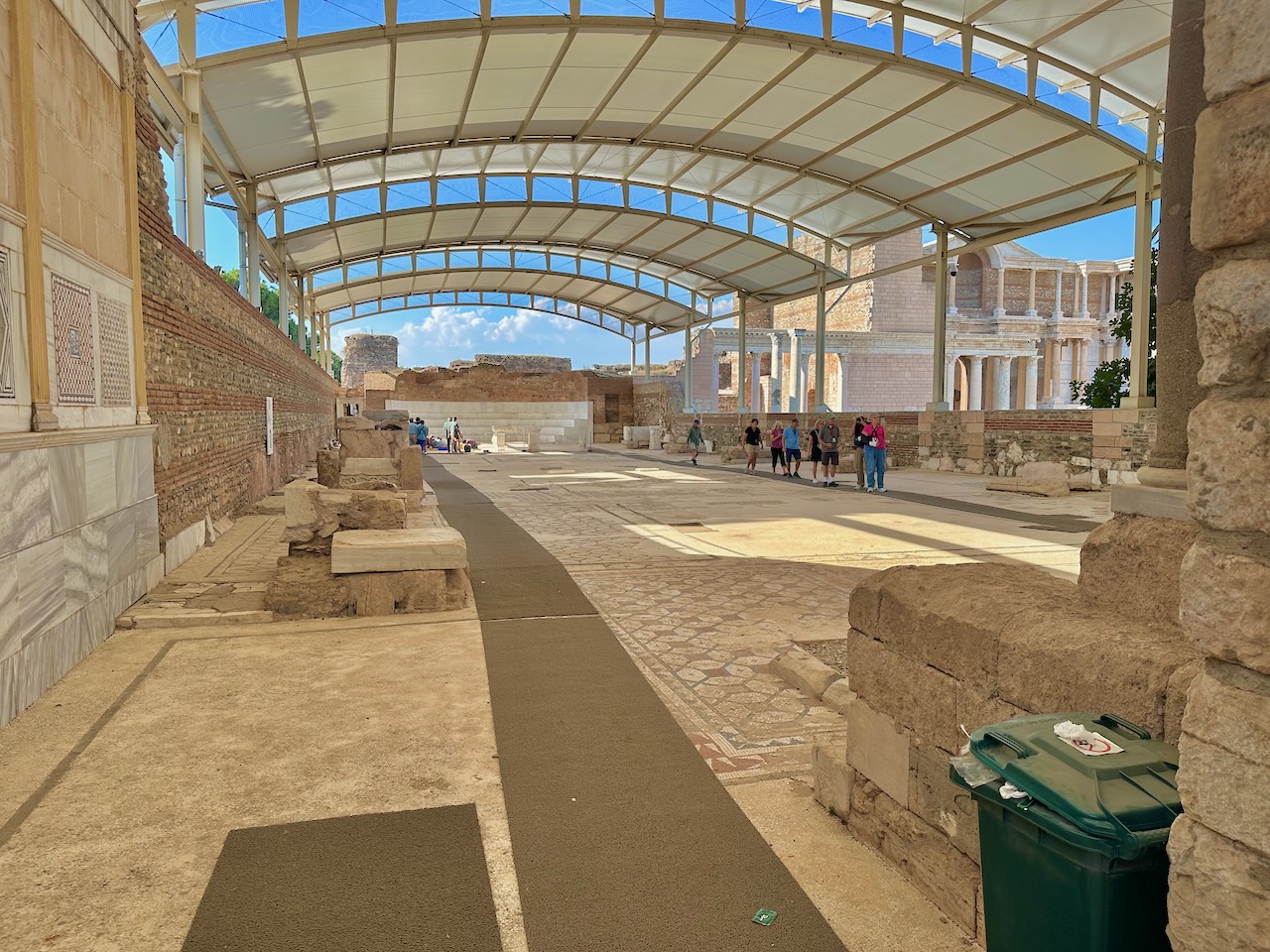

Day 13 – Thursday, October 16: Hierapolis, Laodicea, Colossae, Kusadasi
Today was our third day here in Turkey. The weather was perfect again, with a cloudless blue skies, a cool and crisp start in the morning, and highs in the low 70s. Today’s first two sites were enormous and quite incredible in every way. We read from Colossians 4 that mentions both Laodicea and Hierapolos.
Hierapolis
We left the hotel this morning at 7:45 a.m. and drove straight to Hierapolis (Pamukkale). We spent almost two hours at this large site, and saw a lot of the ruins. The site itself spans about 2.5 miles. We first walked into the site to the area of the white calcium/lime deposits caused by the hot springs. Some of us enjoyed sticking our feet into the hot channel of water. On our own we then walked through the rest of the site. Many in the group hiked up to the “traditional” Tomb of Philip (dating to the 5th-6th century) and one of the most intact and complete theaters in the Roman world. It even incudes the scainea, the back section that extended high above the stage and orchestra area.
Laodicea
Across the valley is Laodicea, another equally-huge archaeological site. The city was named after the wife of the Seleucid rule named Antiochus II. In the days of the NT, the city was known for its eye salve and the production of textile/cloth that was black in color. We saw many things here, including many Byzantine churches (one from an earlier period – 2nd century AD), a large Temple (from an earlier period) dedicated to Aphrodite, Artemis, and Zeus. The two theaters (on the north and west) were built on the steep slopes of the site. The Hellenistic theater has been excavated while the Roman one has not. The city also had a few marketplaces (agoras) and a stadium not yet excavated. Lastly, Laodicea had two elaborate water distribution centers. It brought cold water from the snow-capped mountains and the river that flowed through Colosae, and the hot water from the other direction from Hierapolis. This church was criticized for being “lukewarm.” We read from Revelation 3:14-22 inside one of the Byzantine churches.
Colosea
After another very nice Turkish lunch, we drove to Colosea. Located on the slopes of the mountain range 20 minute drive from Laodicea, this is an un-excavated site (although preparations are underway to begin digging here in 2026!) Colosea served as a home of Epaphras who was imprisoned with Paul in Rome in the early 60s AD when Paul wrote a letter to the church here. While Paul passed through this region on his mission journeys, we cannot be certain Paul was actually in Colosse. “For I want you to know what a great conflict I have for you and those in Laodicea, and for as many as have not seen my face in the flesh” (Colossians 2:1). On the other hand, Paul mentions to Philemon to prepare a guest room for him here (Philemon 1:22). Many in the group climbed to the top of the site. The view from the top of the site was very good.
Kusadasi
To end the day, the drive west to Kusadasi took about 3 hours. This is a beautiful part city on the Aegean Sea. After we arrived at our hotel, we enjoyed dinner. Following dinner, some in the group enjoyed walking around and experiencing the local Turkish culture here in Kusadasi.
Tomorrow is our last complete day here in Turkey.
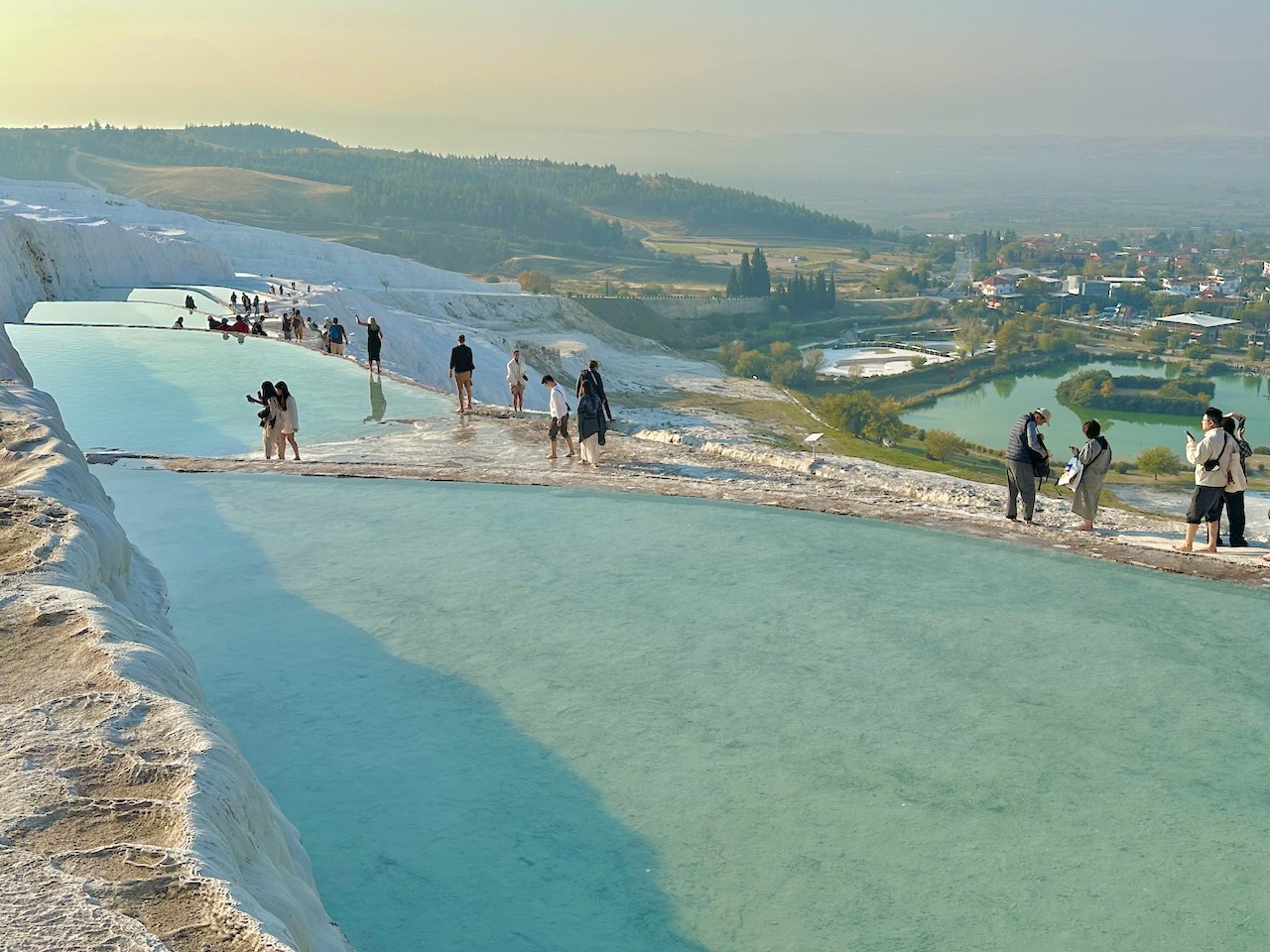
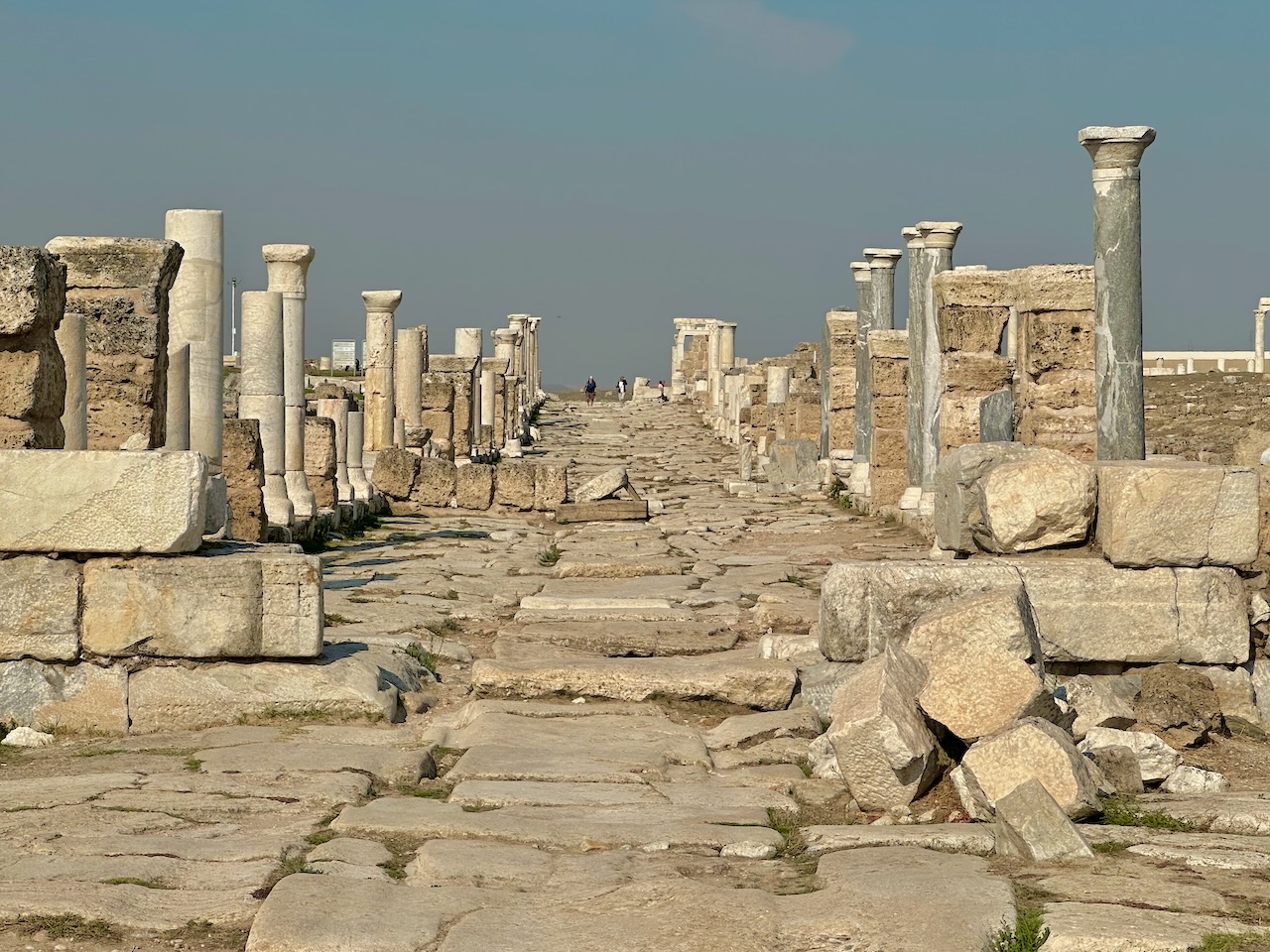
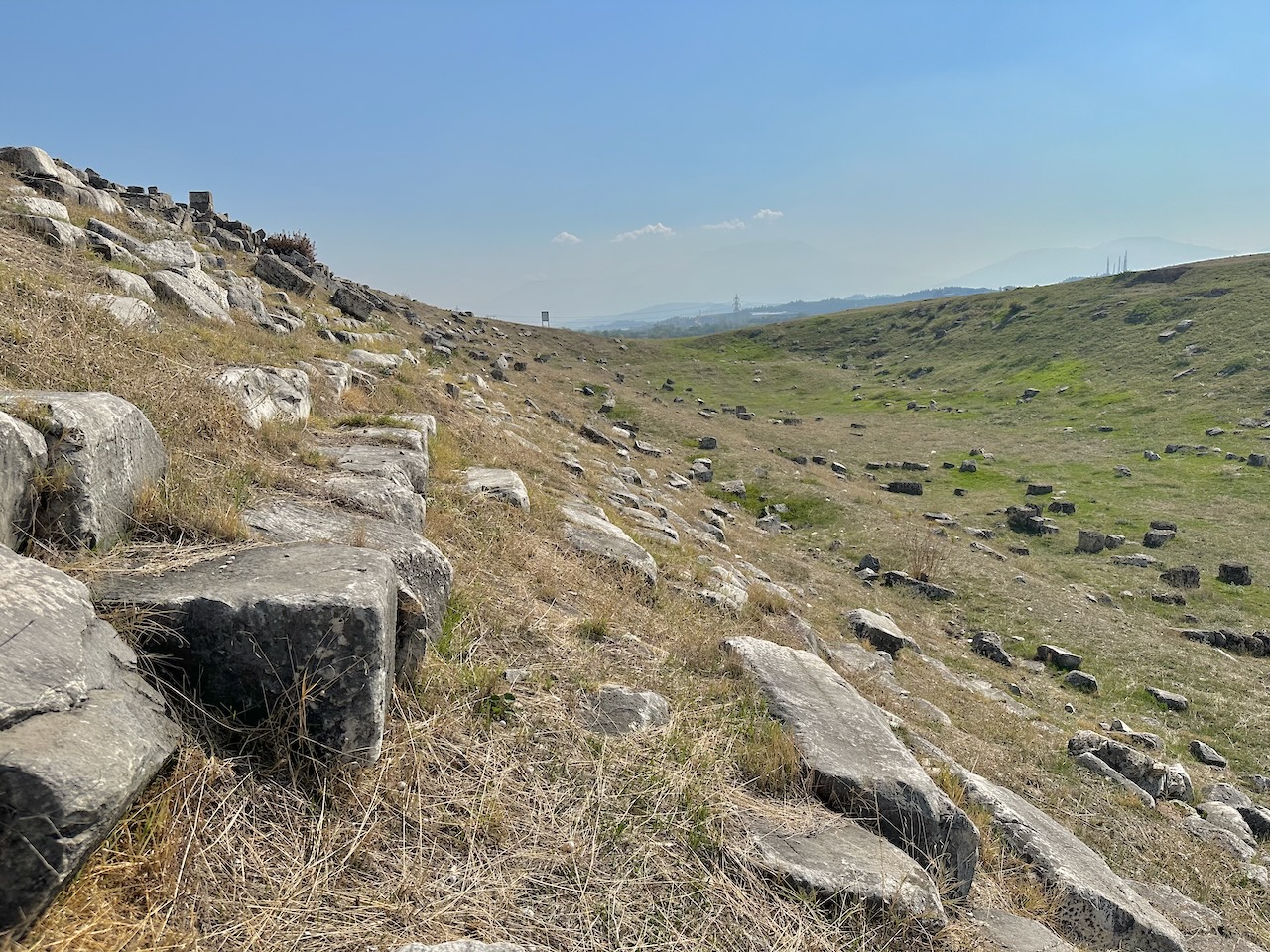
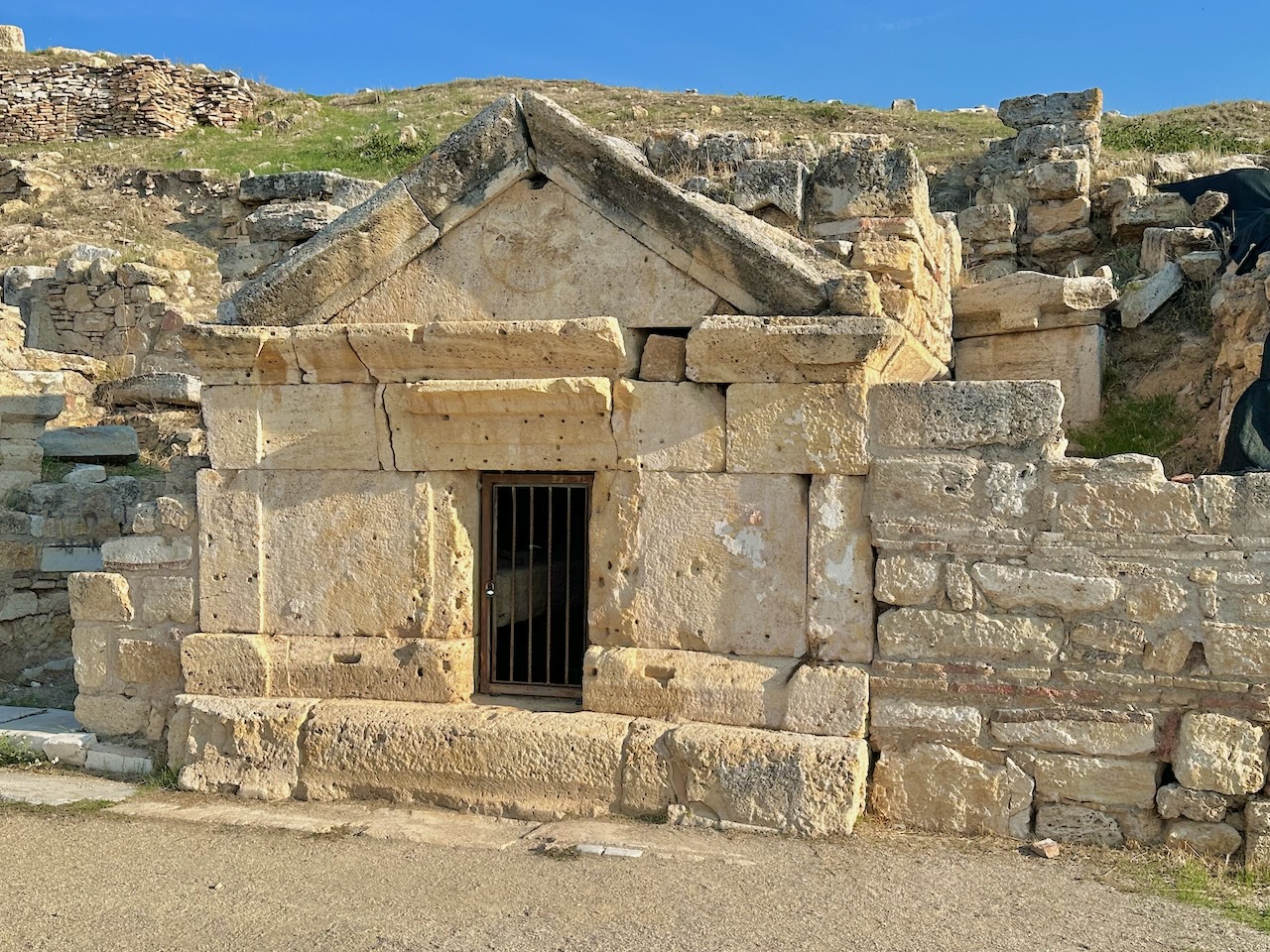
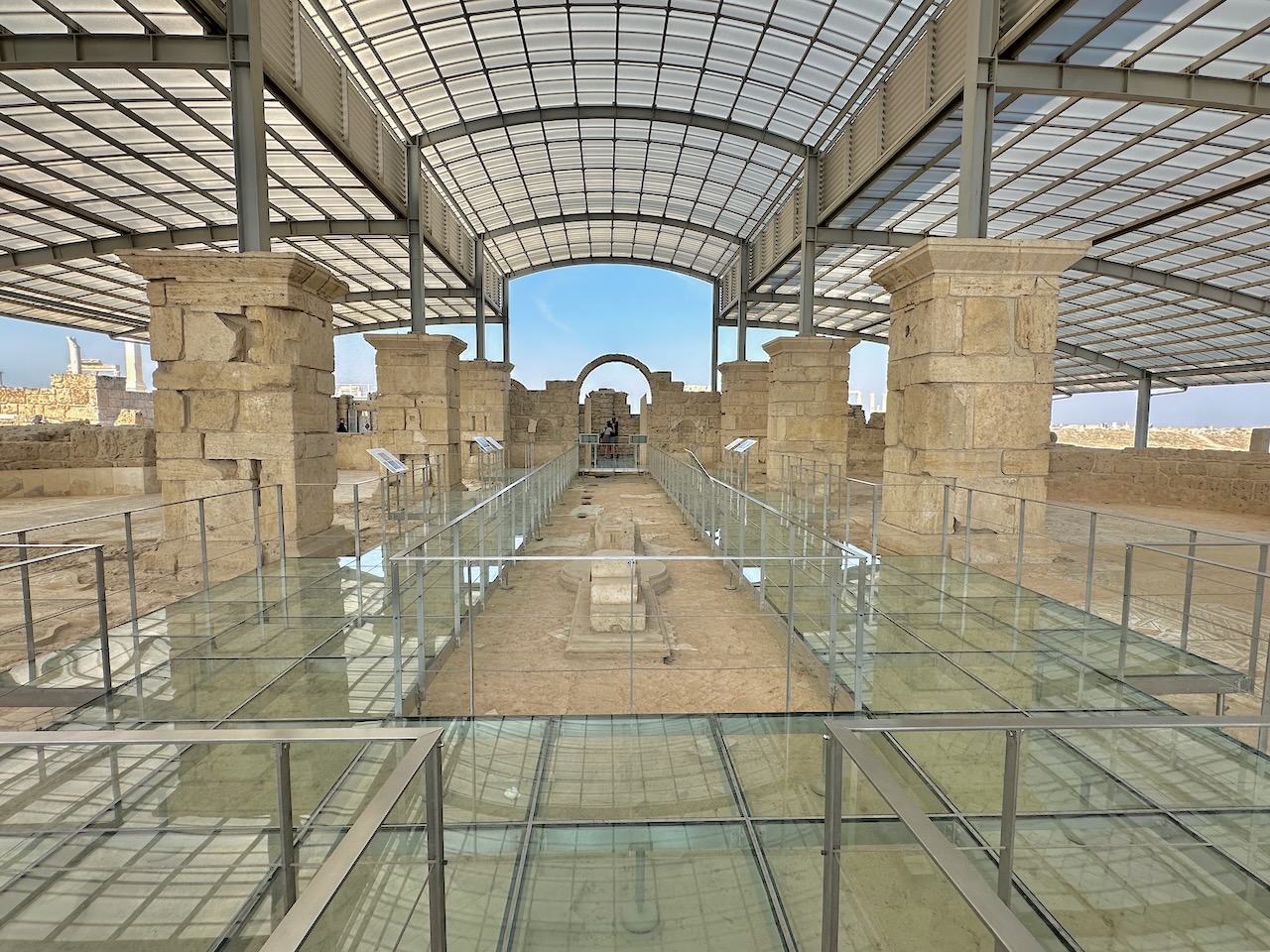
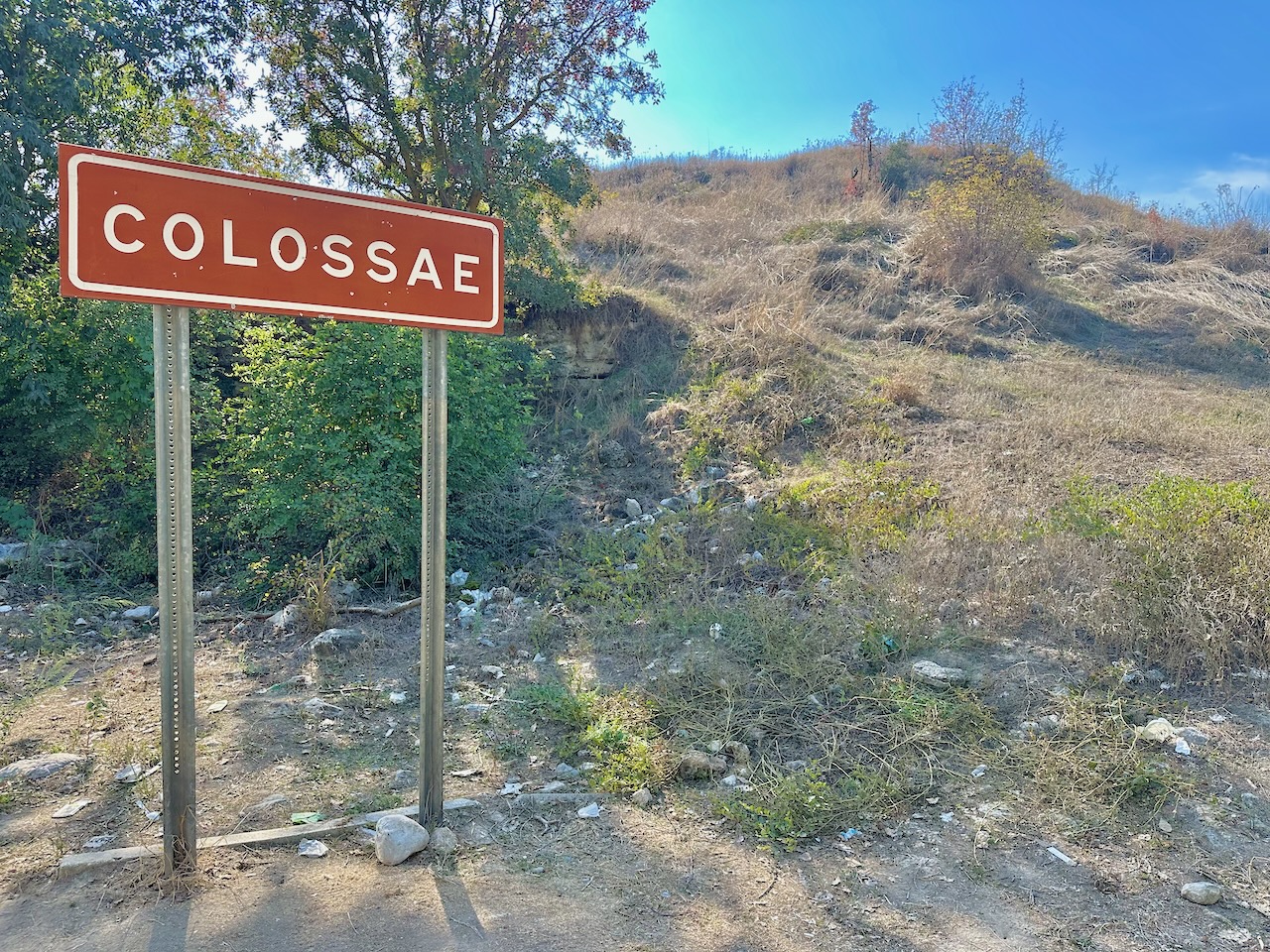
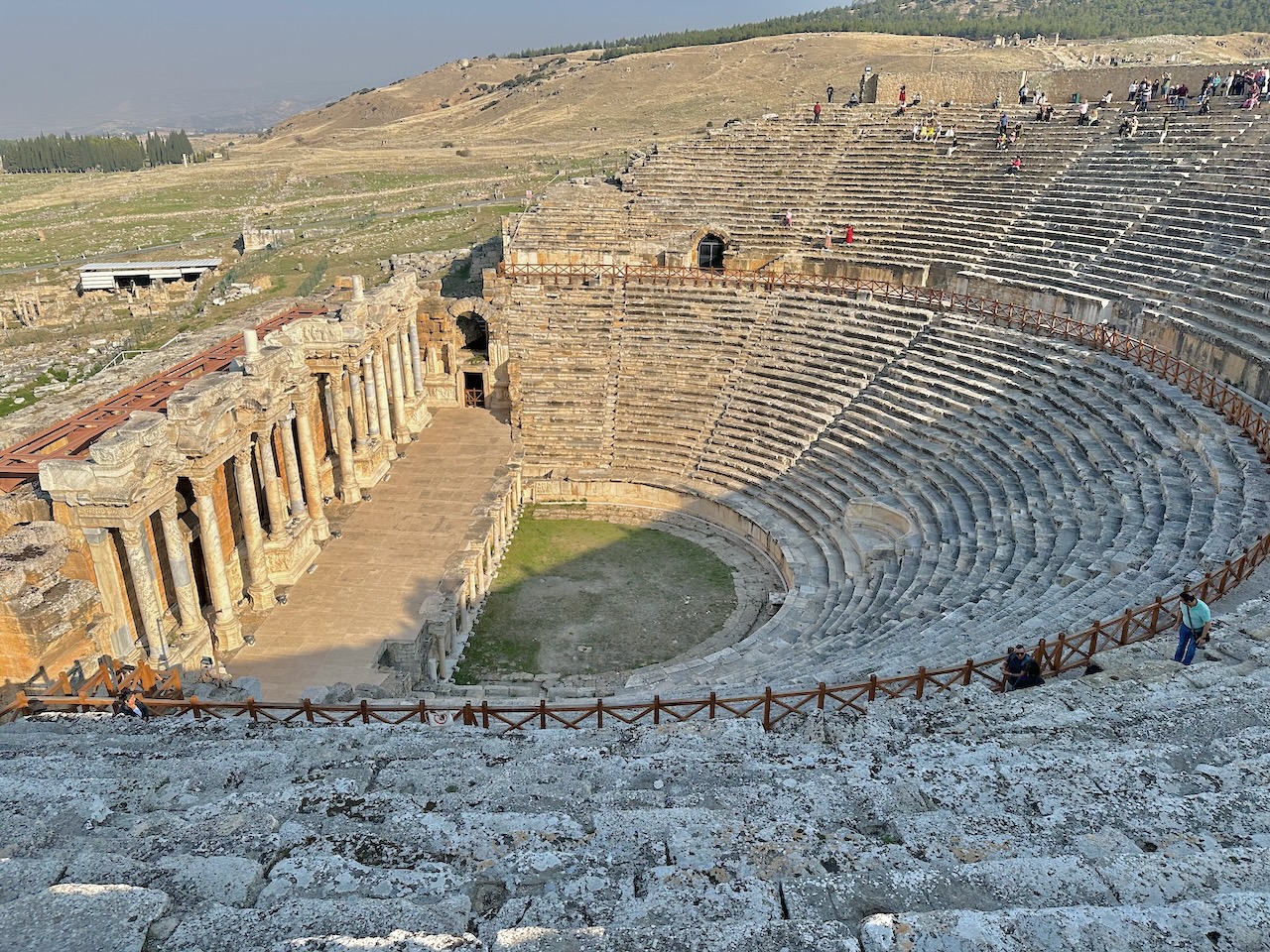
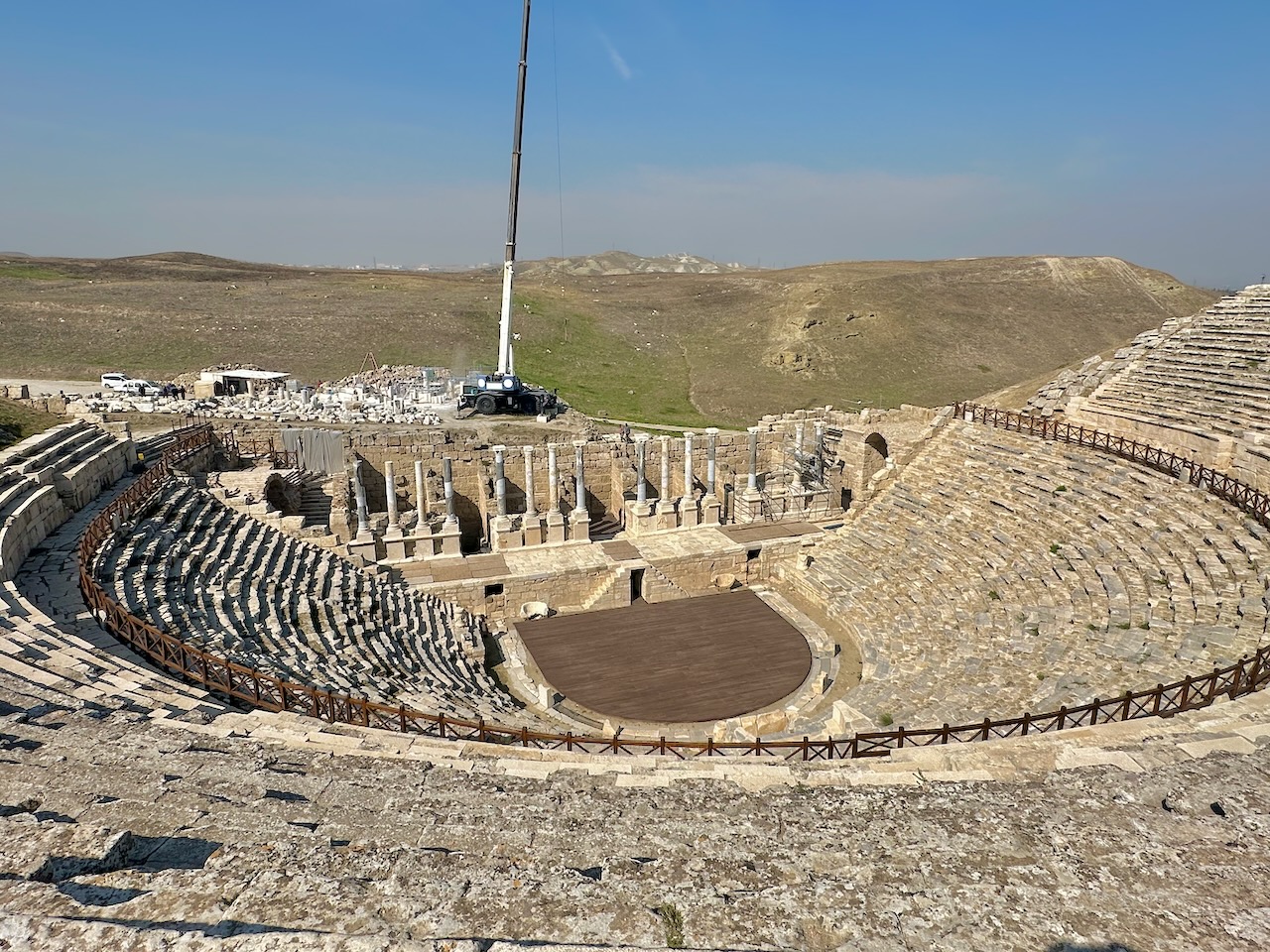
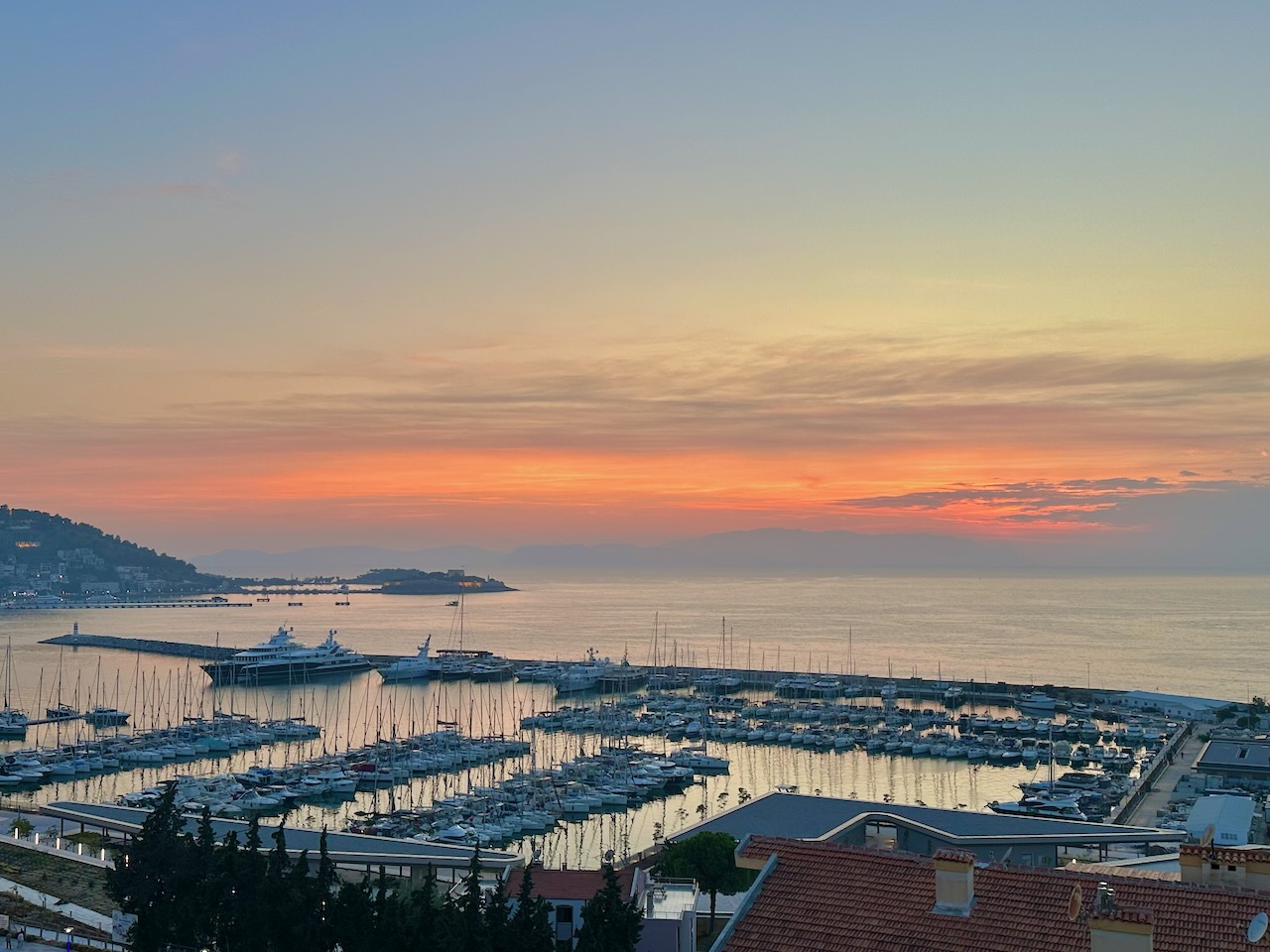
Day 14 – Friday, October 17: Miletus, Izmir-Istanbul
Today was our last day here in Turkey, and the last day of our Greece & Turkey tour. Our morning started at 8:30 a.m. when we loaded the bus and drove south to visit Miletus before flying to Istanbul later this afternoon. The weather was once again ideal, with full sun and highs in the 70s. We read from the first part of Acts 20 as we left the hotel. We also sang our “song” for the last time.
Miletus
We drove about 35 miles south of Kusadasi to Miletus. The last 10 miles or so was flat farmland with many cotton fields. In Paul’s day this was all under water (the Aegean Sea). The most impressive thing at this site is the theater originally built in the Hellenistic Period. It was later expanded to hold about 10,000 people. Some of the marble “reserve seats” had Greek inscriptions. We read from Acts 20:15-38. Paul met the elders of Ephesus here en route to his travels to Jerusalem at the end of his third mission journey. It was a tender and emotional “farewell” for Paul and his friends from Ephesus.
Izmir – Istanbul
In the late morning, we drove back north to Izmir to catch our flight to Istanbul. We purchased snacks at a highway gas station (where a Turkish woman was also making potato pancakes!) before being dropped off at the Izmir Airport for our flight to Istanbul. We arrived in Istanbul later in the afternoon. Our agent and bus driver met us at the airport, escorting us to the hotel for a later dinner. Most in the group fly home tomorrow at various times.
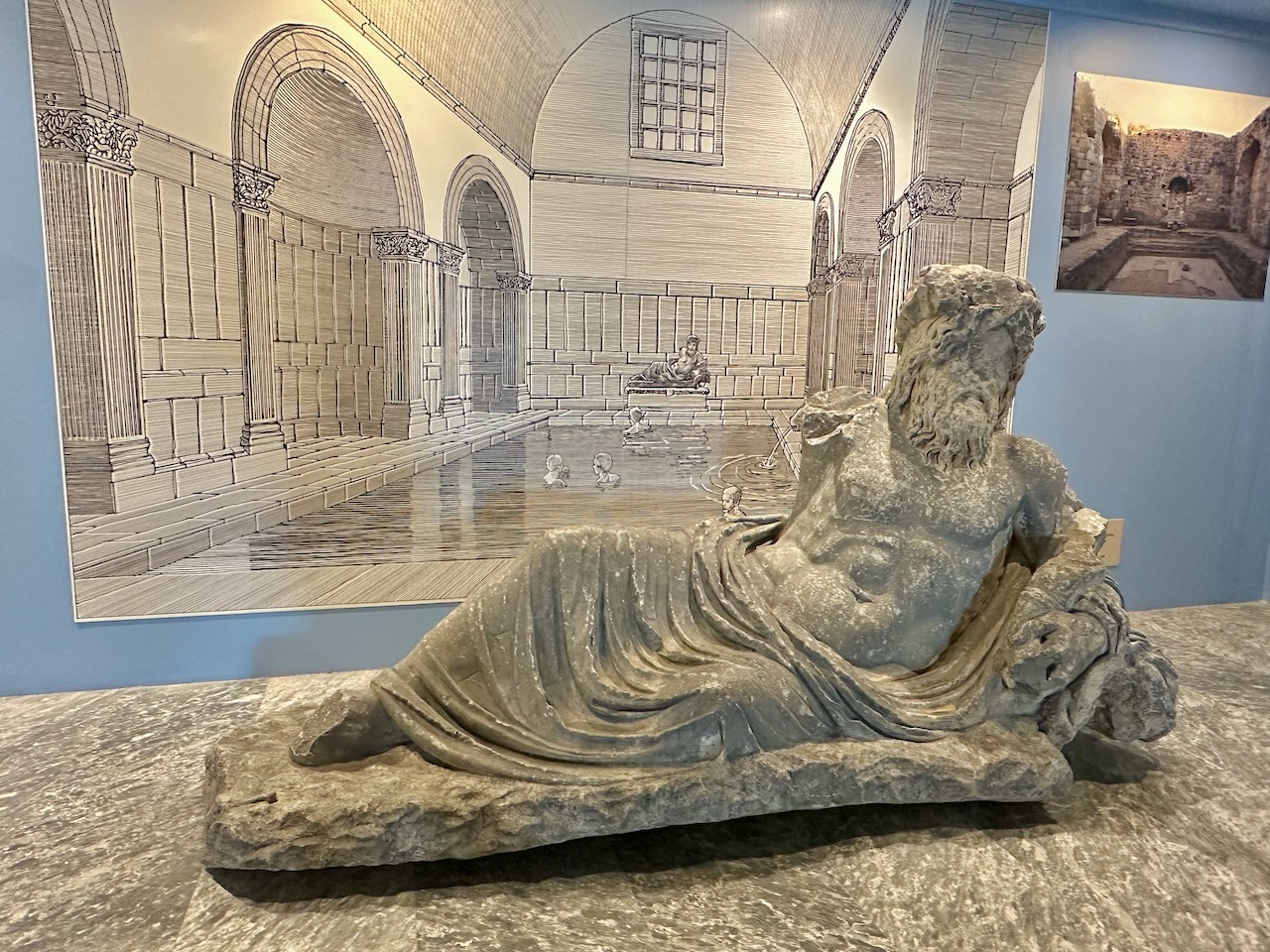
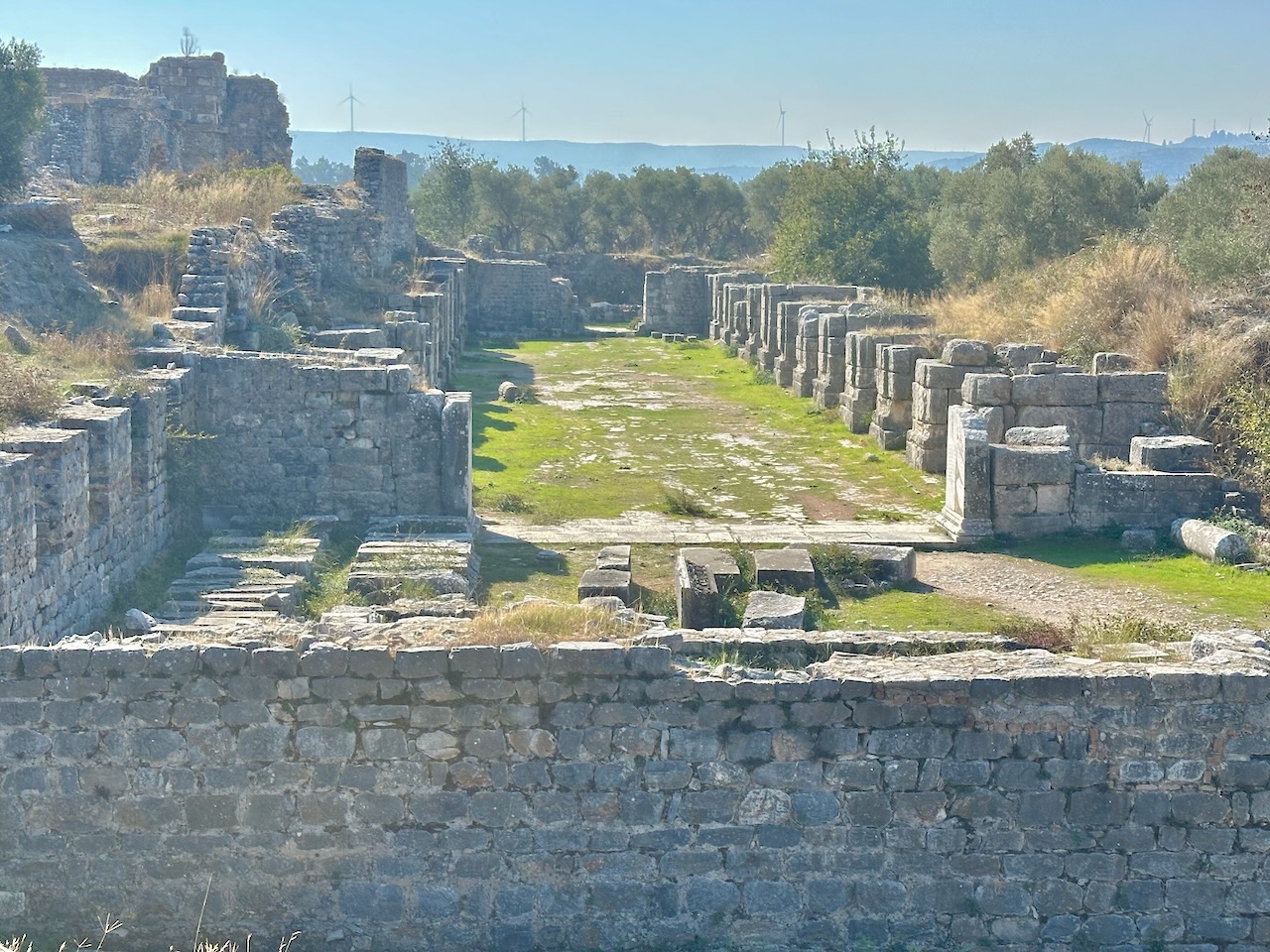
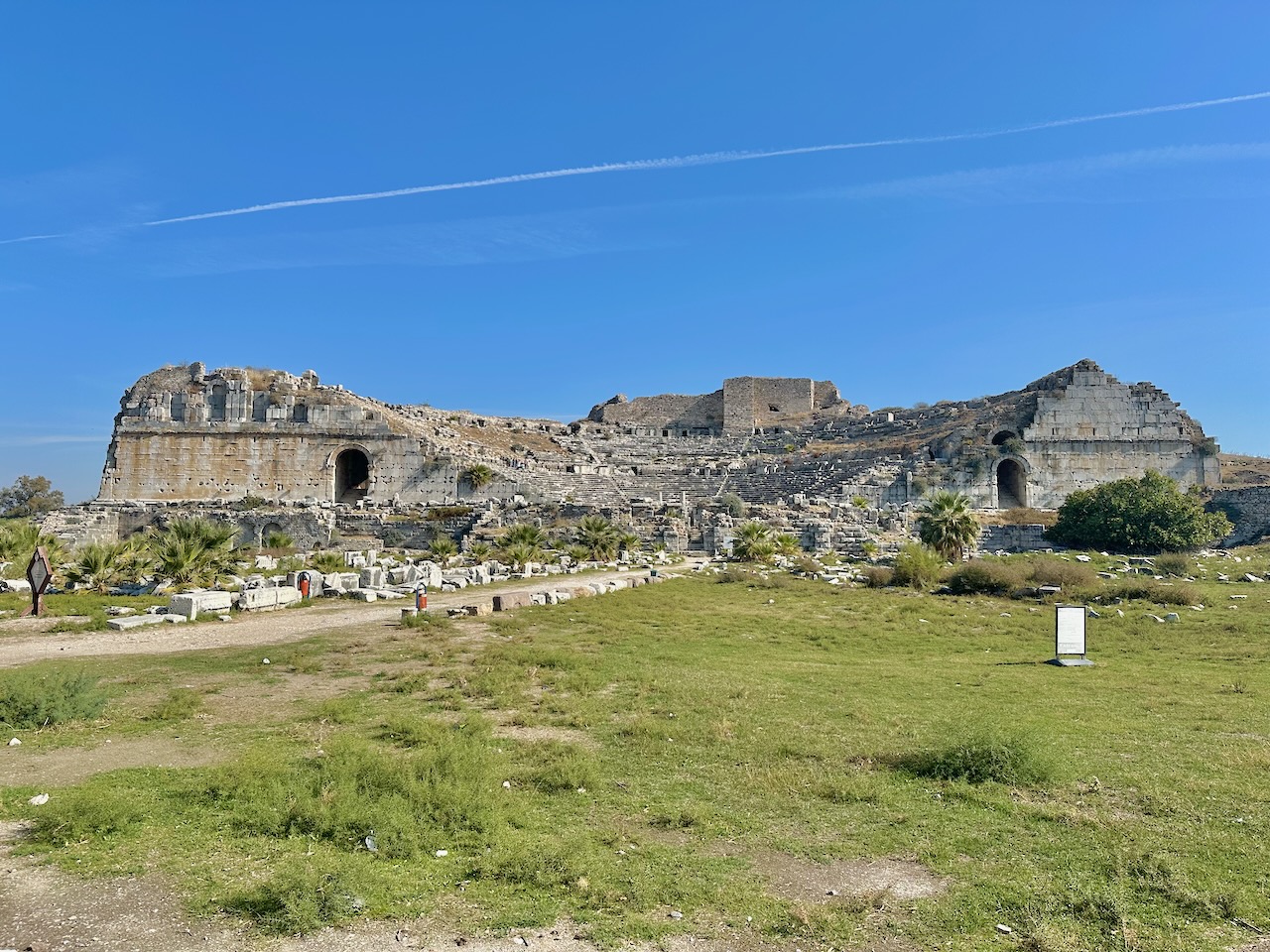
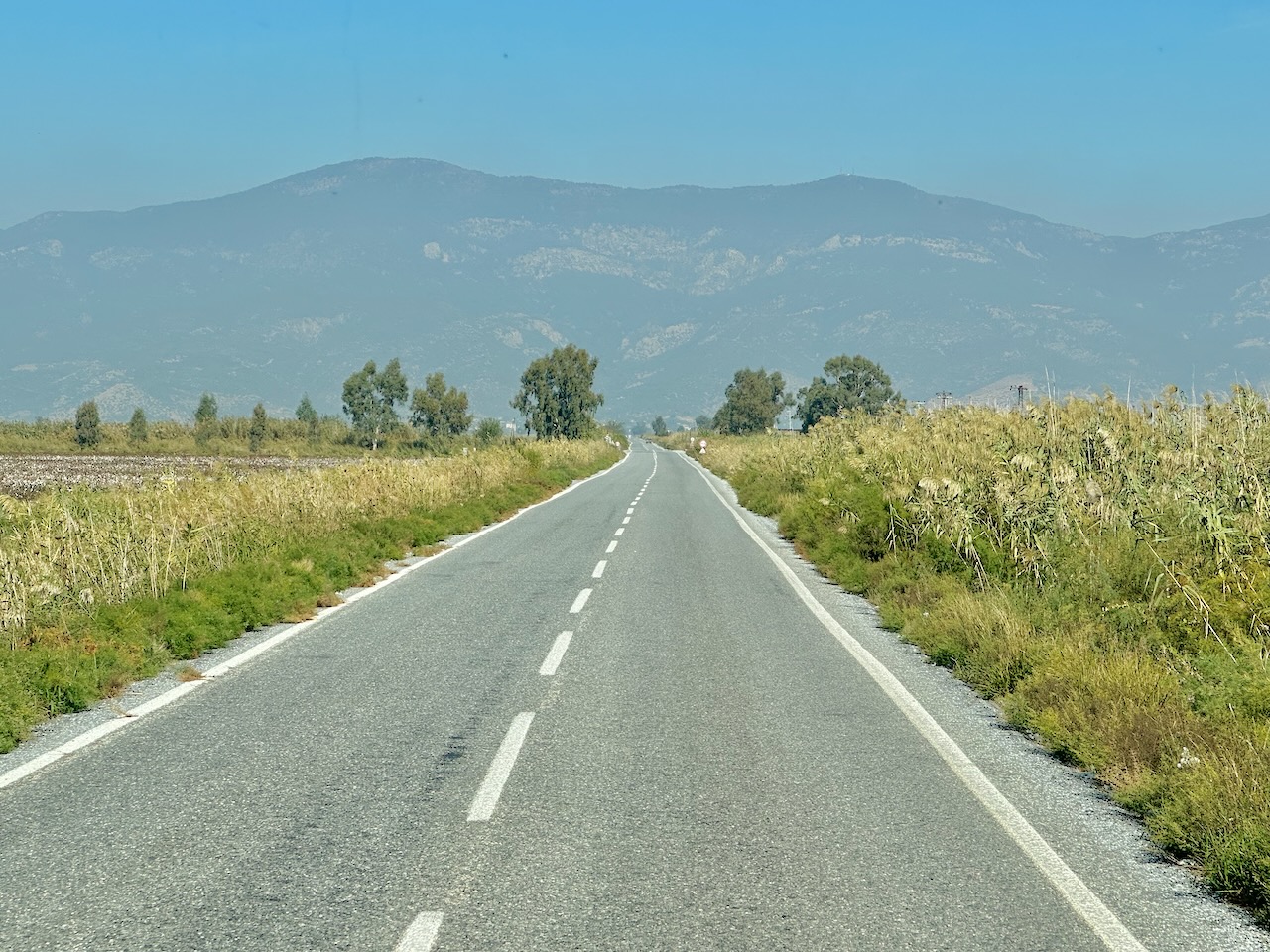
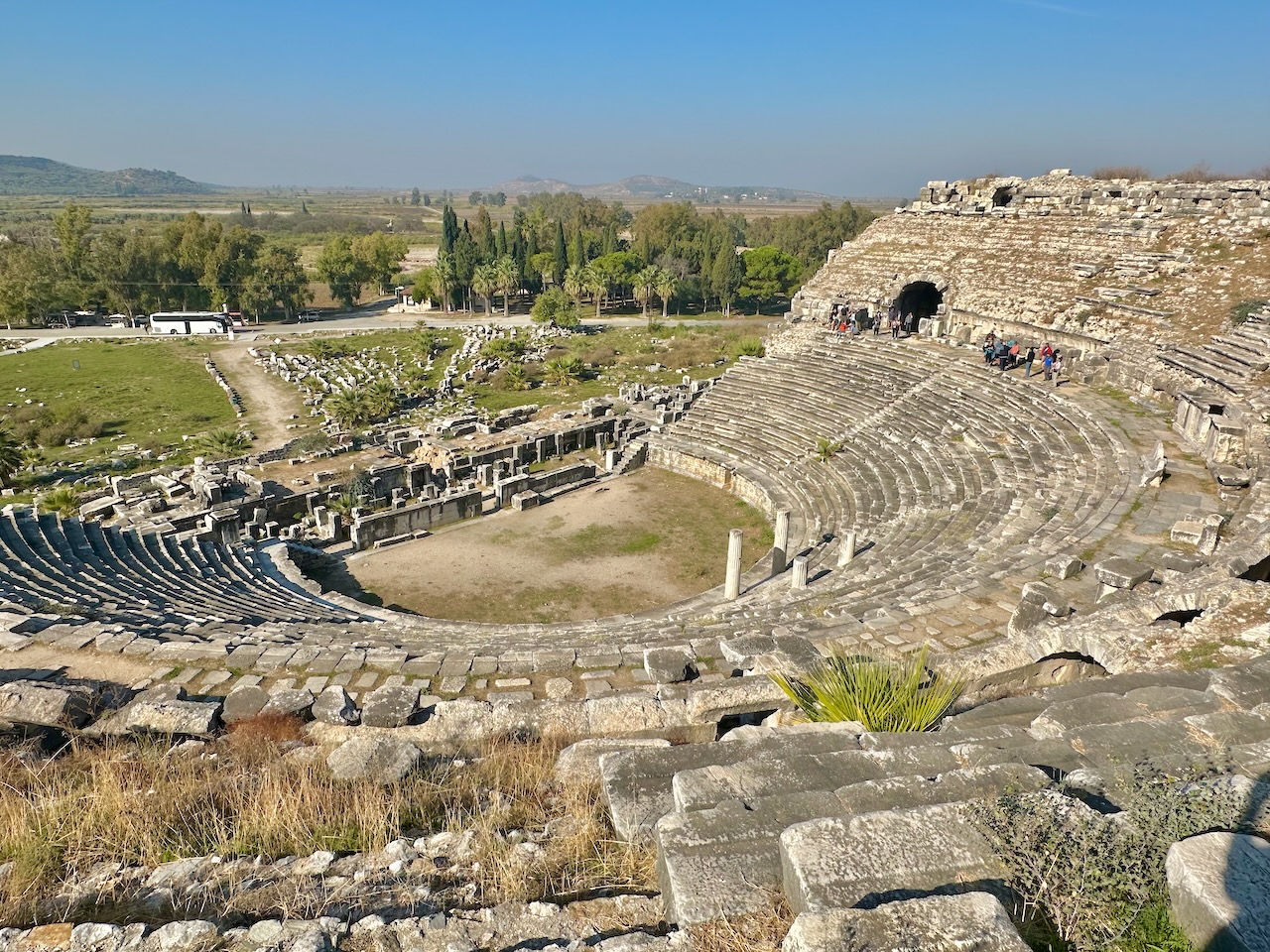

Day 15 – Saturday, October 18: Istanbul, Return to U.S.A.
At various times of the morning, most in the group will be transferring to Istanbul Airport for our return flight back to the U.S.A.
Mars Hill – Athens
Dr. John shares a live devotional video from Mars Hill. Also called the Rock of Areopagus, this was where Paul shared his bold testimony among the philosophers of the day (Acts 17). Mars Hill is located just below the Acropolis of Athens.
